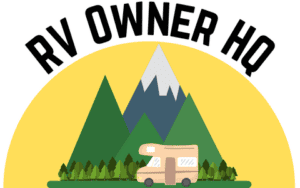

36 Essential RV Travel Tips Every RVer Needs to Know
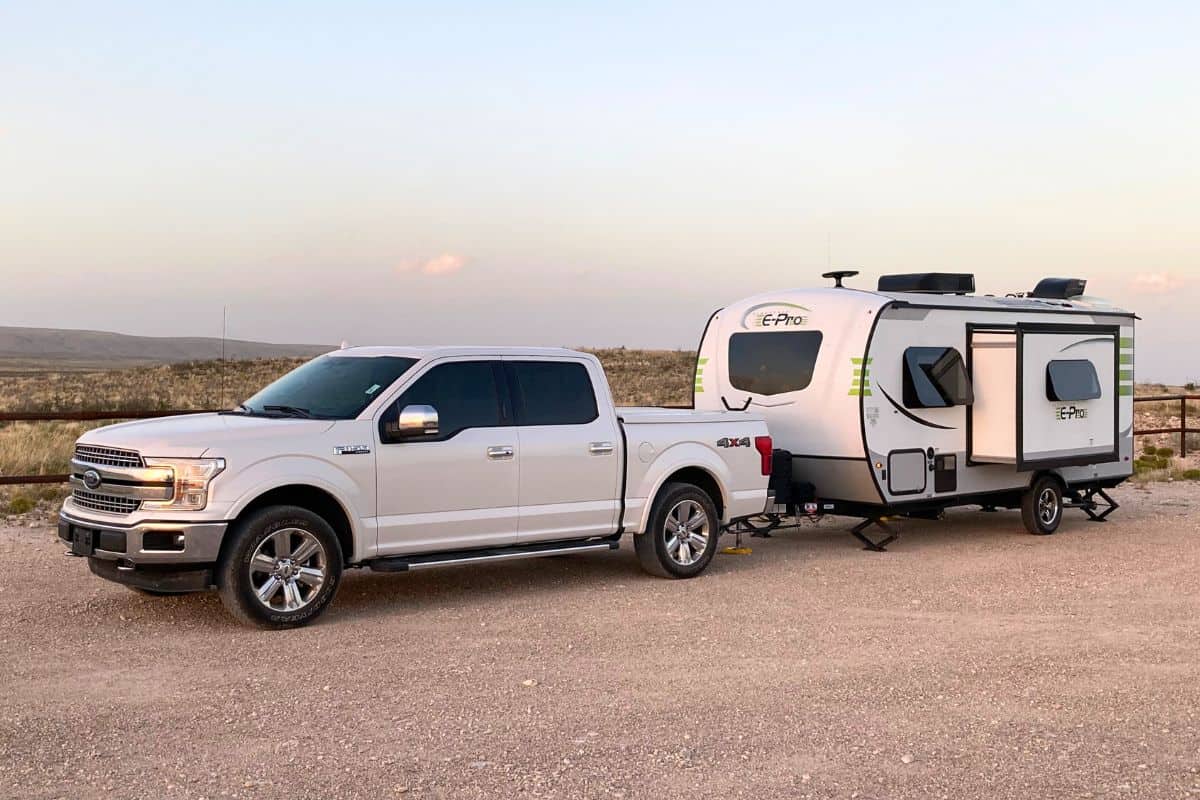
Are you ready to hit the open road in your RV?
Before you set off on your adventures, it’s crucial to have the right RV travel tips and RV accessories up your sleeve.
As a seasoned RVer, I’ve learned that preparation is key to ensuring a smooth and enjoyable trip.
In this comprehensive RV travel guide, we’ll dive into 36 must-know RV travel tips and hacks , covering everything from pre-trip planning to campground etiquette to making the most of your adventures with kids in tow.
Whether you’re an RV beginner or a seasoned veteran, these travel tips will help you make the most of your time on the road.
Pre-Trip RV Travel Tips
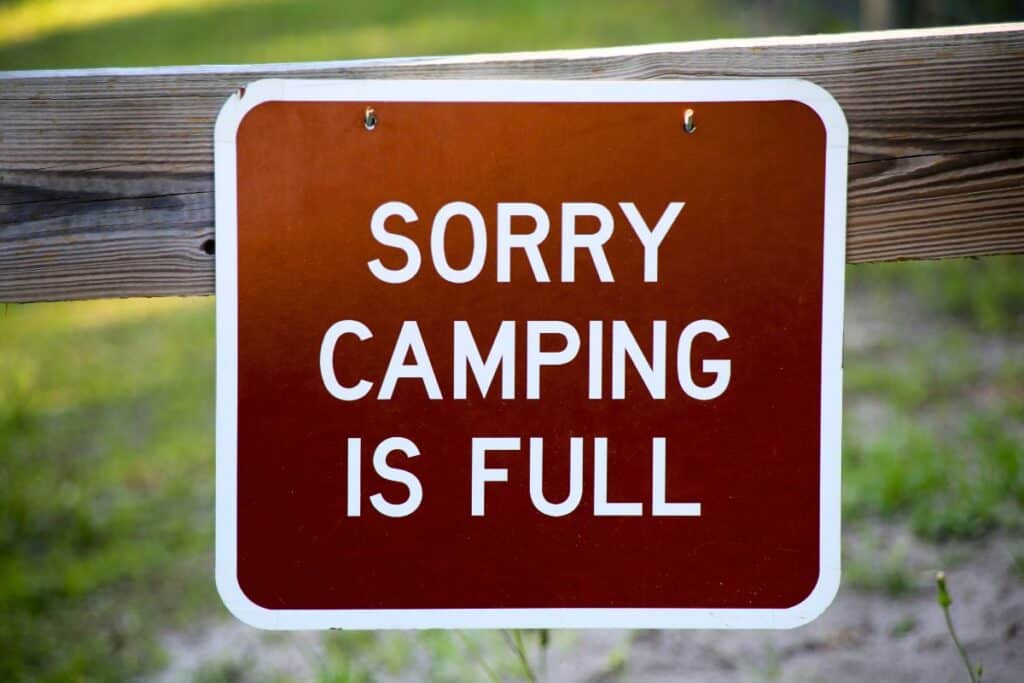
Before hitting the road, taking time to plan ahead is essential for a smooth and enjoyable journey.
From researching your destination to creating a comprehensive checklist and mapping out your route, these pre-trip RV travel tips will help you stay organized and prepared for anything that comes your way.
1. Research Your Destination: Scout it Out Before You Go
Before setting out on any RV adventure, it’s important to spend some time researching and planning your trip.
Things to research and check include campground amenities, reviews, and availability to ensure that your chosen location meets your needs.
Consider the weather and seasons when planning your trip, as some destinations may be more enjoyable during specific times of the year. (Also don’t just assume that everything is open year-round, as many destinations including up north or in the mountains close down for the winter season, which can extend into late fall and early spring.)
Also, don’t forget to look for nearby attractions and activities that align with your interests, such as hiking trails, fishing spots, or cultural landmarks.
2. Create & Use a Checklist: Tick-Tock, It’s Checklist O’Clock
Creating and using a comprehensive checklist is a must if you don’t forget anything.
List all the necessary food, medications, clothing, bedding, kitchenware, and toiletries you’ll need for your trip.
Remember to include RV-specific items like hoses , leveling blocks , and a tire pressure gauge.
Some RVers like to have different lists for each packing category, personally though, I find it easier to just have one master list to work from, so I have everything I need for the trip in one place.
Also, don’t forget to check that you have all your important travel documents, such as your ID, vehicle registration, insurance papers, and passport, if you plan on crossing a border before departing.
3. Plan Your Route: Map Your Adventure
Another important RV travel tip is to plan your route ahead of time, as this will help ensure a stress-free RV journey.
Utilize RV-specific GPS like this popular one on Amazon or route-planning apps to find the most suitable roads for your vehicle.
Take into account road conditions, tolls, and low clearances that may affect your travel.
Factor in fuel stops and rest areas along the way to ensure a comfortable and safe trip.
4. Make Reservations in Advance: Don’t Get Left Out in the Cold
RV travel and camping are more popular than ever, which makes reserving you’re campsite as early as possible more important than ever.
Popular campgrounds fill up quickly, as it’s not uncommon for national and even state parks to fill up months in advance, especially around major holidays, think Fourth of July, Labor Day, and Memorial Day.
So make sure to book your camping spots as early as possible to not only secure a site but also to snag one of the better campsites, personally, I always look for waterfront options.
Before making that reservation though, make sure you’re aware of the campground’s cancellation policies in case your plans change unexpectedly.
5. Check Weather Forecasts: Weather or Not
Before embarking on your RV trip, check the weather forecasts for your planned route and destination.
Being aware of potential adverse conditions like storms, extreme heat, or cold will help you prepare accordingly.
Pack appropriate clothing, gear, and emergency supplies based on the expected weather.
If severe weather is predicted, consider adjusting your travel plans to ensure the comfort and safety of you and your passengers.
RV Travel Tips (Maintenance & Safety)
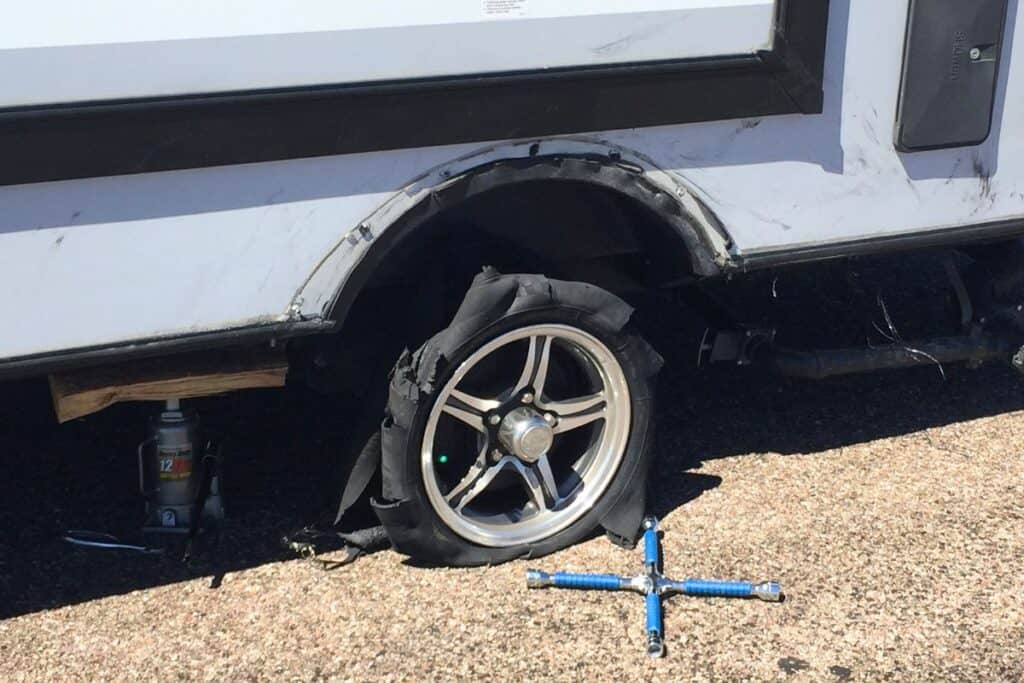
Making sure your RV is in tip-top shape and prioritizing safety are crucial aspects of any successful RV road trip.
In this section, we’ll cover essential maintenance and safety RV travel tips that every RVer should know.
6. Perform Regular Maintenance Checks: Fix It Before It Fails
Performing regular maintenance checks is a must to keep your RV in good working condition and prevent unexpected breakdowns.
Before each trip, take the time to check your fluids and batteries to ensure they are at the proper levels.
Inspect belts, hoses, and filters regularly for signs of wear or damage, and replace them as needed.
It’s also important to perform regular inspections of the RV roof and slide-outs, paying close attention to seals and caulk to ensure the camper is watertight, as it’s always easier to fix a compromised seal or caulk with home court advantage.
I’ve found keeping all these RV maintenance tasks and inspections in my head challenging, because of this, I keep an RV maintenance log and schedule to help me stay on top of it all.
7. Check Tire Pressure & Tread: Tread Wisely
Maintaining proper tire pressure and tread depth is critical for the safety and performance of your RV.
Regularly check your tire pressure using a reliable tire gauge like this popular one on Amazon that doesn’t require batteries , and inflate tires to the manufacturer’s recommended level.
Inspect your tires for signs of uneven wear, damage, or objects lodged in the tread.
Replace tires when the tread depth reaches the minimum safe level, the U.S. Department of Transportation recommends replacing tires when they reach 2/32″ . A common way to check this is to place a penny facing down inside the tire’s tread, if you can see the top of Lincon’s head, it’s probably time to replace your tires.
8. Know Your RV’s Dimensions & Weights: Size It Up
Knowing your RV’s dimensions and weights is critical for safe and legal travel.
RV Lengths & Weights You Should Know:
- Overall RV Length (With and Without the Tow Vehicle)
- Fully Loaded Weight
- Cargo Carrying Capacity
- Gross Vehicle Weight Rating
It’s important to be aware of height, length, and width restrictions on the routes you plan to take, as some roads, bridges, and tunnels may have limitations that could impact your RV.
It’s also important to ensure that your RV is not overloaded, as this can cause safety issues and put undue stress on your vehicle’s components.
Make sure to distribute weight evenly throughout your RV for better handling and stability on the road.
9. Practice Safe Driving: Drive Smart
Driving or towing an RV, while manageable for most drivers with a little practice, requires a different skillset, careful attention to detail, and extra caution, due to the longer length and extra weight.
So before heading out, it’s important to familiarize yourself with your RV’s size, weight, and handling characteristics.
Take the time to practice driving or towing your RV in a safe, open area to gain confidence and develop a feel for its unique dynamics.
Adjust your driving speed to accommodate your RV’s size and the road conditions, as larger vehicles require more time to accelerate, brake, and turn.
Allow extra space for turning and stopping, and be mindful of your RV’s tail swing when maneuvering in tight spaces.
Use extra caution in high winds and mountainous terrain, as these conditions can affect your RV’s stability and handling substantially.
It’s also really important to maintain a safe following distance and be mindful of your RV’s height when navigating underpasses or low-hanging branches.
10. Install & Properly Maintain Safety Devices: Staying Safe on the Road
Installing and maintaining safety devices in your RV can provide peace of mind and protect you and your family.
Equip your RV with smoke detectors, carbon monoxide detectors, and fire extinguishers, and check them regularly to ensure they’re in good working order.
Also make sure the camper has proper ventilation to prevent gas leaks and buildup, which can be dangerous in confined spaces.
Plus, it’s also a good idea to add a backup camera and tire pressure monitoring system for added safety and convenience, if you’re RV didn’t come with those features standard, which most don’t.
- See the best affordable RV backup camera system I’ve found, which is the AMTIFO Wireless Backup Camera.
- See the best affordable tire monitoring system I’ve found, which is the Tymate RV Tire Pressure Monitoring System
11. Have an RV Tool Kit: Ready, Set, Repair
Having a well-stocked RV tool kit on hand can be a lifesaver in case of unexpected repairs or maintenance needs.
Include essentials like a jack, lug wrench, pliers, screwdrivers, wrenches, and a multimeter.
Don’t forget to pack spare fuses, light bulbs, and batteries, as well as duct tape, zip ties, and a can of WD-40 for quick fixes.
Having these tools readily available can help you tackle minor issues and avoid costly roadside assistance calls.
If you’re starting from scratch, this basic tool kit from DEKOPRO on Amazon is a great place to start.
12. RV Appliance Check: Keep It Cooking
Before setting out on your trip, conduct a thorough check of all your RV’s appliances to ensure they are functioning properly.
Test your refrigerator, stove, oven, microwave, and air conditioning unit, and address any issues or malfunctions before hitting the road.
Also, make sure your water heater, pump, and tanks are in good working order, and familiarize yourself with the operation of your RV’s generator, if your camper has one.
13. Have Emergency Plans: Better Safe than Sorry
Having emergency plans in place before an emergency can help you navigate unexpected situations with confidence and minimize potential risks or danger.
Create a communication plan that includes emergency contact information for family members, friends, and roadside assistance services.
Develop an evacuation plan that outlines escape routes and designated meeting points in case of fire, severe weather, or other emergencies.
Familiarize yourself with basic first aid procedures and pack a well-stocked first aid kit tailored to your family’s needs.
14. Invest in an Emergency Beacon: Safety Signal
Investing in an emergency beacon can provide an added layer of safety and peace of mind, especially when traveling in remote areas or off-grid locations with no cell service.
Emergency beacons, such as personal locator beacons (PLBs) or satellite messengers, allow you to send distress signals and communicate your location to emergency responders in case of an emergency situation.
If you do choose to invest in an emergency beacon be aware that most require a monthly subscription plan for service.
It’s also important to make sure to familiarize yourself with the device’s operation and regularly test and maintain it to ensure it’s ready when you need it most.
Campground Etiquette & Setup RV Travel Tips
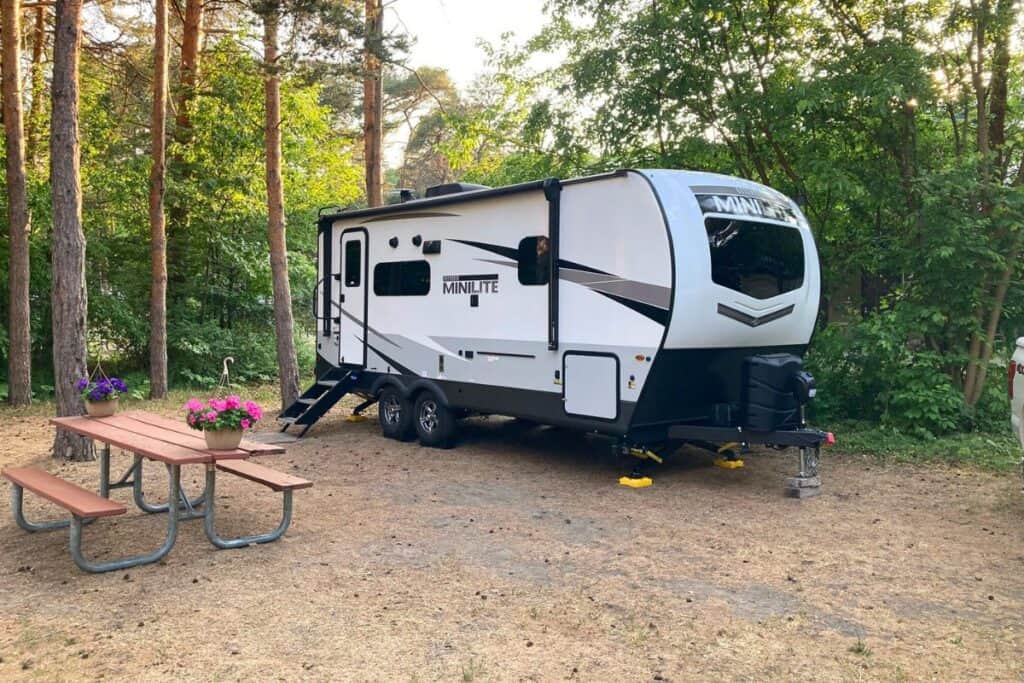
When arriving at a campground, be mindful of your surroundings and fellow campers.
Practicing good campground etiquette and following proper setup procedures can help ensure a pleasant experience for you and everyone around you.
15. Follow Campground Rules: Don’t Be a Rule Breaker
When staying at a campground, make sure to familiarize yourself with and follow the established rules to ensure a harmonious experience for everyone.
Respect quiet hours and noise levels, which are typically posted at the campground entrance or office.
Keep in mind that sound can travel easily in outdoor settings, so be mindful of your volume, especially during early morning or late evening hours.
If you’re traveling with pets, adhere to the campground’s pet policies, which may include leash requirements, designated pet areas, and waste disposal guidelines.
Lastly, avoid cutting through other campsites as a shortcut, as this can be seen as disrespectful and an invasion of privacy.
16. Practice Good Neighbor Habits: Campground Manners
Practicing good neighbor habits goes a long way in creating a positive campground atmosphere.
Keep your campsite tidy and clean by properly disposing of trash, storing food and supplies, and keeping your area free of clutter.
Be friendly and respectful to fellow campers.
If you notice a neighbor in need of assistance, such as helping with setting up equipment or providing a tool they may have forgotten, it’s always nice to offer your help.
However, it’s also important to always respect others’ privacy and personal space, as some campers may prefer a more solitary experience.
Being a good camp neighbor basically boils down to the golden rule, which is “Do to others what you would have them do to you”.
17. Master RV Parking & Leveling: Park Like a Pro
Mastering the art of RV parking and leveling isn’t as hard as you think if you’re an RV beginner.
Before arriving at your campsite, learn how to back your RV into a site safely.
Practice in an open area, using your mirrors and a spotter if necessary, until you feel confident in your ability to maneuver your RV in tight spaces.
Once parked, use leveling blocks and or jacks to ensure your RV is stable and level.
A level RV not only provides a more comfortable living space but also helps your refrigerator and other appliances function properly.
Don’t forget to chock your wheels to prevent your RV from rolling, particularly if you’re parked on an incline.
18. Set Up Utilities Properly: Utility Check
Setting up your RV’s utilities properly is important for both your comfort and the safety of your equipment.
When connecting to electrical, water, and sewer hookups, follow the proper procedures outlined in your RV’s manual or the campground’s guidelines.
For electrical connections, use an RV surge protector appropriate for your camper’s amperage to safeguard from power fluctuations.
When connecting your water hose, ensure it is clean and free of leaks to prevent water waste and potential damage to your RV or the campground’s facilities.
It’s also not a bad idea to use an inline RV water filter and a pressure regulator .
If your RV has a sewer connection, use a high-quality sewer hose like this one from Camco and secure it properly to prevent leaks or spills.
Maintain clean and leak-free hoses by storing them in a designated compartment and replacing them when necessary.
19. Campfires & Firewood: Campfire Fundamentals
Gathering around a campfire is a quintessential part of the camping experience, but it’s important to follow proper campfire etiquette and safety guidelines.
Before starting a fire, check the campground’s rules and local fire regulations to ensure that campfires are permitted.
Always use designated fire pits or rings.
When collecting firewood, follow the campground’s guidelines, as some may require you to purchase firewood on-site to prevent the spread of invasive species.
If allowed to gather your own wood, collect only fallen, dead branches, and never cut live trees or branches.
Keep your fire small and manageable, and always have a bucket of water or sand nearby to extinguish the flames if necessary.
Before retiring for the night or leaving your campsite, ensure that your fire is completely extinguished, dousing it with water and stirring the ashes until they are cool to the touch.
RV Living & Organizational RV Travel Tips
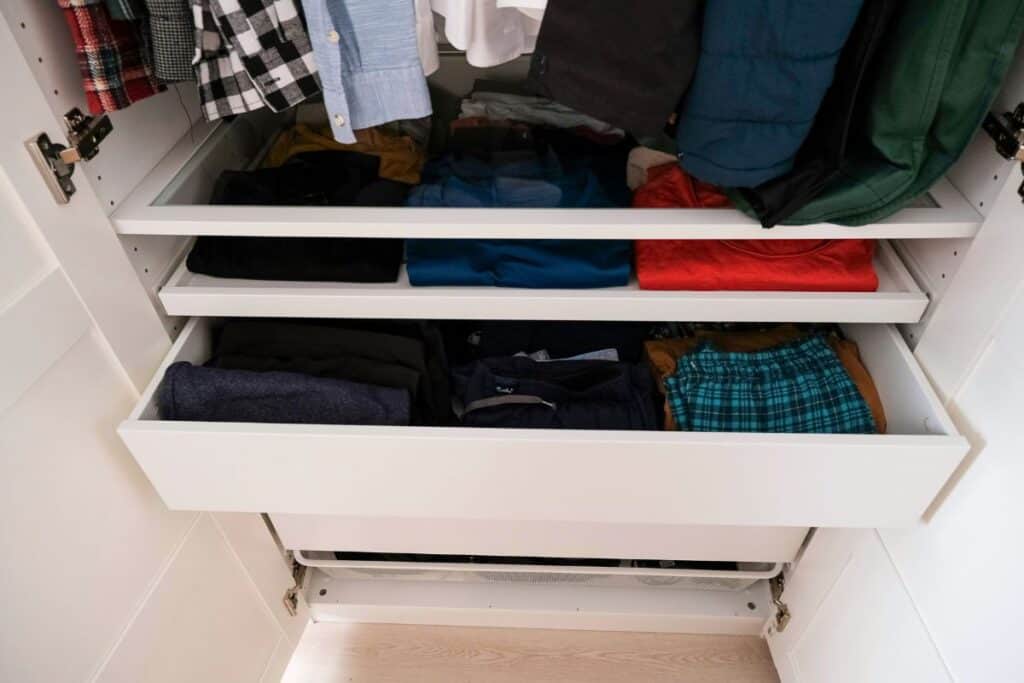
Living in an RV can be a fun and adventurous experience, but it also comes with its own set of challenges, particularly when it comes to space limitations and organization.
To make the most of your RV living, it’s important to develop practical strategies for maximizing storage space, simplifying daily tasks, and maintaining a clutter-free environment.
In this section, we’ll explore a range of RV travel tips for RV living and organizations designed to help you create a functional and comfortable home on wheels.
20. Maximize Storage Space: Unlock Hidden Storage
Maximizing storage space is crucial when traveling in an RV, as every square inch counts.
To make the most of your limited space, utilize vertical storage solutions like shelves and organizers.
Install hooks, pegboards, or magnetic strips to keep items like cooking utensils, tools, and toiletries easily accessible and off countertops.
Add multi-functional furniture with built-in storage, like storage ottomans for added storage.
It’s also helpful to store smaller items in labeled bins or containers, as this helps to keep you organized.
For even more RV storage ideas, check out our blog post “ 47 RV Storage Ideas to Maximize Your Space for Compact Living “.
21. Simplify Meals & Cooking: Easy Eats
Simplifying your meals and cooking routine can make RV living more enjoyable and less stressful.
Plan your meals ahead of time and prep ingredients before your trip to save time and reduce food waste.
Use versatile appliances like slow cookers and instant pots, which allow you to create delicious, one-pot meals with minimal effort and cleanup.
These appliances are also great for conserving energy and minimizing heat generation inside your RV.
Stock your pantry with non-perishable staples and emergency food, such as canned goods, dried pasta, and trail mix.
This ensures that you always have a meal on hand, even if you’re unable to visit a grocery store or don’t feel like making a big meal.
22. Conservation & Managing Waste: Waste Not, Want Not
Managing waste and practicing conservation is always important but it’s even more important when traveling in an RV.
When it comes to your RV’s waste tanks, use biodegradable, RV-safe treatment drops or chemicals to break down waste and prevent odors.
Regularly monitor your tank levels and dispose of waste at designated dump stations, following proper procedures to avoid spills or contamination.
Implement water-saving techniques when washing dishes or showering, such as using a basin to collect water while washing and taking shorter showers.
You might even want to try a military shower for ultimate shower water conservation, where you quickly wet your body, turn off the water while you soap up, and then rinse off quickly.
As this shower method drastically reduces water usage, making it ideal for RV travel where resources can be limited or when you’re boondocking ( more on this later ).
You can also install low-flow showerheads and faucet aerators to further reduce water consumption.
23. Staying Connected & Entertained: Stay Plugged In
One of the main benefits of RV travel and getting back to nature is unplugging, however, it’s still important to stay connected.
To help with this it’s a good idea to invest in a reliable Wi-Fi booster designed for RVs like this popular weboost option on Amazon or a mobile hotspot, as this will help to maintain access to the internet for communication and entertainment.
However, because of the remote nature of RV travel and camping, unless you plan on investing in satellite internet like Starlink , there will be times when you can’t find a signal.
Because of this, before embarking on your RV travels, its a good idea to download offline maps, guides, and entertainment, such as movies, TV shows, or e-books, to enjoy during times when internet access may be limited or unavailable.
Don’t forget though that the whole point of RVing is exploration and getting out of your daily routines, which probably involves a lot of tech and screen time.
So take advantage of your surroundings by exploring local attractions, hikes, and events.
Boondocking & Off-Grid RV Travel Tips
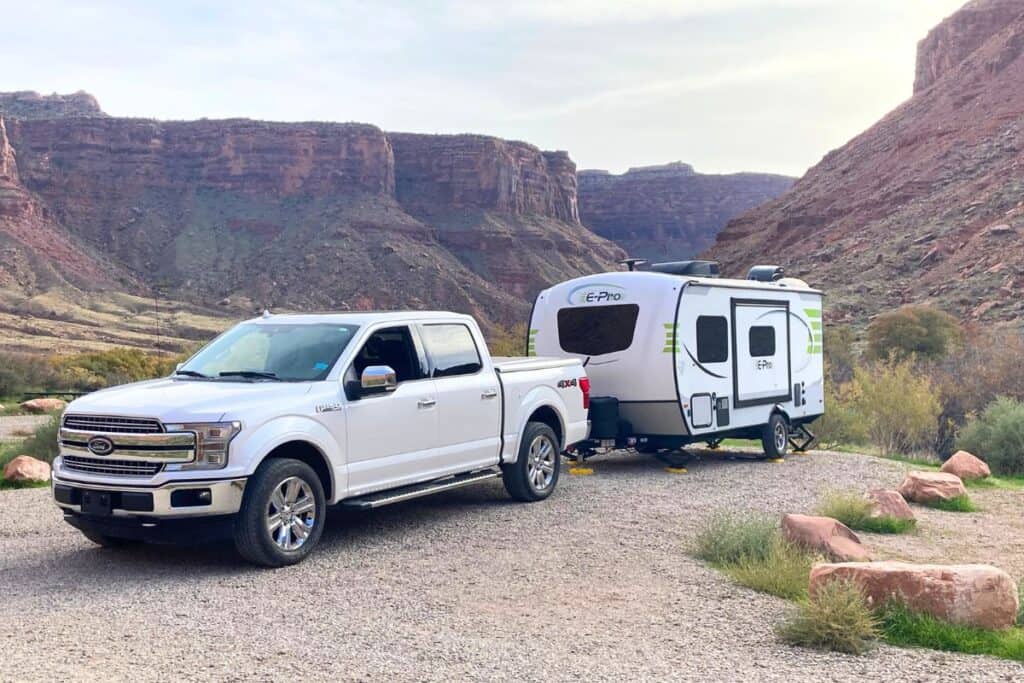
Boondocking, or camping off-grid without hookups, is an increasingly popular way to experience the freedom and solitude of RV camping.
However, while boondocking offers the opportunity to explore remote locations and immerse yourself in nature, it also requires careful planning and preparation to ensure a safe and enjoyable experience.
In this section, we’ll delve into essential boondocking and off-grid RV travel tips to help you make the most of your adventures.
24. How to Find Boondocking Spots: Off-grid Roaming
Boondocking can be a great way to enjoy RVing as well as save some money by avoiding expensive campsites.
However, there are many factors you need to consider when boondocking and one of the most important and sometimes challenging (especially on the East Coast) is finding a place to boondock.
This is where apps and websites come in like Campendium , FreeCampsites.net , or iOverlander , which are resources dedicated to locating free or low-cost off-grid campsites.
These resources often include user reviews, photos, and detailed information about each site.
Beyond these apps and websites though, public lands, national forests, and Bureau of Land Management (BLM) land are always good places to check, as these areas often allow boondocking for a specified number of days.
It’s important to verify stay limits and restrictions before setting up camp though, respect posted private property signs, and obtain any necessary permits or permissions before camping on public lands if required.
25. Conserve Power & Water: Sustain Your Stay
One of the most important practices when boondocking is conserving power and water, as most boondocking sites lack RV hookups.
This means you’ll be relying solely on your RV’s self-contained resources.
The good news though is that there are many things you can do to conserve resources to extend your stay.
Best Ways to Conserve Power While RV Camping & Boondocking:
- Install or add additional roof-mounted solar panels.
- Invest in portable solar panels for more flexible power options.
- Upgrade your RV house batteries from lead acid to AGM or lithium.
- Invest in portable power banks to provide additional auxiliary power.
- Invest in a portable 30-amp or 50-amp RV generator .
- Convert old incandescent RV lighting to modern LED lighting.
- Use a battery monitor to keep track of your electricity usage and battery levels to promote more mindful usage.
- Unplug phantom loads by unplugging devices like TVs, microwave ovens, and chargers that continue to draw power even when turned off.
- Limit inverter use and turn off when not needed, as inverters which convert DC battery power to AC for household devices are inefficient and draw more power.
- Whenever possible, cook outside using a portable gas stove or grill to keep the interior cooler reducing the need for air conditioning.
- Instead of relying on air conditioning, use windows and vents to create a cross-breeze during cooler parts of the day to maintain comfortable temperatures.
- Since water pumps use electricity, conserve water to minimize pump use.
Best Ways to Conserve Water While RV Camping & Boondocking:
- Implement water-saving techniques like using a basin to wash dishes, taking military showers, and turning off the tap while brushing your teeth.
- Instead of running water, use a spray bottle to rinse dishes.
- Place a container in the shower to catch water as it warms up.
- Install a water miser on your RV to automatically recycle the water while you’re waiting for warm water.
- Install low-flow faucets and shower heads.
- Use paper plates to reduce the need for dishwashing.
- Buy one-gallon jugs of drinking water when stocking up on groceries to add additional water supply to your camper.
- Set up a system to capture and purify rainwater for non-potable uses like watering plants, washing outdoor gear, or flushing toilets.
- Consider eating more plant-based meals, which generally require less refrigeration and water for cooking compared to meat-based dishes.
- Make sure everyone in the RV including children understands the importance of water conservation and practices these water-saving tips.
26. Practice “Leave No Trace” Principles: Leave it Better than You Found it
Whether RVing, camping, or just taking a stroll through nature, it’s all our responsibility to maintain the beauty and integrity of these natural areas, not only for our enjoyment but for the enjoyment of future generations.
So make sure to pack out all trash and dispose of it properly, either in designated receptacles or by taking it with you when you leave.
It’s also important to use existing campsites and fire rings whenever possible to minimize your impact on the environment.
If you must build a campfire, keep it small and contained within an existing fire ring, and ensure it’s completely extinguished before leaving.
It’s also important to respect fire bans and follow local regulations to prevent wildfires.
27. Prepare for Emergencies: Ready for Anything
Preparing for emergencies is crucial when boondocking, as you will more than likely be far from immediate assistance.
Because of this, you should have a well-stocked first-aid kit like this one on Amazon , as well as prescription medications, and any items specific to your family’s needs.
You should also pack emergency supplies like extra food, water, and warm clothing in case of unexpected situations or extended stays.
It’s also a good idea to have backup communication devices, such as a satellite phone or two-way radio, to stay connected in areas with limited cell service.
Finally, always make a friend or family member outside of your camping party aware of your general location and direction of travel, in case search and rescue need to locate you in an emergency situation.
28. Utilize Reflective Window Covers: Reflect & Conserve
Utilizing reflective window covers can help regulate the temperature inside your RV while boondocking.
These covers reflect sunlight and heat, keeping your RV cooler during hot days and reducing the need for air conditioning.
In colder weather, reflective window covers can also help insulate your RV, retaining heat and minimizing the need for heating.
Choose covers that are specifically designed for RV windows and are easy to install and remove as needed.
29. Pre-cool Your Food & Refrigerator: Start Cool, Stay Cool
Pre-cooling your food and refrigerator before embarking on a boondocking trip can help conserve power and ensure your food stays fresh longer.
Turn your refrigerator to its coldest setting and allow it to run for several hours or overnight while still connected to shore power.
This will help your refrigerator maintain its temperature more efficiently once you switch to off-grid power sources like 12V, propane, or a generator.
In addition, try to minimize the number of times you open your refrigerator door while boondocking to prevent cold air from escaping.
30. Pack Extra Water Containers: Water Wise
Packing extra water containers is a great way to extend your boondocking stays and ensure that you have a sufficient supply of fresh water.
In addition to your RV’s built-in water tank, bring along several portable water containers like jerry cans that you can fill up before heading to your boondocking site.
These containers can be used for drinking water, cooking, and hygiene purposes, and can also serve as a backup supply in case of emergencies or unexpected situations.
Choose containers that are durable, easy to transport, and rated for drinking water like this popular option on Amazon.
Tips for RV Traveling with Kids

Traveling with kids in an RV can be a great way to create lasting family memories and introduce your children to the joys of outdoor adventure and travel.
However, it also comes with its own set of challenges, from keeping kids entertained during long drives to ensuring their safety and comfort in new environments.
In this section, we’ll explore a range of RV travel tips specifically tailored to families with children.
31. Create a Kid-friendly Space: Kiddie Corner
Creating a kid-friendly space in your RV can help children feel more comfortable and engaged during your travels.
Designate a specific area for play, such as a dinette or a corner of the RV, and equip it with age-appropriate toys, games, and books.
This will give your kids a sense of ownership and provide them with a familiar space to retreat to when needed.
For sleeping areas, use bed rails or safety harnesses to prevent falls and ensure a secure sleeping environment.
Provide each child with their own storage space, such as a dedicated drawer or cubby, to help them stay organized and maintain a sense of personal space within the RV.
32. Plan Kid-friendly Activities: Fun for the Little Ones
Planning kid-friendly activities is key to keeping your children entertained and engaged during your RV adventures.
Research campgrounds and destinations that offer amenities like playgrounds, pools, or kid-friendly attractions.
This will give your children opportunities to burn off energy and socialize with other kids.
Best Ways to Entertain Kids While RV Traveling:
- Hold a mini-scavenger hunt around the campsite using natural items like leaves and rocks.
- Create a travel journal where they can write and draw about their experiences each day.
- Organize a photo challenge with a list of items or scenes they have to capture on camera.
- Bring along board games and card games for evening entertainment.
- Set up a portable projector for outdoor movie nights under the stars.
- Teach them to use binoculars for bird watching or stargazing.
- Have a craft kit ready for making friendship bracelets or simple art projects.
- Download audiobooks or podcasts suitable for children to listen to during long drives.
- Play classic car games like “I Spy” or “20 Questions.”
- Use educational apps on tablets that can teach them about the geography or history of your travel locations.
- Organize nature walks to explore and learn about the local environment.
- Plan simple cooking activities where they can help make meals or snacks.
- Provide them with a map and compass for a basic lesson in navigation.
- Create a “treasure box” filled with small toys or treats they can earn through good behavior or completing educational tasks.
- Play educational games that involve the places you’re visiting, like state capitals or landmark trivia.
- Engage them in planning the itinerary by letting them pick activities or stops for the day.
- Have them help with navigating by reading road signs and tracking progress on a map.
- Bring a small, portable pool for quick and easy fun at the campsite.
33. Maintain a Routine: Rhythm of Life
Just like adults, kids crave routine.
Maintaining a routine while traveling in an RV can help provide a sense of stability and normalcy for your kids.
Stick to regular meals and bedtimes as much as possible, even if your daily activities vary. This will help regulate your children’s energy levels and ensure they get enough rest.
Schedule daily quiet time or naps to give everyone a chance to recharge and relax.
Plan educational activities or road-schooling lessons to keep your kids learning and engaged during travel days.
34. Involve Kids in RV Life: Campers in Training
Involving your kids in RV life can help them feel more connected and invested in your travels.
Assign age-appropriate chores, such as sweeping the floor or organizing their personal belongings, to give them a sense of responsibility and ownership.
Teach them about RV maintenance and safety, such as checking tire pressure or properly disposing of waste, to help them understand the importance of taking care of your home on wheels.
Encourage your kids to help plan trips and activities, giving them a voice in the decision-making process and fostering a sense of excitement and anticipation.
35. Pack Essential Kid Gear: Child’s Play
Packing essential kid gear is a way to ensure your children’s comfort and well-being during your RV travels.
Bring favorite comfort items, such as blankets or stuffed animals, to help your kids feel secure and at home in new environments.
Stock up on healthy snacks and drinks to keep your children nourished and hydrated during long drives or outdoor activities.
Have a well-stocked first-aid kit with kid-friendly medications, such as pain relievers and antihistamines, to address any minor health issues that may arise.
36. Prioritize Safety: Safe & Sound
While safety is always important when RV traveling, when there are kids on board it becomes even more important.
Teach your children essential RV safety rules and emergency procedures, such as how to exit the RV quickly in case of fire and how to call for help.
Use appropriate car seats or restraints for younger children while driving to ensure their safety on the road.
Monitor your kids closely during campfire and outdoor activities, ensuring they understand the importance of staying a safe distance from flames and respecting wildlife.
Jason is an avid lover of RVs and the RV lifestyle. He is both a writer and editor for RV Owner HQ and has been RVing and camping for over 20 years.
Recent Posts
10 Family-Friendly RVs with Bathtubs That Feel Like Home
RVs with bathtubs can make all the difference when traveling and camping, as they provide added luxury and comfort, especially when traveling with kids or pets. No more struggling with tiny shower...
36 Unique RV Gift Ideas For Every Budget: $10 to $100
Are you hunting for unique RV gift ideas for your favorite RVer? If so, you've come to the right place. Finding the perfect RV present can be as tricky as backing into a tight campsite. So, we...

14 Tips For Driving a Class C Motorhome
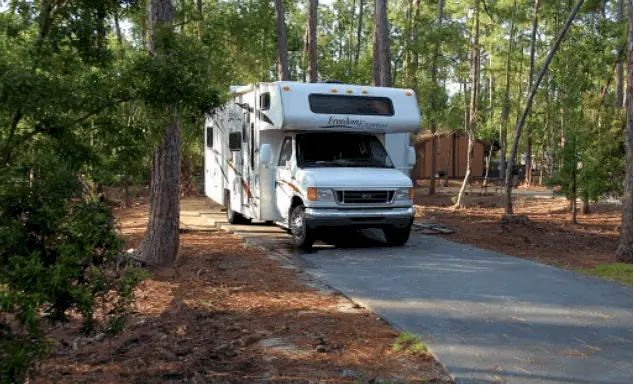
- BEGINNERS GUIDE
G. Yoganand
A motorhome can be as long as 45 feet long or even more. They accommodate people inside them for proper living and thus, tend to be so much bigger.
Driving a Class c rv or Class A rv can be intimidating for people who have not driven such bigger vehicles much.
Same goes with other RV’s like travel trailer or fifth wheels.
Driving a motorhome can however be stress-free and enjoyable if you follow certain things.
Tips for driving Class C RV
In this article, lets see some of the tips for driving a Class C RV, that is little less in length as compared to Class A Motorhome. (these tips can also be applicable for other RV’s like Class A or Class B motorhome)
Driving class C RV is not hard as long as you get some practice and follow all the rules.
1. Check before you start
A class C rv is big a vehicl e , even though it can be much smaller than a full fledged class A motorhome. Even then, it will be good 20 to 30 feet long or even bigger. It can be intimidating to drive such a big vehicle. But, it is not much different than a big regular truck. If you have driven u-haul truck before than this shouldn’t be much different for you.
Best Practice : So, if you are new to class c rv driving or even if you have driven it previously the first thing you should do, is check the surrounding of your rv. Make sure things are clear in and around the motorhome. This is a best practice before driving any kind of motorhome.
Best Routine : It could be parked in front of your home or garage or at a public parking lot, where ever it could be, this should be your first step always. Checking things around the rv gives you confidence and you can either back up or drive straight without a second thought.
Better visualization : Checking the rv this way gives you assurance that you can move it freely and also gives you judgment as to how much you can back up or turn either ways. Remember, once you sit incise the cabin, it may not be possible to visualize better, specially the areas that cant be seen through mirrors.
Among all the motorhomes, Class B are the easiest ones to drive as they are compact and shorter in length. Class C RVs mostly range between 25 to 38 feet long.
2. Get yourself comfortable
Once you are sure of the surrounding of the motorhome, make yourself comfortable in the rv. Adjust the driver seat as per your needs. Do not assume it will comfortable until you really feel it. You, yourselves could have been driving the rv, but still make sure you adjust the seat again; as, when you drive, things do get changed and the seat may not be fully comfortable when you start again.
Air Circulation : Second thing you need to make sure is, the air circulation is happening inside the cabin. Do not turn on the air conditioner immediately. Try keeping the windows open for some time at least.
Windows : Specially, if the motorhome was parked outside in the sun, then its better to keep the windows open for sometime before turning on the cool air from air conditioner. This helps in cooling the vehicle faster and i have seen that, with only ac air; it takes more time to cool the cabin. Once you are comfortable, next thing is to feel the accelerator and brakes with you legs.
3. Take time to do the Basic set up
Buckle yourself up before starting the engine. Make sure it is comfortable for you and neither too fit nor too loose. Rv seat belts are necessary and do not avoid it in any circumstances. In fact, bigger the vehicle, bigger is the impact without seat belts.
Fuel : Next, check the fuel meter. Make sure you have enough fuel for the travel you have planned for. It is always better to refuel at the nearest station rather than waiting till the tank becomes empty.
Headlight : Make sure your headlights are turned on if its night time. Keeping the headlight knob on automatic is good idea, as it automatically turns on the light when it is dark and thus, you are not bothered about turning it “”OFF” and “ON” every time. I myself do it this way, as it reduces one thing to concentrate on while driving such a big vehicle.
Mirrors : Set up rear mirror for good visibility. Check if the backup camera is working or not, do not forget to release handbrake.
By the way, did you know which RV among all types is easy to drive ? Its class B.
4. Give passenger safety a high priority
Class C rv can take passengers with them sitting at the back. Unlike travel trailer, where in passengers cannot sit inside the rv. That’s a great thing and you can enjoy the drive sitting as a passenger.
Passengers to minimum, when you are new : If you are new to driving class c rv then try to keep the passengers as minimum as possible. In-fact, do not carry anyone unless you are fully trained driving the rv. Make sure the passengers are properly buckled up with seat belts and no one is standing or moving around.
Communicate : Make sure you have proper communication with each one of them before starting the vehicle. Until and unless each and everyone is seated and comfortable, do not start the motorhome. Ask each one of them to not use any of the appliances while the rv is moving.
5. Practice first drive in parking lot
This tip is for those who have not driven any kind of rv previously. With such big sizes, class c rv aren’t that easy to drive directly on roads specially, if you haven’t done that previously. However confident you may be, just make sure you try driving the class c rv in empty parking lots.
Get judgment right : This will help you in getting the initial judgment. Driving a car is completely a different thing and with 20-30 feet rv, it is going to be little difficult until you judge the length and able to make turns with ease. Driving in open parking lots or space will give you initial confidence and also help you getting to know the vehicle.
Getting used to : Almost all of us have this tendency to over accelerate when we try the vehicle for the first time. It important that you get used to the rv and then only head on traffic lanes.
Class C Motorhomes can be parked on streets as well but be sure to check the local street guidelines as this may not allowed everywhere and not all the time.
6. Take driving classes if not ready
If you feel rving is going to be difficult for you then do not hesitate to take driving classes. Driving a car is different and do not attempt the adventure, if you are not comfortable driving the 30 feet vehicle.
Driving class c motorhome is not difficult but if you don’t have any prior experience with motorhomes or trucks then getting some driving practice will be helpful.
Get the confidence : It is going to be different when making turns and backing up. There are lots of driving schools that will help you in learning the motorhome. Once you learn the driving, try taking the rv yourself. Its good not to try hands until you are confident enough, specially if you have a new rv.
Learn as much as possible : Try to learn all possible things, practice backing up, go on steep hills to see how it feels. Coming down the hill is also one of the major things, as you continuously have to apply brakes. They say a motorhome is for those who learn and enjoy driving and , you need to continuously learn and with experience you should be able to master the skills.
7. Avoid Lane Change
Keeping in your lane and not switching the lanes too often applies to all vehicles. With motorhomes, you need to be more careful though. Do not keep changing lanes unless it is absolutely needed. Do not drive on extreme sides of the lanes.
Keep it in center : Try to keep the motorhome in the center. Also, with bigger road width you wont be going out of lanes. Lanes on roads in US are bigger enough and will be able to accommodate the class c rv easily.
Avoid high speeds : Also, do not over-speed and keep the speed within the posted limits. If you fee to drive little slower than make sure you are driving on the right lanes. On freeway, its always better to go on right lanes, but it depends from person to person. If you are comfortable driving at high speeds then go for it, but never ever cross the speed limit specified.
8. Avoid U turns
Bigger the vehicle bigger is the area needed for the vehicle to make turns. Class c rv, more than 25 feet long will definitely need more space for turning. And, with this kind of length making U turns is going to very difficult and you will need more adjustment to complete the turn.
Try not to U turn : Thus, its better to avoid making such U turns(unless absolutely needed). At least when you are new to driving rv, do not try making U turns unless its very much necessary. With bigger length vehicles you tend to go outside of the road and that may not be advisable to do. Its better to take right or left turns and get to your destination rather than making U turns.
9. Be careful when turning left or right
Making turns with a big motorhome is different as compared to a car or a small truck. You need to go little further than you would in a car, and then turn left or right. A big length of the vehicle makes it necessary to utilizing bigger radius while making the vehicle turn.
Check your speed : Else, you could just get your class c rv’s tires above the curb. You need to get used to this, else you may hit the motorhome to sideways as well. Remember, the speed also need to be reduced substantially. With car, it can be done with little less speed as compared to the straight road, but for a vehicle like class C rv, it is essential that you almost go to zero miles or so before turning.
Be calm and patient : You need not be in hurry while taking the turn, other vehicles behind you should have the idea that the vehicle will take time to turn. And thus, be calm and patient while making the turns. Do not forget to give the side lights and its better to turn ON the side lights little earlier and be prepared for the turn yourself and also indicate others behind you, of your intentions.
10. Keep safe distance between vehicle ahead
When you are driving the motorhome at high speeds make sure you are behind the vehicle in front of with a gap of at-least one similar rv or more. This is necessary because the bigger class c rv will take time to stop when you apply break.
Stopping takes time : This is a normal thing for all other vehicle as well. A bus or bigger truck too, takes good amount of time to stop and thus, this space is needed for the reaction time. Avoid tailgating behind smaller vehicles that may annoy the vehicle owner in front.
Right Lane driving : Make sure you drive at posted speed but keeping in mind the distance you need to maintain between the vehicle in front. Also, driving too slow can be dangerous as the vehicle behind you could get too close to you. If you fee like driving slower, change lanes and be on the right hand side lane. But, in this case you may have to face vehicles that would be existing the way, so you need to be more careful in right lane as well.
11. Do not over-speed
It is not legal to cross the posted speed limit. Always drive at speeds that are allowed. It is okay to go a little above the speed limit but not too high. Like, if the speed limit is 30 mph, going a little above 32 or 33 can still be okay but not 40 mphs for sure.
Uniform acceleration : The speed limits are put for reasons and you cannot exceed those for your own safety and of others too. Going at constant speed gives you sense of control and you will be in better position to stop the motorhome in case needed. Bigger the vehicle, longer is the time taken to come to a complete stop. Do not accelerate unnecessarily, make sure you accelerate at a uniform speed.
12. Use GPS smartly
When moving around in motorhome its always better to plan before moving. Make sure you make use of gps and be prepared about the route. As already discussed, its not a good idea to make U turns and turning also is little difficult with motorhomes, its best to find best way well in time.
Not always the gps shows you best way, so don’t be too dependent on gps too. If you know the route then use your own judgment in finding the route. GPS overall can be a great way to figure out and plan your travel and now a days, everybody is so much dependent on the online map routes.
13. Practice parking
Parking a rv is another challenge but with practice you should be able to master that too. One of the important things with parking is ability to judge the space. Not all parking slots will be accommodating the large class c rv and thus you may end up utilizing 2 or more slots for parking.
Take help from passengers: At campground you would be able to get full parking slot. While parking, you need to judge the space correctly and park with care. It is better if someone with you can get down and help you while you move the motorhome in the slot. A backing camera is also of great help during parking.
Get a backing up camera : But, not all class c rv’s will have backing camera and thus, be prepared to do it without a camera. If you have a class c rv that wasn’t equipped with a backup camera than try to get one for your motorhome. Such a camera is of great help when you are alone, and nobody is with you in the motorhome.
14. Be extra careful while backing up
Backing up a class c rv is challenging , in-fact this is the case with any kind of rv. Its mostly because of the height and the length of the vehicle. A 20 to 30 feet length of vehicle definitely needs great judgment, a camera for backing up helps a lot. But, you should be prepared to do it without camera.
You never know when the luxury of camera may not work for you. Even when driving tests are done, dmv does not allow to use the camera. Idea is to be self sufficient and not dependent on the luxury of a backing up camera. You need to position yourself in such a way so that you can see at the back, and be sure that nobody is at the backside of the rv.
You Might Also Like
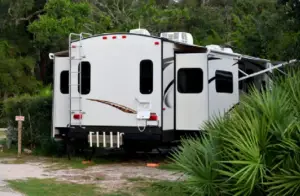
RV Set-Up Checklist For Newbie or First Timers
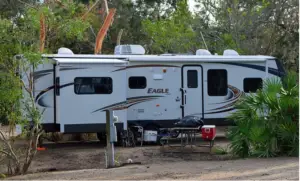
3 Tips to Successfully Maintain An RV Slide Out
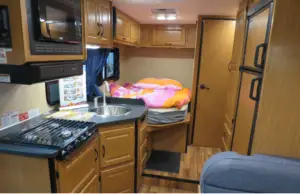
How to keep mold out of camper trailer (19 Ways to Prevent)
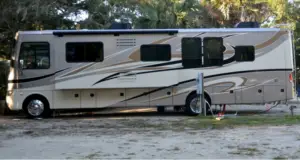
How much is the average RV length, width and height
How to Drive a Class C RV: 101

DUSTIN & SARAH BAUER
Dustin and Sarah are firm believers that the best adventures are found far off the beaten path. In June 2020, they purchased a Tiffin Wayfarer Class C in an effort to extend their adventuring and enjoy the outdoors for longer periods of time. They like to spend their free time biking, hiking and packrafting, all while making new friends and memories along the way.
- Follow Thor Industries on Facebook
- Share this story on Pinterest
There's a unique allure to the open road, a sense of adventure that beckons from the horizon. For those of us who've answered the call, Recreational Vehicles (RVs) serve as our trusty steeds, carrying us towards the promise of new experiences. But, as with any epic journey, it's crucial to put safety first. Your RV is not just your transport, but your home on wheels. Ensuring its well-being ensures yours, too.
Understanding your vehicle's strengths and limitations forms the foundation of a safe and enjoyable adventure. So, buckle up, Class C RV enthusiasts, as we embark on a comprehensive journey into the world of safe RVing.
Understanding Class C RV:
Size, functionality and basics.
Class C RVs are the “swiss army knife” of motorized RVs, offering a balance of comfort and maneuverability. Typically built on a van, truck, or a semi chassis (big super C’s), these beauties come with all the amenities of home. But don't let their cozy interiors fool you; they are larger than your average vehicle and require specialized handling.
Size matters in RVing, and with Class C RVs generally ranging from 20 to 40 feet, understanding their dimensions is vital. It informs everything from choosing the right campsite to safely navigating city streets and highways. A Class C RV's functionality lies in its clever use of space, with sleeping, cooking, and bathroom facilities neatly tucked into its design. However, this compact living can also lead to heavier loads, which impact driving dynamics.
Creating a Height and Length Reminder on Dash: An Essential Safety Tip
In the world of RVing, forgetting your vehicle's dimensions can lead to disastrous consequences. That's why creating a height and length reminder on your dash is an essential safety tip.
This constant visual reminder can save you from scrapes with low bridges or tight turns. It's also a handy reference when planning your route or selecting a campsite. So, grab a sticky note or a piece of tape, and jot down those vital measurements. Ours also says, “Watch out for trees.” That may sound obvious, but it is easy to get comfortable and to cover your basics. We certainly have in our Tiffin Wayfarer because its vantage point is similar to a van that we own that is actually much shorter.
Carwash and Building Heights Awareness: Protecting Your Investment
Awareness of your RV’s height is crucial. Many new RVers learn the hard way when their vehicles encounter bridges, carwashes, gas station covers, or building overhangs that are too low. A good rule of thumb is always to know the height of your RV and double-check clearance levels before proceeding.
We always do a lot of research and read car wash reviews before we head out to find a local one on trips. Be careful as some people's “huge bays” might not be huge/tall enough for your RV. If you can’t find enough info, take the time and call around. We prefer outdoor truck bays whenever possible so roof height isn’t an issue, but you must still be cautious as the boom heights can differ and even still be too short.
When it comes to fueling up, not all gas stations are created equally. We prefer to find truck stops whenever possible, but if they aren’t available we resort to reviews and websites to research gas stations in the area.
Planning Ahead: An Essential Part of Safe RVing
As Benjamin Franklin famously said, "By failing to prepare, you are preparing to fail." This wisdom holds especially true for safe RVing. Planning ahead is more than just plotting your route on a map; it involves considering factors like weather conditions and road quality. Even National Park and campsite regulations need to be considered since many have length restrictions. This was a primary reason we chose our 25-foot long Tiffin Wayfarer.
A well-planned journey allows you to anticipate challenges and make necessary adjustments. Knowing the height of your RV can save you from the unpleasant surprise of low bridges or overhangs. For example, the popular tourist area around Mount Rushmore and Crazy Horse monuments has tunnels on Iron Mountain Road and are not tall enough to accommodate an average sized Class C RV. Knowing any height limitations ahead of time can save you a ton of trouble down the road.
PREPARING FOR THE ROAD
Benefits of practicing rv driving: familiarity and confidence.
Think back to when you first learned to drive. It was probably a little intimidating, right? Now imagine the same scenario, but with a vehicle that's potentially three times the size of a typical car. It's enough to make anyone anxious. That's why practice is key when it comes to driving an RV.
The more time you spend behind the wheel, the more familiar you become with your vehicle's size and handling. This familiarity breeds confidence, making you a safer and more competent driver. Practice in a variety of conditions, including night driving, city traffic, and different weather conditions. We recommend starting close to home. Try driving to your local grocery store or through familiar back roads first. This takes off the added pressure of navigating to somewhere new while you’re getting comfortable behind the wheel.
Importance and Benefits of RV Driving Courses
Despite your experience with regular vehicles, an RV is different. If you desire some extra piece of mind, an RV driving course can provide valuable insights into handling your vehicle safely.
These courses cover everything from basic maneuvers to advanced techniques like parking and reversing. They also cover essential safety checks and maintenance procedures. Plus, completing a course can mean reduced insurance premiums, making it a win-win situation.
The Value of Taking an RV Safety Course
We've already touched on the importance of RV driving courses, but it's worth emphasizing the value of a dedicated RV safety course. These courses cover aspects of RVing that go beyond driving, including fire safety, propane handling, and even first aid.
These courses often include practical exercises, allowing you to put your newfound knowledge into action. So, if you're serious about safe RVing, consider signing up for an RV safety course. It's an investment in peace of mind.
The Importance of Using RV Specific GPS
We all rely on GPS to guide us to our destinations. But did you know that there's a GPS specifically designed for RVs? An RV-specific GPS takes into account the specific requirements of these vehicles, including height, weight, and length restrictions.
These specialized devices can warn you of low bridges, narrow roads, and height-restricted tunnels. They can also guide you to RV-friendly routes and campsites. So, when planning your RV adventure, consider investing in an RV-specific GPS. It's like having a seasoned RVing expert right there on your dashboard.
ON THE ROAD
The advantage of two drivers: ensuring rested and alert rv operation.
Long drives can be exhilarating, but they can also be exhausting. Fatigue is a significant contributor to road accidents. This is where having two drivers comes in handy. Alternating between drivers ensures that each person gets adequate rest, keeping both alert and responsive to road conditions. Driving an RV requires more concentration than driving a standard car due to its size and weight. A rested driver is more likely to make sound decisions in challenging situations, contributing to overall safety. Besides, having two drivers also means having twice the fun, with each getting to enjoy the scenery while the other focuses on the road.
Additionally, a second driver is beneficial in case of a medical emergency or adventure injury, they can assist getting the group and RV home or to safety.
The Importance of Driving Slowly with an RV
In an RV, slower is safer. The larger the size and weight of your RV, the longer it will take to stop or slow down. Driving at a slower speed allows more time to react to changing road conditions or unexpected obstacles. It can also reduce the risk of rollovers and accidents. High speeds can make an RV more susceptible to crosswinds and can lead to loss of control.
Understanding the Need for Extra Space Between Vehicles
Remember your first driving lesson when your instructor emphasized the importance of maintaining a safe following distance? This rule is even more critical when driving an RV. Due to their size and weight, RVs need a greater stopping distance than regular cars.
Maintaining extra space between vehicles gives you more time to react, reducing the risk of collision. It also provides a safety buffer in case of sudden stops or changes in traffic flow. So, when you're out there on the road, remember, distance is your friend.
Why No U-Turns: Understanding RV Movement and Maneuverability
Driving an RV isn't like driving a compact car. The size and weight of these vehicles affect their maneuverability, making some movements more challenging than others. One such move is the U-turn. While it might be a convenient way to reverse direction in a car, it can be a risky maneuver in an RV, especially for a new RVer.
Because of their length, RVs require a wider turning radius. Attempting a U-turn on a narrow road can lead to your RV blocking both lanes, potentially causing accidents. Instead, consider finding a safe place to turn around, like a parking lot or wide intersection. That’s why we believe it is best that you avoid u-turns all together, or wait till you have a lot of experience in your unit before you attempt this maneuver.
Why Rearview Cameras are helpful for Safe RVing
Just as a rearview mirror is essential for a car driver, a rearview camera is a must for safe RVing. Given their size, RVs have larger blind spots, making reversing or changing lanes more challenging. A rearview camera provides a clear view of what's behind you, reducing the risk of accidents. While ours has this as a standard option, that’s not always the case. We highly recommend purchasing one as an aftermarket purchase if your vehicle does not come equipped with one.
These cameras come in particularly handy when parking, allowing you to spot obstacles that might be missed by side mirrors. Some models even provide night vision, making it safer to navigate in low light conditions. So, when it comes to safe RVing, consider a rearview camera as your third eye.
Stop and Navigate: A Strategy for Uncertain Situations
Even the most experienced RVers encounter uncertain situations on the road. Whether it's a sudden road closure or an unexpected detour, these moments can test your navigation and coping skills. In these situations, the best strategy is to stop, then navigate.
Pull over safely, take a deep breath, and assess the situation. Consult your maps, check your GPS for alternate routes, or even ask a local for directions. Remember, it's better to lose a little time figuring out your route than to barrel ahead into potential danger. Safe RVing is all about patience, planning, and a little bit of problem-solving.
PARKING & CAMPSITES
The role of partners in parking: a key to safe rving.
Navigating into tight parking spots or reversing into a campsite can be a challenge even for experienced drivers. This is where having a partner can be invaluable.
A parking partner can guide you from outside the vehicle, providing a second pair of eyes to spot potential obstacles. This can prevent damage to your RV and ensure the safety of others around you.
Bonus Tip: Many RVers use walkie talkies to be able to easily communicate with their parking partner from inside the RV. A good pair of walkie talkies can really come in handy while on the road!
Choosing A Campsite for a Class C
Whether you're looking for a secluded spot in the mountains or a bustling campground near the beach, there are countless campsite options to choose from. When searching for a campsite for a class C RV, it's important to check the length of the site to ensure that it can accommodate your vehicle.
Some RVers prefer a pull through site when starting their RV journey. This avoids unnecessary back up parking. Additionally, it's important to consider the accessibility of the campsite. Sometimes it is best to call the campground ahead of your arrival to check for any obstacles like low-hanging trees, as some campsites may have narrow roads or other obstacles coming in and out. By carefully considering these factors, you can find the perfect campsite that offers both beauty and convenience.
MAINTENANCE CHECKS
The importance of regular safety/maintenance checks.
Being safety conscious means staying vigilant about the condition of your RV. Regular maintenance checks help prevent unwanted surprises on the road. Just like your car needs regular servicing to stay in top condition, so does your RV. These checks should include all systems – from your engine to your electrical system, from your tires/brakes to your propane system.
Remember, an RV is more than just a vehicle; it's your home while on the road. It’s crucial to keep in mind the weight of your RV and pack lightly to stay within OEM recommended load capacity (GCWR), for both your safety, life of the unit, and fuel efficiency. Plus, being aware of your vehicle's weight helps you navigate steep gradients safely. Safe cargo capacity and regular maintenance helps ensure that all systems are functioning correctly, providing a safe and comfortable living environment. So, make regular safety/maintenance checks part of your RVing routine.
Conclusion: Embrace Safe RVing for a Rewarding Adventure Experience
RVing offers an unparalleled sense of freedom and adventure. But, like any great journey, it comes with its share of challenges. By embracing a safety-first mindset, planning ahead, and continually learning, you can navigate these challenges confidently.
Remember, safe RVing isn't just about following rules or ticking off a checklist. It's about creating a mindset of safety that guides every decision you make on the road. With this guide, you're well on your way to mastering the art of safe RVing. So, here's to many rewarding adventures ahead, and remember, keep safety first!

Class C Motorhomes
Class C motorhomes offer outdoor experiences for larger families at a lower price point than Class A Motorcoaches. Recognizable by their raised sleeping or storage areas which extend over the cab of the RV, Class C Motorhomes offer more living space than Class B Motorhomes but are smaller in size and can offer better gas mileage than Class A Motorcoaches.
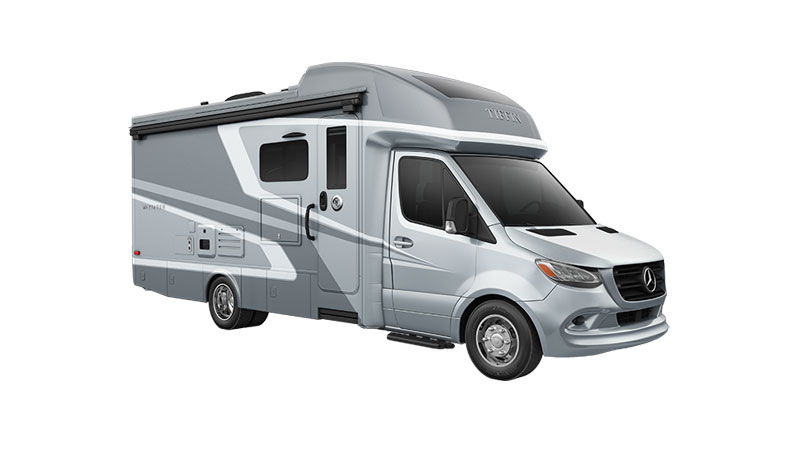
Tiffin Motorhomes Wayfarer
Related stories.
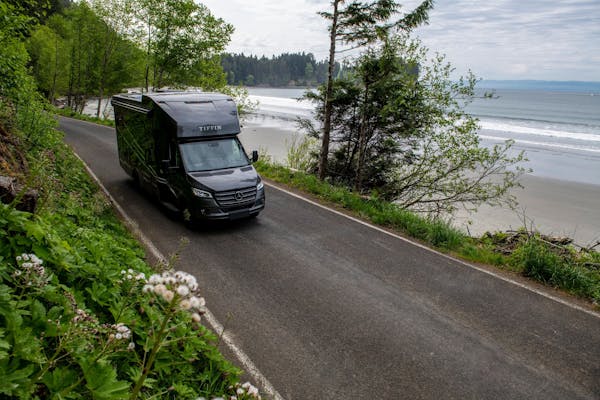
Class C Motorhome
Class Cs are recognizable by their over-cab sleeping/storage areas which provide additional living space for families of all sizes and are generally more affordable than motorcoaches

The Basics of Motorized RV Maintenance
Dustin and Sarah Bauer share their maintenance tips and recommendations for keeping your motorized RV running smoothly.
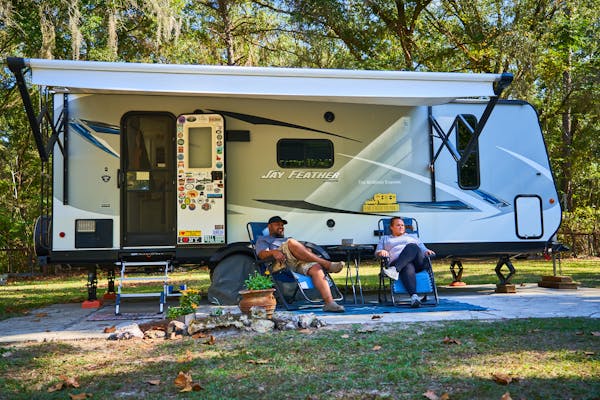
Overnight Parking In Your RV
Ben and Christina share their tips for finding a place to stay overnight when traveling in your RV.
Find Your Perfect RV
Whether you're new to the world of RVing or you're ready to narrow your search, we're here to help you sort through it all and find the RV that's right for you. Explore RVs based off of your lifestyle and the features important to you.

Welcome to Lake
Discover places to stay and unique experiences around the world.
- How It Works
Home - Blog - Class C Motorhomes: Your Ultimate Guide to Features, Cost, and Travel Tips
Class C Motorhomes: Your Ultimate Guide to Features, Cost, and Travel Tips

Jasmine Gruber
May 8, 2024
In this article
Get started.

The Perfect Balance of Comfort and Mobility with Class C Motorhomes
If you’ve been eyeing that stretch of open road with daydreams of adventure, you might be considering a Class C motorhome as your trusty travel companion. What’s a Class C motorhome, you ask? It’s that sweet spot where the comfort of home meets the mobility of the road.
Class Cs are built on a truck or van chassis with a characteristic over-cab space. Class C is essentially the middle child of motorhomes. Not as large as the Class A , but more substantial than a Class B , these RVs bring amenities and practicality.
You’ll find them cuddling up to the idea of luxury on wheels with features like fully equipped kitchens, cozy sleeping quarters, and even full bathrooms. All this without the intimidation of maneuvering a vehicle the size of a small whale down the highway!
Class C motorhomes offer a balanced blend of space, comfort, and amenities, all without the cumbersome size of their Class A siblings. Plus, with prices like the $143,292 starting point for the Minnie Winnie , you’ve got options for just about every budget.
Benefits of Class C Motorhomes
Class C Motorhomes strike a remarkable balance, offering comfort and convenience when on the road. Ideal for families, they make great use of space without sacrificing those home comforts you love.
Size and Space Optimization
When you step into a Class C Motorhome, you’ll immediately notice how efficiently every inch is used. You can expect a cleverly designed cabover bunk, perfect for when you need extra sleeping space. Most models also offer a variety of other sleeping options like bunk beds or a bunkhouse area.
These sleeping options optimize the space for families or groups to ensure everyone has a cozy resting spot after a day of adventure.
- Sleeping space : Varied options, often including a master bed, bunks, and convertible dinettes.
- Storage space : Thoughtfully placed cabinets and external storage compartments to tuck away necessities.
Family-Friendly Designs
Family outings need a family-friendly vehicle, and that’s where Class C Motorhomes shine. Many come equipped with amenities tailored to the needs of families.
With their additional storage space, there’s enough room for everyone’s gear, from hiking boots to board games. Need a place for the kids to sleep? Look for models with dedicated bunk beds—it’s like having a traveling treehouse on wheels!
- Bunkhouse models : Ideal for larger families, featuring separate areas for kids to sleep and play.
- Entertainment options : Many feature TVs and other entertainment systems, perfect for keeping the little ones occupied on rainy days.
Choosing the Right Model

When you’re in the market for a Class C motorhome, you’ll want to weigh the pros and cons of new vs. used rigs and consider which features matter most to you.
New vs. Used Motorhomes
New Motorhomes
- Price : Expect to pay anywhere from $90,000 to over $300,000. Price varies based on features and upgrades.
- Condition : Sparkling new, with the latest technology and no wear and tear.
- Warranty : Comes with a manufacturer’s warranty for peace of mind.
Used Motorhomes
- Affordability : More budget-friendly, you can find gently pre-loved models at a fraction of the cost of new ones.
- Depreciation : A used RV has already undergone its steepest depreciation, giving you better value.
- History : It’s essential to check for maintenance records and any potential past damage.
Important Features to Consider
- Layout : Are you comfy in a cozy space, or do you need room to stretch? Consider the number of beds and the presence of slide-outs.
- Kitchens : Look for practical layouts, sufficient counter space, and appliance quality. Do you love to cook? Prioritize a well-equipped kitchen.
- Bathrooms : Essential for comfort on long journeys. Always check the size and if it’s a wet bath (shower combined with the toilet) or a separate space.
- Storage : Adequate storage can make or break your traveling experience. Make sure there’s enough room for all your gear.
Popular Class C Motorhome Brands
Are you curious about which Class C motorhome brands might tick all your boxes for road-tripping bliss? You’re in luck! Here’s a quick rundown of popular Class C RV manufacturers and what they bring to the table.
Winnebago Class C Lineup
Winnebago, a household name in RV circles, offers models such as the Winnebago View with its combination of luxury and practicality.
Did you know the Minnie Winnie starts at a price of roughly $143,292? It’s famed for its ease of use, making it a top pick for first-timers.
Jayco’s Reliable Options
Jayco doesn’t skimp on dependability. Models like the Greyhawk and the luxurious Melbourne Prestige —boasting a Mercedes-Benz 3500 chassis—emphasize comfort during your adventures.
Starting at $192,993, the Melbourne Prestige is for those who want to splurge a little for that extra sophistication.
Adventures with Forest River
Forest River offers a broad spectrum of Class C motorhomes catering to budget-friendly and luxury preferences.
Key Specifications and Features
When you’re on the hunt for the ideal Class C Motorhome, knowing the ins and outs of its specifications and features is like having a secret map to treasure. Not all RVs are created equal—so let’s zoom in on what sets Class C apart in the world of comfort on wheels.
Motorhome Layouts and Floorplans
Have you ever dreamed of a home that can go anywhere? That’s where Class C Motorhomes shine. They’re designed with versatility in mind.
Typically built on a truck chassis, these homes on wheels blend easy driving with surprisingly spacious interiors. Super C Motorhomes even push the envelope, with offerings that mirror the expansiveness of Class A RVs without feeling oversized. Here’s a quick peek:
- Standard Class C : Often found with a signature over-cab sleeping area; ideal for solo travelers or small families.
- Super C : Amped up on a commercial truck chassis—imagine having more room to stretch out and more power to haul!
Layouts and floorplans can include multiple bedrooms, slide-outs for extra living space, and full-size bathrooms. Your preferences dictate the floor plan, whether you love entertaining or cherish your peace and quiet.
Amenity Comparison
Amenities are the cherry on top of your motorhome experience. What’s cool is that Class C Motorhomes pack a punch with amenities often seen in much larger Class A RVs—yes, even some of the luxurious touches!
Think about what amenities matter most to you. Here’s a quick snapshot to get you started:
Standard Model Amenities can include:
- Compact kitchens
- Convertible dinettes
- Queen-sized beds
- Ample storage
- Entertainment systems
Luxurious Model Amenities might boast:
- Solid-surface countertops
- Residential-style bathrooms
- Outdoor entertainment centers
- Solar power capabilities
Understanding Chassis Types
You’re not just choosing a home but also a vehicle. The chassis is the motorhome’s backbone, which is important, right?
Class C Motorhomes are typically built on a van frame or a truck chassis. The type of chassis influences driving dynamics, overall stability, and towing capabilities. Here it is, in a nutshell:
- Van Chassis : Used for standard Class C motorhomes; provides a smooth ride and easy maneuverability.
- Truck Chassis : Found in Super C motorhomes; offers a beefier engine and higher towing capacity, sometimes up to 8,000 pounds.
Practical Considerations

Before hitting the road with your new Class C motorhome, it’s wise to mull over a few practicalities. How will your RV handle long distances? Can it double as a storage unit for your dirt bike or jetski? What’s involved in keeping it in tip-top condition? Let’s buckle up and drive through the nitty-gritty details.
Fuel Efficiency and Engine Types
Your motorhome’s thirst for fuel is more than just a line item in your travel budget—it can define your journey.
Diesel-powered engines are known for being more fuel-efficient than their gasoline counterparts, especially when you’re covering a lot of ground.
They can provide better mileage which means fewer stops and more savings. Keep in mind:
- Diesel tend to offer better torque, essential for uphill climbs
- They typically last longer than gas engines, which could mean fewer mechanic visits
Towing Capacity and Additional Storage
Have you ever considered bringing a boat or a trailer on your adventure? The towing capacity of your Class C motorhome is key. If you’re leaning towards the toy hauler variety, it’s designed exactly for that purpose. Here are some hard numbers for you:
- Standard Class C motorhomes usually tow around 5,000 pounds.
- A heftier hitch can push that number up, with some models handling up to 35,000 pounds.
Extra storage is not just a convenience—it’s essential for longer trips. Ensure your motorhome can handle both the weight and space needs of your gear.
Maintenance and Upkeep
“An ounce of prevention is worth a pound of cure,” they say, and they’re right! Regular check-ups of your brakes, suspension, and plumbing will save you a bundle and keep your travels smooth. Here’s what you should focus on:
- Protect against rust by storing your RV undercover or using a quality cover.
- Don’t overlook routine checks on your brakes and suspension to avoid wear and tear from spoiling your trip.
Keeping your Class C in good shape means fewer surprises and more happy trails.
Interior Design and Comfort
When you step into a Class C Motorhome, you’re stepping into a home on wheels. The interior design and comfort are critical aspects that can make your travels feel luxurious or functional, depending on your preferences.
Furniture and Seating Options
Have you ever found yourself plopped on a sofa so comfy that you never wanted to stand up? That’s the kind of true comfort we’re aiming for in your motorhome. The furniture choices are key to your relaxation:
- Sofas: Options often include a TrueComfort+ sofa , designed to provide support and plush seating, doubling as a bed for those extra guests or lazy afternoon naps.
- Dinettes : Serving as a multifunctional space for dining, working, or playing games, most dinettes also convert into an additional sleeping area. Think about the extra utility packed in that space!
- Beds: A queen bed is pretty standard in the back for a restful night’s sleep. But, if you’re a fan of versatility or traveling with friends, twin beds might do the trick, offering personal space and comfort.
Lighting and Electrical Features
Enough about daytime, what about when the sun sets? Lighting is not just about visibility; it creates the ambiance of your interior space.
- LED Lighting: Efficient and bright, LED lights are everywhere, from the ceiling to underneath cabinets. Plus, they’re energy savers, so you keep your motorhome lit up without draining your batteries!
- Electrical Outlets: Plentiful and strategically placed so that whether you’re whipping up a midnight snack or charging your gadgets, there’s a spot for that.
With these features, your Class C Motorhome becomes a bright and cozy sanctuary, no matter where you park it. Isn’t it amazing how some twinkling lights and a cushy seat can transform a space?
The Buying Process
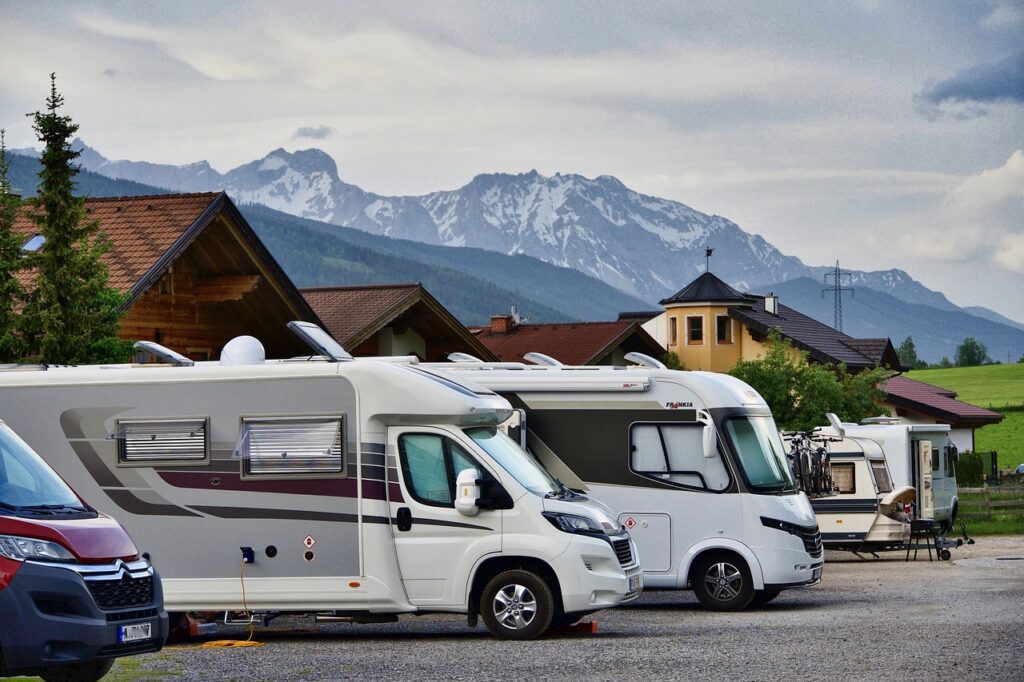
Embarking on the adventure of buying a Class C RV? Great choice! Let’s ensure you’re well-informed about where to find your dream motorhome and how to navigate the financial side of the purchase without any surprises.
Where to Shop for Class C RVs
When you’re looking for a Class C RV, your options are plentiful, but knowing where to look is key. Start by checking out RVs for sale at reputable dealers like Camping World . They offer a wide variety of choices and the expertise to guide you through your purchase. Another route is online marketplaces, which can expand your reach to private sellers and potentially score a deal.
Dealership advantages include:
- Professional guidance
- Wide selection of different models
- Potential financing options
Online marketplaces offer:
- Competitive pricing from various sellers
- Direct contact with sellers for transparent communication
- More room to negotiate
Remember, see the RV in person if you can—it’s the best way to ensure it matches your expectations.
Financing and Hidden Costs
Financing your Class C RV can be smooth sailing if you know what to expect. Dealerships, like Camping World, often provide RV financing options. Comparing rates and terms is key to finding a plan that fits your budget. Don’t shy away from asking questions about the loan details.
Now, let’s talk about hidden costs. Be aware of additional fees that may pop up:
- Freight and prep charges: They cover the transportation and preparation of the RV for sale.
- Sales tax and registration: These can vary by state, so check local requirements.
A helpful tip is to request a complete breakdown of the price to spot any additional fees. This transparency lets you budget accordingly and avoid any last-minute financial surprises.
Frequently Asked Questions
What are the key features to look for when purchasing a used class c motorhome.
You’ll want to inspect the condition of the motorhome thoroughly, including the engine, tires, and electrical systems. Interior-wise, check for signs of leaks, the state of appliances, and overall cleanliness. Service records are golden, revealing the motorhome’s maintenance history.
How do I find the best deals on Class C motorhomes under $50,000?
Scour online listings, RV trader sites, and local dealerships specializing in used RVs. A watchful eye on auction sites and government surplus sales can sometimes snag you quite the deal. Remember, the best deal isn’t just the price tag but also the condition and history of the motorhome.
What are the pros and cons of living full-time in a Class C motorhome?
On the sunny side, you get freedom, mobility, and the chance to explore with all your home comforts. Conversely, space is tighter than a traditional home, privacy can be scarce, and perpetual maintenance is your new hobby. It’s a lifestyle of give-and-take, tailored for the adventurous soul.
What should I consider when comparing Class A and Class C motorhomes?
Class A motorhomes are the big kahunas, offering more space and luxury but at a heftier price and often less fuel efficiency. Class C models are more compact, easier to drive, and gentler on the wallet in terms of upfront cost and fuel. It’s a trade-off between space and manageability.
What are some tips for first-time renters of Class C motorhomes?
Take a test drive to get comfy with the RV’s size and handling. Ask about the ins and outs of the specific model you’re renting—how to use the generator, slide-outs, and any quirks it may have. Also, clarify rental insurance coverages and roadside assistance details before hitting the road.
How do maintenance costs for small Class C motorhomes compare to larger models?
Generally, smaller Class C motorhomes have lower maintenance costs. Less square footage means fewer things to fix, and a smaller engine equals less expensive tune-ups. Plus, parts needing replacing are often standard and less costly than those specialized for larger rigs.

Jasmine has visited 22 countries, with her favorite destination being Milos, Greece. She has lived in New Zealand, the Netherlands, and Australia and has experienced diverse cultures, including a festive Christmas in New York. Growing up near the beach in New Zealand and with a mother working in aviation, Jasmine developed a love for travel early on, exploring various landscapes such as beaches, lakes, mountains, and national parks.
- Class C Motorhomes
Related Posts

December 7, 2023
Best Time to Visit Lake George: When to Plan Your Trip
When it comes to planning a trip to Lake George, timing can make all the difference. In th...

May 18, 2024
Best Time to Visit Lake Superior: Insider Tips and Seasonal Highlights
Not sure the best time to visit Lake Superior? This comprehensive guide has everything you...

November 24, 2023
Best Time to Visit Lake Michigan: Insider’s Guide for Unforgettable Moments
Choosing the best time to visit Lake Michigan is an […]
Don't have an account yet? Register
Already have an account? Sign In
Reset Password
Please enter your username or email address, you will receive a link to create a new password via email.
6 steps to planning a successful RV road trip
Whether you’re an experienced RVer or just starting out, these tips will help make sure you have an amazing RV road trip
By Roadtrippers
When I bought my first RV more than a decade ago, it wasn’t because I loved camping. Rather, I was a dedicated roadtripper who spent all my vacation time driving along the Blue Ridge Parkway in the east, the Pacific Coast Highway in the west, or any scenic byway in between. As I entered my 30s—with a couple of babies in tow—I still desperately wanted to be a road warrior. However, I also wanted to bring some of the creature comforts of home along on the adventure. Enter the RV road trip.
Why road trip in an RV rather than a car?
Eleven years after that first RV purchase I can say the big bet paid off. My family has spent hundreds of days roadtripping around the country exploring national parks , historical landmarks, kitschy roadside attractions , urban destinations, and beach resorts. Here are the reasons why I choose to plan RV road trips more than any other type of travel.
You can travel more and spend less
It is easier for us to control costs when we travel in an RV than when we take other types of road trips. Spending less on a campground does not mean sacrificing natural beauty or comfort. State and national park campgrounds offer some of the most scenic places to park your rig with a price tag ranging from 20 to 40 dollars per night. Feeling more adventurous? Find Bureau of Land Management (BLM) land where you can boondock for free. Another option is purchasing a Harvest Hosts membership, which will allow you to camp for free at wineries, breweries, and farms around the country.
You can prepare your own food in an RV
An RV kitchen allows travelers to eat healthier and spend less money while on the road. This can be particularly helpful for anyone with special dietary restrictions and food allergies, or for picky eaters. We love picking up regional specialties at farmers’ markets and then preparing dinner at the campground.
You get your own (clean) bedroom and bathroom
No matter where we are in the country, we love ending the day by falling asleep on our own custom memory foam RV mattress. Our kids have their favorite blankets and stuffed animals. The bathroom is always well-stocked with our favorite toiletries, and the medicine cabinet has all the necessary first aid supplies we might need in a pinch. We are able to stock up on cleaning supplies and control the cleanliness of our environment more easily when traveling with an RV.
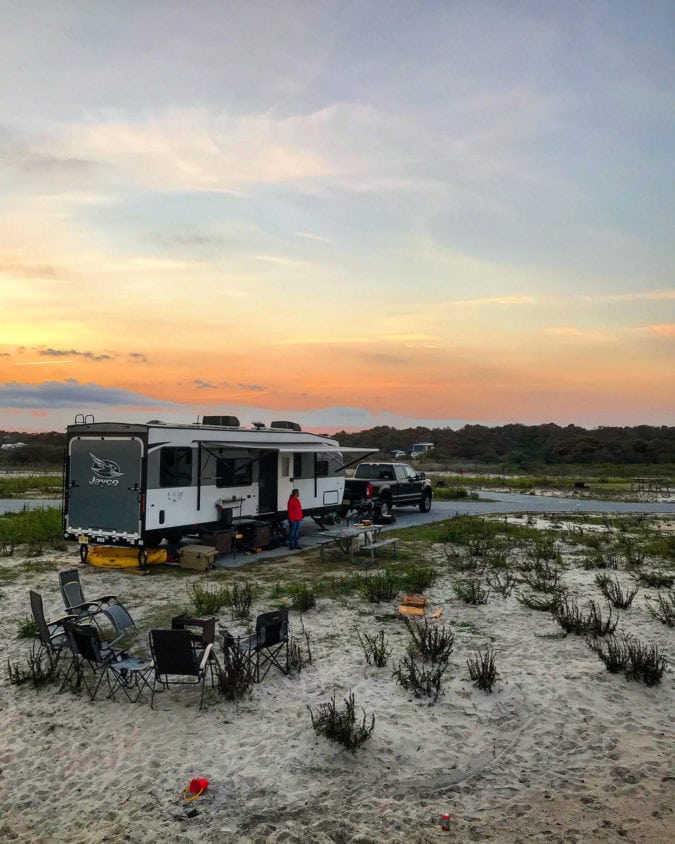
Plan on renting an RV?
The RV rental industry has been growing rapidly over the last decade. If you plan on renting an RV for your next road trip, don’t wait to make that reservation. I highly recommend renting a motorhome that is 30 feet or less, which will enable you to fit into almost any RV campsite out there—public or private.
Related Renting an RV for the First Time
A Class C RV rental will feel similar to driving a U-Haul truck and is fairly easy to maneuver on highways and in parking lots. Smaller Class Bs—think #vanlife—are even easier to drive but offer very little storage or sleeping space. Class As are more like buses and may be intimidating to first-time RVers. You will also be relegated to big-rig-friendly campgrounds and oversize parking spots.
Shopping for your first RV?
If you are currently in the market for your first RV, make sure you purchase a rig that will fit your traveling style. There is no shortage of massive RVs out there with residential refrigerators, massaging recliners, and king-sized master beds. However, these types of RVs are not well suited for roadtrippers who aim to easily move from place to place and stay light on their feet.
Consider set up and break down times. Be aware that gas stops and quick roadside breaks will be more challenging. Also figure out what kind of campground experience you want. Rule of thumb is to purchase an RV under 30 feet long in order to fit into most state and national park campgrounds.
If you would like to boondock or park overnight in free locations, make sure you look for large fresh water, gray water, and black water tanks as you shop. You may also want to look into solar panels or an onboard generator to power your off-grid adventures.
Already own an RV?
If you recently purchased your RV and are itching to hit the road, take a breath and get comfortable with your new home on wheels first. Head to an empty parking lot and practice backing up, parking, and turning. Create personalized checklists for campground departure and arrival. Measure and record the length and height of your rig (including air conditioner). Load your RV with all your gear and head to your local CAT scales to make sure it’s not overweight.
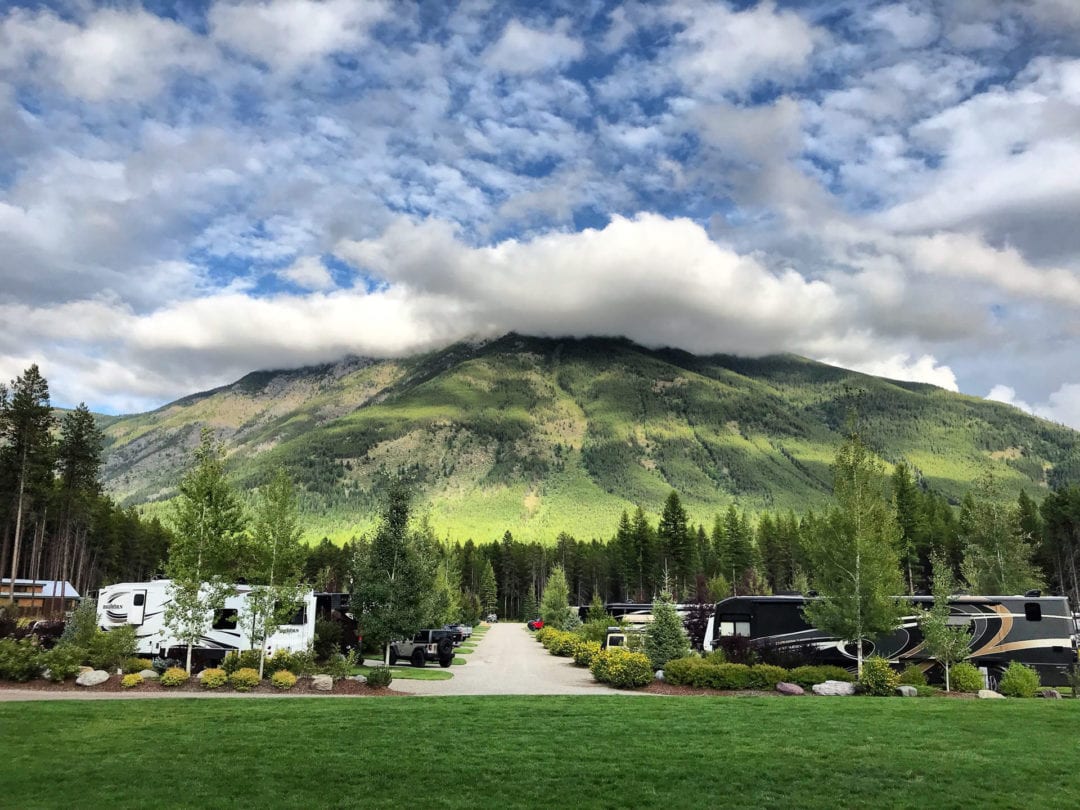
Despite all the compelling reasons to road trip in an RV, this mode of transportation does not come without its own unique set of challenges and concerns. No matter how experienced of a roadtripper you are, you’ll need to make some adjustments when planning an RV road trip.
1. Choose the right RV for the road trip you want to plan
Don’t expect to take the scenic route and play your campground stops by ear in a 40-foot Class A motorhome. On the other hand, you may not be able to stock up on groceries and prepare your own gourmet meals in a 16-foot Class B van. Matching up your rig with your desired adventure is the first step in planning a successful RV road trip.
2. Make a plan that matches your budget
The three most expensive line items for an RV road trip are gas, campground fees, and food. All three of these can vary dramatically depending on the type of road trip you plan. Knowing your RV or tow vehicle MPG will help you plan a route that doesn’t break the bank. Remember, you don’t have to drive across the country to have an amazing adventure.
Having a campground budget will help you feel free to splurge on an RV resort at one stop and then balance that out with some state park camping or boondocking. Some folks save money by overnighting in Walmart, Cracker Barrel, or Cabela’s parking lots instead of pricey private campgrounds by the side of the road. Just call ahead to check on local ordinances.
Related How to find a safe place to park your RV or van for the night
3. Book campsites far in advance of your departure date if possible
The current state of available campsites is a hard pill to swallow for new RVers. Many people dream of hitting the road and letting the wind blow them where it may. Unfortunately, the best state and national park campsites are often booked months in advance, so making reservations is typically recommended. Carefully read online reviews to ensure the campground is a good fit. Make sure the campground has the amenities that you need, whether that’s a pool and hot tub or just sparkling clean bathhouses. Also note any cancellation policies and record them in your smartphone calendar along with the reservation information. This way you are prepared if plans do change while you’re on the road.
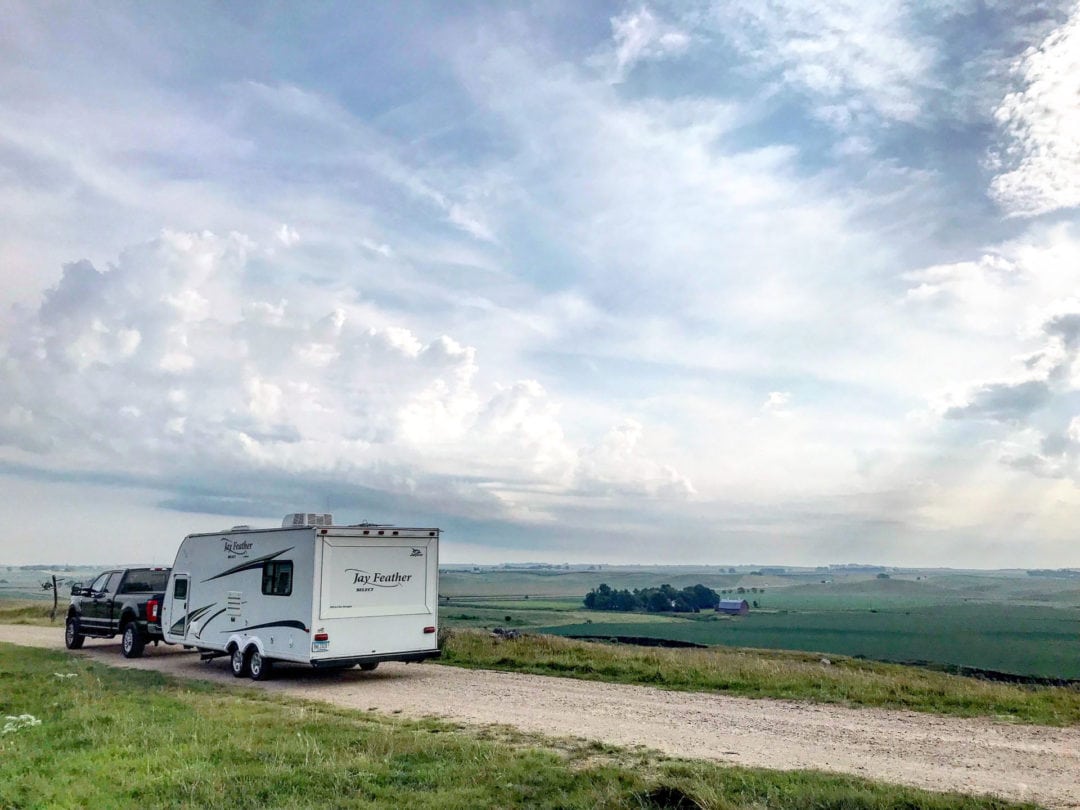
4. Plan an RV-friendly route
Many experienced roadtrippers love exploring the backroads and scenic byways when traveling from point A to point B. You will have to approach route planning differently when taking an RV road trip. Look for any low clearances and propane restrictions for bridges and tunnels. Think about gas stops that won’t land you in a parking lot pickle. Be aware of steep grades or switchbacks that may be tricky to navigate in an RV.
Related What’s the Best Trip Planner?
5. Research RV parking in advance
Seasoned roadtrippers love to find unexpected treasures and make unplanned stops. This becomes a bit trickier when traveling by RV. I usually call ahead to points of interest along our route and specifically ask for details about RV parking. From the Corn Palace in South Dakota to the Bay of Fundy in Nova Scotia, we’ve been able to easily navigate busy tourist attractions armed with advanced parking intel. What about those fun, unplanned stops that pop up along the way? Check the satellite map view on your smartphone to see if you will be able to navigate in and out of the location before committing.

Take an RV-safe road trip with RV GPS, now available with a Roadtrippers Membership
6. adjust your estimated time of arrival.
One of the most common mistakes new RV roadtrippers make is expecting to move at the same pace as when traveling by car. That’s not going to happen, so it’s important to have reasonable expectations when planning your itinerary. An easy rule of thumb is to plan an average route speed of 50 miles per hour. This accounts for generally slower speeds, but also longer and perhaps more frequent gas stops. Driving an RV takes a lot more focus than a car, and first-time RVers are often surprised that they are tired after a shorter time behind the wheel. For this reason, some RVers follow the 3/300 rule: Drive no more than 300 miles in a single day and arrive at your destination no later than 3 p.m.
After hundreds of days spent roadtripping in an RV over the last decade, I clearly enjoy hitting the open road with my home on wheels. I’m willing to trade a bit of flexibility for a whole lot of comfort. Find the right rig, plan ahead, and adjust your expectations a bit. Then get ready to have an amazing road trip adventure.
Meet the Author

Roadtrippers
Roadtrippers helps you find the most epic destinations and detours—from roadside attractions to natural wonders and beyond.
- Related Articles
- Latest Articles

Common road trip scams (and how to avoid them)
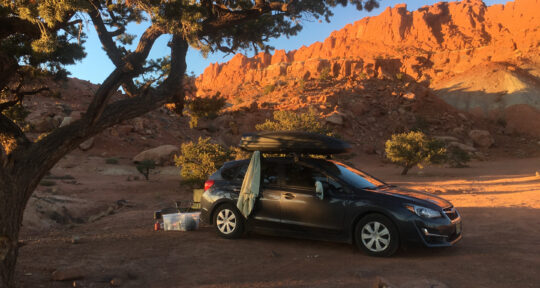
The ultimate guide to car camping
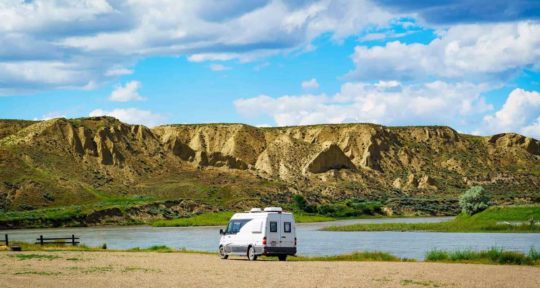
How to find a safe place to park your RV or van for the night

The most underrated route 66 motels

Long weekend trip itineraries around the U.S.
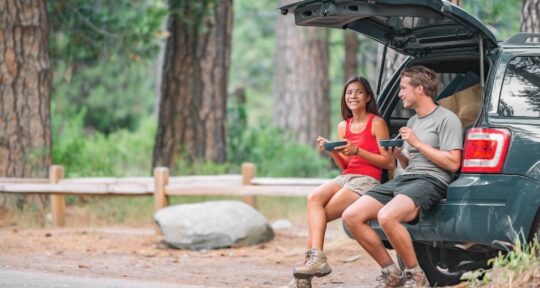
The best foodie road trips for Southern eats
Get the most inspiring stories from the road sent directly to your inbox..

- Sign up Log in Sign out
- Log in Sign out
Plan your journey, find amazing places, and take fascinating detours with our app.
If you used to sign in with Roadpass, you should now use the same username and password to log in directly with Roadtrippers above.
We couldn't find an existing Roadtrippers account using that service. Please try signing in with another option.
We need your email address to send you trip itineraries and other updates.
How do you want to plan your trip?
With just a few questions, our newest Premium feature, Autopilot, will plan your next adventure.


This post may contain affiliate links or mention our own products, please check out our disclosure policy
14 RV Travel Tips From Seasoned RVers
- August 7, 2021
- 12 Comments
Table of Contents

These RV travel tips will improve your camping experience. Photo via Shutterstock
Do You Know About These RV Travel Tips From Seasoned RVers?
If you’re new to RVing, these RV travel tips will make a huge difference in your camping experience. If you’re a seasoned RVer, you may have already learned some of these things the hard way, but there may be some tips you had not yet considered.
1. Plan ahead
It is always less stressful when you have a plan and you are executing it. When we first started RVing, the only tools we had were large paper maps, a notebook, and the Woodall’s Campground Directory. These were crude and ineffective trip planning tools, but it was all we had.
Now you can use RV LIFE Trip Wizard , RV LIFE Campgrounds , and the RV LIFE App with RV-Safe GPS to help you plan everything from how far you can travel comfortably in one day, to where to get gas, how to find RV camping resources that are part of your membership clubs, and what route to take to avoid unsafe roadways.
2. Shorten your travel distance to a comfortable drive
There was a time, many years ago, when we would drive our 33’ motorhome for 12 hours straight. We were weekend warriors then and were only able to cobble together a few extra days for a bit longer trip on rare occasions.
When the 4 th of July fell on a Wednesday, we celebrated because we generally would expand that into a 5-day weekend. On those occasions we’d try to get as far away as possible, but that meant we were driving long distances over many consecutive hours.
Fortunately, I was younger then and I found driving the RV to be about as relaxing as driving a car, but looking back on it now, I have to admit, there were many times I should not have done that because it just wasn’t safe.
Everyone has their own threshold of driving tolerance. For some who can get on the road early, it may be 400 miles. For others, it may only be 200 miles or maybe you want to limit your day by drive time, not miles.
RV LIFE Trip Wizard lets you do just that. You can plan your drive time by distance or hours and set distance rings radiating out from your current campsite, so you know about where you’ll be at the end of any travel day. You can download the maps and info so even if you’re high in the mountains with no cell service you still have your trip information.
Regardless of what your personal preferences are, you should limit the time you spend behind the wheel on travel days.
3. Get your chores done early to get an earlier start
When you know you have a travel day coming up, get as many of your chores done ahead of time as you can. Get the laundry washed, folded and put away, the refrigerator stocked up, boil some eggs, make your sandwiches, get your truck gassed up before you hook-up to the trailer, and pick-up and stow the gear around your campsite, so on travel days you can get as early of a start as possible.
4. Watch the weather
One of our top RV travel tips is to watch the weather on your travel days. If the temperature plummets and the roads are icy or frosty, you may need to alter your travel plans.
Don’t take chances on snowy, icy, or frosty roads. It’s hard enough to drive a car in these conditions, but having the extra weight of an RV can make those conditions extremely dangerous.
Don’t be caught off-guard. Even heavy rain and wind can be dangerous when driving an RV or pulling one. Get several good weather apps and study each one to see which one most reliably predicts the weather wherever you are.
One app may say the winds will be mild while two other apps report high wind warnings. After using these apps for some time, you’ll get a sense of which ones are typically more accurate.

One of our top RV travel tips: Watch the weather! It can sneak up on you. This was a bright sunny day, 20 minutes before this storm overran the RV park in Eastern Oregon. Photo by P. Dent
5. Stay south of the snow zone
By planning your travels using RV LIFE’s RV LIFE Trip Wizard , you can plan to be south of the snow zone year-round. If you’re a full-time RVer, then being a snowbird (going south in the winter and north in the summer) makes sense. You may want to spend your summers up north to enjoy the milder temperatures and lovely places to camp, but even birds know when it’s time to head south.
Don’t wait too long and get caught in snowy conditions. It makes it much harder to travel after the weather turns cold and it can be hazardous and uncomfortable to be in an RV in extremely cold weather.
6. Know when to postpone your travel plans
Driving an RV or pulling a trailer or 5 th wheel in extremely windy conditions can be both stressful and dangerous. In our travels, we have seen several rigs on their side because of the wind.
Recently, a truck pulling a trailer was forced off the side of a bridge over a 200-foot canyon on I-84 in Idaho. The trailer was lying on its side near the edge but still on the bridge. The truck and its occupants were completely off the bridge and were dangling precariously with only the safety chain between the truck and trailer holding them there.
The couple and their two dogs were successfully rescued after the longest hour of their lives, as they dangled helplessly hundreds of feet above the river and wondered if the safety chain would hold. This accident was the result of the strong winds blowing across the bridge.
I’ve driven our motorhome in heavy winds and frankly it’s exhausting. It feels like you’re continually fighting to maintain lane control and every overpass and passing truck creates more challenges. If you can postpone your travel plans and let the heavy winds blow on by, I’d recommend it. At the very least, if you must drive in strong winds, think about shortening your trip, and at the very least….slow down.
7. Know your RV dimensions
The new online apps, especially the ones from RV LIFE , have taken most of the stress out of planning, navigating, and locating suitable stopping points in your journey. Now with RV-Safe GPS , your specific RV dimensions are calculated into your route planning. You get turn-by-turn real time navigational information which will get you exactly where you want to go.
If you want to experience the frustration of just using paper maps, turn all your apps off and just reference whatever paper maps you happen to have in your rig. You’ll quickly discover that paper maps don’t have all the roads, just the major roads, and figuring out what exit to take is more of a guessing game than a certainty.
I’ve done it both ways, and frankly I can’t figure out how we ever got to our destination before the creation of RV LIFE Trip Wizard and the RV LIFE App . These aren’t just handy in an RV, they are a necessity.
8. Read campground reviews
The same thing can be said for RV LIFE Campgrounds . This RV LIFE website goes hand in hand with RV LIFE Trip Wizard . You can see all the campgrounds along your route near your next stopping point, which is calculated by either distance or drive time.
You can even sort these parks by your preference for memberships, amenities, or park types, etc. Then by referencing the integrated RV LIFE Campgrounds, you can see what other RVers have experienced in these campgrounds. Before all this was available, we used the big Woodall’s Campground Directory as our only guide to finding a campground in an unfamiliar location.
The problem was the ads were about ½” high and 3” long. All that could be listed was the name, address, and phone number for the campground. But back then, cell phone hadn’t yet been invented, so calling a campground from the road while you were driving to that stopping point was not practical.
We would pick a likely campground based on nothing more than its name, try to find it by using our paper map, which often turned into a frustrating exchange between the navigator and the driver. When we finally arrived at a campground, we learned quickly to park the motorhome on the outside of the campground and walk into (and sometimes through) the park to see if our 33’ motorhome would fit and if there was room enough to turn around without removing the toad.
Now with RV LIFE Campgrounds , you can read all about the park, amenities, interior roads, any surprises on the road as you approach the park, and so much more. With one-touch dialing on your cell phone, you can call ahead and reserve a space, and then navigate right to the park without any battles between the navigator and the driver.

9. Travel in the daylight
This one RV travel tip will eliminate so much stress on travel days and if you’ll make it a habit, you’ll also be much safer as you travel. Just make it a rule: Always drive in the daylight. It’s easier, safer, and more enjoyable.
If you need to cover more distance, then leave earlier. Driving in the daylight will greatly reduce the likelihood that you’ll hit an animal in the roadway, or encounter a drunk in your lane. If you have trouble with your rig and you’re broken down on the side of the road, it’s much safer in the daylight, and you’re more likely to find the help you need quicker during business hours.
We used to drive long into the night, and I am amazed that we did not get in wreck doing so. Limited visibility, animals in the road, tired distracted drivers, and fatigue, all add up to an accident waiting to happen.
Do yourself and your family a favor and make the commitment to drive your RV only during daylight hours. When you arrive at your destination, it’s easier to navigate within the park and it’s easier to set-up your rig if you can see.
10. Take breaks from driving
Another travel tip many seasoned RVers employ is to take breaks often during your drive time. Just a 10-minute break to stretch your legs, go to the restroom, and get a snack, will make the drive time more relaxing.
Additionally, I would advise you to eat a light lunch. Don’t skip it. The extra fuel will keep you alert, but don’t eat a large heavy lunch because the blood in your body will flow more to your stomach than your brain and that can make you a little groggy. Eat a wholesome light lunch to be as alert as possible.
11. Have a Plan B
Use RV LIFE Trip Wizard to plan your trip, but don’t be too rigid. Have a Plan B. Maybe you experience engine trouble or can’t get all the way to your desired destination before sunset. Maybe you encounter strong winds and need to tuck in somewhere to wait it out. By being flexible and having a Plan B, you will reduce your travel stress.
Everything doesn’t always work out the way you thought it would, and knowing that you’re flexible enough to adapt to whatever challenge you confront will help you enjoy your journey.
12. Keep vehicles in excellent repair
This seems obvious but when you follow RVers on Instagram or Facebook, you’re constantly reading about people who have some difficulty with their rigs, from blown-out tires , to worn-out wheel bearings, to broken hoses, and onboard fires. The more you invest in preventative maintenance , the better off you’ll be out on the highway.
Don’t ignore the basics of oil changes, brake jobs, battery replacement, and certainly get all those malfunctions that just pop up fixed as quickly as possible. The more confidence you have in your vehicles, the less stress you’ll feel on the road.
This goes for both the vehicle you drive and the vehicles you tow. Keep track of all your RV and vehicle maintenance with an online tool like RV LIFE Maintenance , which also sends timely reminders when important maintenance is due.
13. Keep distractions (pets/kids/radio) under control
Driving requires a high degree of attention, but driving an RV or pulling one requires even more attention, so you need to control the internal distractions in order to focus on your driving. Pets wandering around inside your motorhome or kids crying or fighting with one another can be very distracting. Even the radio pulls your attention from outside to inside your vehicle and all of that can diminish your perception of dangerous conditions that are developing in the traffic flow.
If you travel with pets, confine them. If you have children, give them things to keep them busy, and tune the radio to something that you can relegate to a less active level of attention.
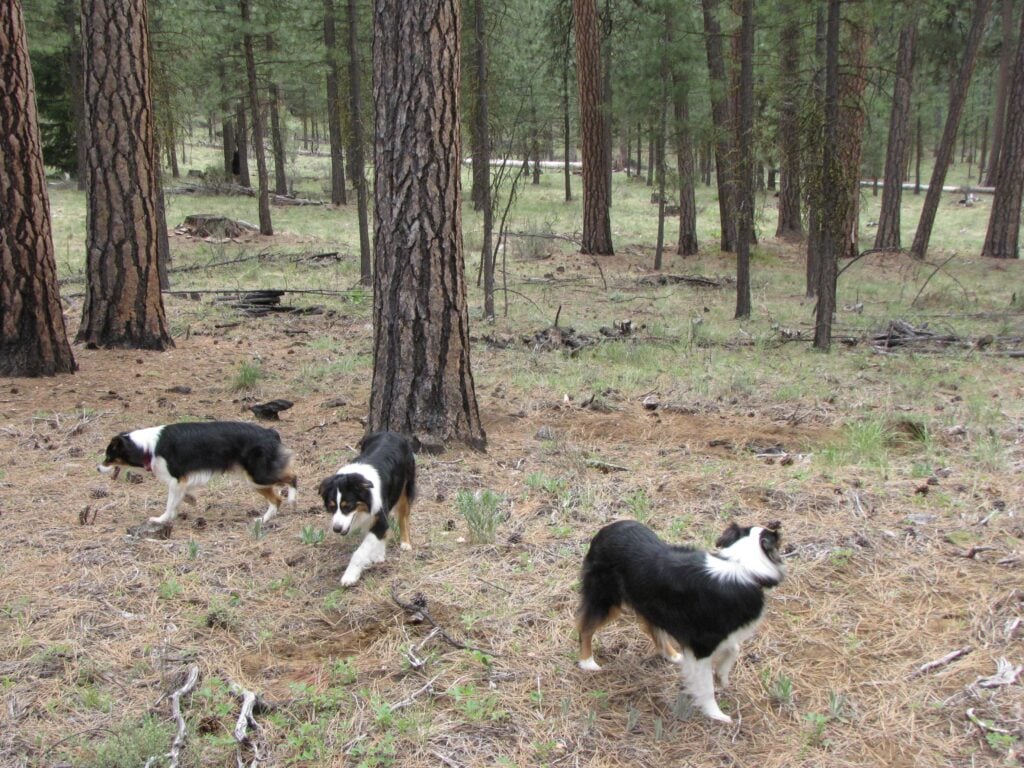
There’s a time and place for pets and kids to play, but not while you’re driving. Keep distractions to a minimum. Photo by P. Dent
14. Don’t drive drunk or drowsy
Some people think a little alcohol won’t affect them. Many think RV driving on pharmaceutical drugs will be okay. But that is not always true. Any amount of alcohol will alter your vision. Some prescription drugs are as bad as illegal narcotics. All of them can slow your reaction time and dull your perception. Both can render you unfit for driving.
If you need prescription drugs, can someone else in your party do the driving? Or can you drive for a short time before taking your drugs? Can your doctor prescribe a drug that is safe for travel days?
Conclusion
All these RV travel tips may seem obvious, but remember to follow these simple guidelines faithfully. If you compromise on drive time, or drive after dark on rare occasions, or let the dogs bark and bounce around while you’re driving, you may be putting yourself and everyone else in danger.
For more RV travel tips, check out this video from EnjoyTheJourney.Life :
The many RV forums online are also full of useful RV travel tips. iRV2 forums allow folks to chat with other RVers online, and get other perspectives on everything RVing, including products, destinations, RV mods, and much more. There are also RV-specific forums such as Air Forums , Jayco Owners , and Forest River Forums .
You May Also Like:
Our top tips for planting an rv garden, what rvers should expect during the 2024 solar eclipse, embracing the full rv experience: find joy in every moment, catching up with the border hookups, rv snowbirds: should you travel this winter or stay in one spot, unlock your freedom: the 2024 rubber tramp rendezvous by homes on wheels alliance, rvtv continues to expand to new platforms, class a rv vs class c: which one is right for you, setting up camp after dark here’s what you should know.

Peggy Dent is an author , writer, and full-time RVer, traveling around the US and Canada. She’s traveled more than 130,000 miles in a motorhome, over the past 20 years, and is currently writing for the RV industry. You can contact her through her website at www.APenInYourHand.com.
12 thoughts on “ 14 RV Travel Tips From Seasoned RVers ”
All great tips, thank you. The only additional thought, if you or someone in you RV is ill,stay put in your current campground. Go to the campground office explain the situation first thing in the morning, you will find that they will do everything to accommodate you. Letting them know early is the key. Happy Miles.
To put it into a nutshell, USE COMMON SENSE!
This is great! These tips will set you up for success!
I agree with all of your tips except #9. I have a 37 foot class A that I purchased new 22 years ago. I have put almost 95,000 miles on it and probably 85% of those have been night driving. The only times that I have ever had issues have been when I was driving during the daytime. At night there is less traffic, less heat, no sunlight blinding and fewer distractions. I maintain my rig well, I plan ahead and I never drive tired.
LOL I just wrote a much longer diatribe on just about exactly what you just said. I’ll take the peaceful night drive over the hectic daytime, every time.
Drive at night. It is cooler and there is MUCH LESS traffic.
Steer clear of Fun n Sun Resort – Encore Property in San Benito Texas. Residents are experiencing severe continuing flooding conditions, continual damage to residents RV/MH caused by contract lawn personnel, numerous water outages lasting for hours, etc. This is an Equity Lifestyle Property headquartered in Chicago.
One thing I always tell myself when I hook up the camp trailer is “I’m in no hurry!” Once we’re on the road we get there when we get there. With good planning it’s a comfortable drive. Even with traveling the interstate highway system I figure 60 mph or a mile a minute is fast enough to my family and our RV safe. Happy Trails!
We have been RV’rs for well over 30 yrs and I would add to your refridge fan idea that we take a 110V computer fan, mount it at an angle upward, screwing it to the plastic cover with small screws and light metal straps. It is located as your outside fan BUT stays inside the cover and runs anytime we are on shore power or generator and does not leave the back of the refridge open to the elements. In a camping club and I have made this mod to most ALL our group and the difference is worth the effort. Hope this helps.
When getting ready to leave a campground, if I have a long drive day planned, I like to fill, then dump my black & grey tank night before. Unhook water and just use onboard water. Then in AM just unhook electric, bring in the slide and go.
ITEM 9 I disagree. While driving at night does indeed have its dangers, driving at night eliminates many dangers that are present during the day and not at night. Impatient drivers trying to get to/from work, child care, or that store with the big sale that’s about to close. Far more vehicles and much higher speeds of those vehicles. Most drivers have substandard skills. For this reason we mechanics call them “aimers”. NOTE: this is true of the vast majority of RVers as well. Higher temperatures (in warm months) that can negatively impact tires, engine cooling, and passenger comfort if environmental systems are taxed. Potentially blinding glare of the sun depending on travel direction. Do you really want to be driving east or south between sunrise and noon? How about west or south from noon to sunset? NOTE: we are north of the equator so the sun is never to our north in the US and Canada.
Yes you could break down in the middle of the night but if you break down in the middle of the day there are far more vehicles with the potential to crash into you as they scream down the road on their cell phones, eating a big mac, or reading….. yes I have literally observed people reading a book and even a news paper (back when they were common) while on a 6 lane freeway in heavy traffic. Just be prepared. Be prepared to take care of as many situations as possible. A spare tire, jack, wrench, ability, and knowledge as well as close monitoring of vehicle performance will cover the vast majority of break downs while under way (flats and over heating). You should also, day or night, always have emergency triangles, multiple communications methods (two cell phones on the same carrier is ONE method) such as CB, HAM, satellite, cell, etc. I’ll drive in the quiet hours of the night, stop short of any destination, then make the short jog over to the destination in the morning (or check in time the rare times that I will pay for an RV Park(ing) space). For those uncomfortable driving at night, have at the daylight roads and their hazards. I’ll chose the slower pace and much more peaceful experience of driving at night.
Leave a Reply Cancel reply
Your email address will not be published. Required fields are marked *
Save my name, email, and website in this browser for the next time I comment.
Welcome! Please follow these guidelines:
- Be kind and respectful.
- Keep comments relevant to the article.
- Avoid insults, threats, profanity, and offensive remarks.
- Refrain from discussing gun rights, politics, or religion.
- Do not post misleading information, personal details, or spam.
We may hide or remove comments at our discretion.
I have read and accepted the Comment Guidelines and Privacy Policy *
Recent Posts

- 10 Essential Tips to Keep Your RV Fridge Cool in Hot Weather

Browse By Category
Orders with Multiple Items Automatically Keyed-Alike

- Tips & Tricks
- Travel Guide
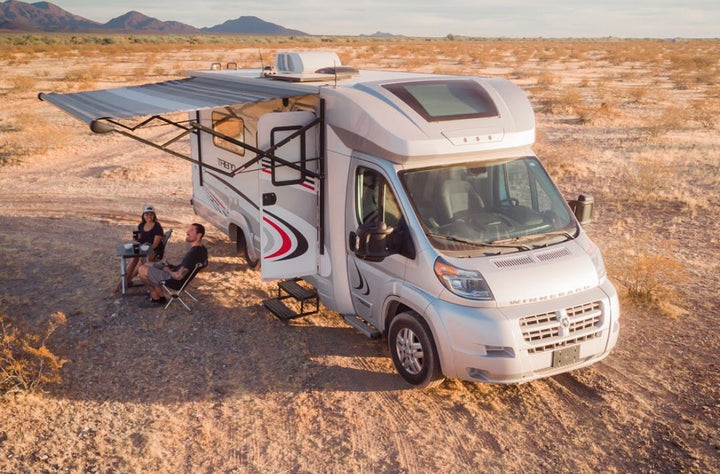
Your Ultimate Guide: What to Know Before Buying a Class C Motorhome
When it comes to hitting the open road with comfort and versatility, Class C motorhomes are a sought-after choice for RV enthusiasts. These mid-size motorhomes strike the perfect balance between Class As and Bs, offering a blend of amenities and affordability. From their compact yet spacious design to their maneuverability on the road, Class Cs are a popular option for families and adventurers alike. But before you embark on your journey, let's dive into the world of Class-C motorhomes and address some burning questions you may have:

Why Should I Consider Purchasing a Class C RV?
If you're seeking the perfect blend of space, mobility, and accessibility, a Class C RV is a compelling choice. Designed to cater to families who desire more room than a camper van but greater maneuverability than a Class A motorhome, Class Cs offer the best of both worlds. With lengths typically ranging from 25 to 35 feet, these motorhomes can still navigate national and state parks with ease. Many Class C RVs are built on Ford chassis, providing convenient access to automotive dealerships and service centers across the United States. Not only are they easier to drive than larger motorized RVs, but they also boast a tighter turning radius and less wind drag. Furthermore, Class Cs often feature decent towing capacities, allowing you to bring along an average-sized vehicle for your excursions.
What Is the Difference Between a Class C and a Class A Motorhome?
The primary distinction between a Class C and a Class A motorhomes lies in their size. Class C RVs are generally shorter in length and height compared to their Class A counterparts. This compact size offers several advantages for Class C motorhome owners. Firstly, it allows for greater maneuverability, making it easier to navigate through tight spaces and winding roads. Additionally, the smaller size of Class C motorhomes enables them to fit into a wider range of parks and campsites. They also tend to have better gas mileage compared to Class A motorhomes. However, it's important to note that the smaller size of Class C motorhomes translates to less interior space, including sleeping and storage areas. On the other hand, Class A motorhomes typically offer more generous sleeping and storage options, making them a preferred choice for those seeking greater living space. Another distinction between the two is that Class C motorhomes feature a front-end engine similar to a truck or SUV, allowing for easier accessibility, while Class A motorhomes often have the engine located within the interior or underbelly of the RV.
What Is the Difference Between a Class C and a Class B RV?
Class C RVs are larger than Class B campers and are built on heavy-duty truck chassis rather than van chassis. This size difference translates into several distinct characteristics. Class C motorhomes offer more sleeping and storage space, often featuring a full bath and at least one slide-out for expanded living areas. On the other hand, Class B camper vans usually come with a wet bath and lack slide-outs. Another advantage of Class B RVs is their better gas mileage and ability to park in smaller spaces due to their compact size. However, Class C motorhomes excel in providing more amenities and comfort for extended trips. Choosing between the two will depend on personal preferences, with Class B campers being more fuel-efficient and maneuverable, while Class C motorhomes offer more space and amenities for a comfortable travel experience.
What Questions Should I Ask When Looking to Buy a Class C RV?
When embarking on the journey to purchase a Class C motorhome, it's essential to be well-prepared and armed with the right questions. While the list may not cover every aspect, here are some crucial inquiries to consider. Firstly, inquire about the fuel efficiency, asking about the average miles per gallon both in the city and on the highway. It's also important to determine whether the engine is gas or diesel-powered, as this can impact performance and maintenance costs. Additionally, find out the expected lifespan of the tires and how often they will need to be replaced. Consider the sleeping capacity and whether the RV comes with a warranty service package. Other crucial factors to address include the size of the propane tank and its usage duration, the capacity of the black and gray tanks, and whether the dealer can provide a comprehensive walk-through of the RV's features and amenities. By asking these key questions, you can make an informed decision and ensure that your Class C RV meets all your requirements.
What is the Best Class C RV on the Market?
When it comes to the best Class C RV on the market, there is a wide range of options to choose from, each offering its own unique features and advantages. Class C motorhomes strike a perfect balance between size, price, and amenities, making them a popular choice for a diverse range of campers and RVers. The ideal Class C RV will depend on your specific needs and preferences. It's crucial to consider factors such as floor plan, layout, size, and desired features. Some renowned brands in the Class C RV category include Winnebago, Jayco, Thor Motor Coach, and Coachmen, among others. Researching customer reviews, comparing specifications, and visiting dealerships for test drives can help you make an informed decision and find the best Class C RV that aligns perfectly with your camping and travel aspirations.
What Upgrades Should I Make to My Class C Motorhome?
Once you've acquired your brand new Class C motorhome, you may want to consider making some upgrades to personalize and enhance your RVing experience. Upgrading your rig is a highly individual choice, tailored to your specific needs and preferences. Some common upgrades for Class C motorhomes include interior layout modifications, exterior enhancements, and decorative changes. However, one essential upgrade that is recommended for all Class C motorhome owners is replacing the door handle with an RVLock. The factory-installed locks on most RVs can be unreliable and susceptible to master key access. RVLock offers keyless entry locks specifically designed for Class C motorhomes, providing maximum security and peace of mind. By upgrading your locks with RVLock, you can ensure the safety of both yourself and your belongings during your travels.

On Average, How Many People Can Sleep in a Class C Motorhome? What Are Some Common Sleeping Arrangements and Layouts?
A Class C motorhome typically offers comfortable sleeping accommodations for a range of four to eight people, depending on the specific floor plan and length of the RV. Most Class C motorhomes feature a queen-size bed that can comfortably sleep two adults, a convertible dining table that can accommodate two children or one adult, and an over-cab bunk space that can accommodate two additional adults. The flexibility of these sleeping arrangements allows families and groups to enjoy their travels with ample sleeping space for everyone. Additionally, larger Super C RVs may even provide sleeping options for up to ten people, making them suitable for larger families or groups of friends. With various sleeping configurations available, Class C motorhomes offer versatility and comfort for a restful night's sleep during your adventures.
Can a Class C RV Tow a Car? How Can I Figure Out If My Class C Can Tow a Vehicle?
Yes, it is common for a Class C motorhome to have towing capabilities for a small car or vehicle. The towing capacity of a Class C RV typically falls within the range of 3,000 to 8,000 pounds. To determine if your specific Class C motorhome can tow a vehicle, there are a few key factors to consider. Firstly, you need to find out your RV's Gross Vehicle Weight Rating (GVWR), which is the maximum weight the RV can carry without any additional load. Secondly, you should identify your RV's Gross Combined Weight Rating (GCWR), which represents the maximum weight of the fully-loaded RV with a towed vehicle attached. By subtracting the Gross Vehicle Weight from the Gross Combined Weight, you can determine the maximum weight your RV can tow. It's important to ensure that the weight of the car or vehicle you plan to tow falls within this towing capacity. Additionally, it's crucial to check if your specific car is suitable for flat towing or if it requires an alternative method such as using a dolly. Always refer to your RV and vehicle manuals or consult with the manufacturer for accurate towing information and guidelines to ensure a safe and compatible towing setup.
Where Can I Park a Class C RV?
Class C motorhomes offer a range of parking options due to their manageable size. With lengths typically ranging from 25 to 35 feet, Class C RVs can fit into various camping and parking locations. National and state park campgrounds often accommodate smaller Class Cs, providing access to beautiful natural settings. Additionally, there are standard campgrounds, RV resorts, national forests, Bureau of Land Management (BLM) land, rest stops, and select public parking lots that can accommodate Class C motorhomes of any size. For veterans or Department of Defense employees, military bases may offer parking options as well. Whether you prefer a scenic campground, a convenient rest stop, or an RV resort with amenities, there are plenty of parking choices available for Class C motorhome owners to enjoy their adventures.
How Much Do Class C Motorhomes Cost? What Impacts the Price?
The cost of Class C motorhomes can vary depending on several factors. Smaller Class Cs with basic amenities can have a starting price around $50,000, while larger Super Class C RVs with luxury features can exceed $200,000. The price of a Class C motorhome is influenced by various factors, including its overall size and length, the number of bedrooms it has, the materials used for the exterior and interior (such as rubber, fiberglass, aluminum, marble countertops, hardwood, stainless steel), the type of engine (diesel or gas), the size of holding tanks and batteries, and any additional features and amenities. It's important to consider these factors when determining the cost of a Class C motorhome and to budget for additional expenses such as sales tax, insurance, dealer fees, and registration fees.
In conclusion, Class C motorhomes offer a versatile and affordable option for RV enthusiasts seeking a balance between space, mobility, and amenities. These mid-size motorhomes provide the best of both Class A and Class B models, combining ample sleeping quarters and storage with maneuverability and accessibility. Ideal for families and campers, Class Cs are easier to drive, fit into various parks and campsites, and offer towing capabilities. However, it's important to consider factors such as fuel efficiency, maintenance, sleeping arrangements, and desired upgrades when purchasing a Class C RV. With proper research and asking the right questions, you can find the perfect Class C motorhome that fits your needs, allowing you to embark on memorable adventures on the open road.
See you on the road.
← →
Gerri Lyttle on October 28, 2023
Brand new at this. Any suggestions
Leave a comment
Please note, comments must be approved before they are published
Health and Safety Tips for RVing with Dogs
RVing with Dogs: Tips for a Safe and Enjoyable Journey
Best Things to Do in Bar Harbor, Maine
Choose the ID of the Quiz you want to render (link popup, external link popup, email link popup):
- Fit Guide #quiz-OGHO2E (internal) or https://www.rvlock.com/#quiz-OGHO2E (external, email)
Would you prefer to share this page with others by linking to it?
- Click on the HTML link code below.
- Copy and paste it, adding a note of your own, into your blog, a Web page, forums, a blog comment, your Facebook account, or anywhere that someone would find this page valuable.
2018 Thor 21F Four Winds Class C Motorhome
2010 Fleetwood Pulse 24D Class C Motorhome
Above Graphics Courtesy of: http://www.DeMartini.com
WE'RE THE RUSSOS
Live Free and Explore! Blog about RV Living and Travel.
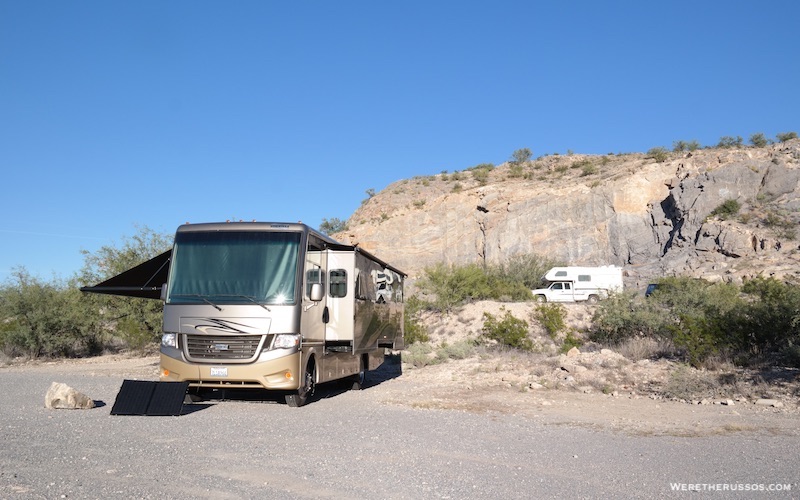
RV for Beginners – 16 Things Every New RVer Should Know
Some of the links below are affiliate links, which means we will earn a commission on the products or services you purchase using the links. There is no additional cost to you and the earnings help keep this website running. Read the Affiliate Disclaimer for more information.
If you’re a new RVer, you’re probably overwhelmed by the amount of information out there about RVing. When we became full-timers , we certainly were. In this post, we pieced together information about RV living that we learned since we hit the road in 2015. With so many new RVers these days, we wanted to share these RV tips for beginners all in one place.
If you’re reading this, and you’re a first-time RVer yourself, welcome! These RV tips for newbies are designed to get you started with enough information to get out there quickly and safely. Even experienced RVers can learn a thing or two here.
We’ve compiled links to our most helpful articles—and written some new content too—so that you can learn everything you need to know to get started as a new RVer . . . Without having to spend hours doing research.
If you’re looking to buy your first (or second or third) RV and need help, I offer one-on-one coaching . I can help you find the right RV for you and walk you through many of the things you may not have considered yet that only a seasoned RVer would know. I can also walk you through how to buy an RV and help you avoid common pitfalls which will save you money. For example, did you know you might be able to get a solar tax credit for your RV? If you’re interested in learning more, click the button below.

RV for Beginners – 16 Things to Know
Table of Contents
#1: How to Shop For and Buy an RV

If you don’t own an RV yet, but are on the hunt for one, we’ve written a couple of articles on the subject already:
- How to shop for and buy an RV
- What are the pros and cons of buying an RV new vs used ?
We’ve also have a library of RV, truck camper, and trailer tours on our YouTube page. If you want to see different brands and floor plans, check out these RV tours:
- Class B camper van tours
- Best RVs under 30 feet
- Small travel trailer tours
Because we’ve never towed our home, we don’t have any resources on how to match tow vehicles to trailers. But we’ve seen RVers led astray by salespeople who want to close deals. So if you’re shopping for a tow vehicle or a towable RV (or both), check out this article by Marc and Trish at Keep Your Daydream for safety information on GVWR and payload.
Which is the best RV? This is a question we get a lot and unfortunately it’s not something we’re able to answer. The best RV is the best RV for you. We can’t tell you what kind of RV is right for you, because that answer is different for everyone. We can tell you that there’s no such thing as the perfect rig, and you likely won’t find it the first time out. The best thing to do is to come up with a list of must-haves and figure out a rough idea of how you plan to use the RV. Then narrow down which RVs fit your must-haves and travel style. For example, a Class A RV that is great to spend a few weeks at a time at a campground is not going to be something you take overlanding and vice versa.
We started with a Class A motorhome towing a Jeep Wrangler and worked our way down to a 4×4 truck camper over time, because a small vehicle works best for our travel style. But there’s no way we could have known that when we first started. The important thing was that we picked the RV that worked best for us at the time.
#2: How to Rent an RV
If you’re not ready to commit to buying an RV yet, you can still enjoy the perks of RV travel by renting one. When we started researching RVs back in 2014, there were limited RV rental companies. Now, there are many options from local outfits that specialize in Class B vans to national rental companies like Outdoorsy and RVShare .
These large RV rental companies essentially provide a marketplace for RV rentals. Private owners list their campers for rent and you can search for the make and model of your choice, based on what’s available in your area. You can even search for specific brands that you’re interested in buying such as a Storyteller Overland MODE4x4 or a small travel trailer less than 3,500 pounds .
Maybe a luxury Class A motorhome or a fifth wheel toy hauler is more your style. Whatever RV you’re interested in renting, you can probably find it, it’s just a matter of price and availability.
Even if you do intend to buy, renting an RV is a good first step. It will give you a better idea of what it’s like to live in that space and better help you refine that must-have list I mentioned previously. We rented a Hymer Aktiv to travel around Maui and that was through Outdoorsy . Read about our RV Rental Experience on Maui.
#3: A Tour of RV Types (or “Classes”)
If you’re a brand new RVer, the different categories of RVs can look very strange. What does “Class B” mean, and why is it smaller than a Class A and a Class C?
We remember how it felt to be a bit lost in these classifications as RV newbies, so before we go any further, we thought we’d share a quick overview of the different types of RVs out there:
Motorized RVs
- Class A : Our first RV was a Class A motorhome . These are the big rigs that look like buses, with a flat nose and large windshield up front. They can range from around 25 feet to 45 feet, and come in both gas and diesel models. Below is a walk-through video of our first RV.
- Class C : When you think of a classic motorhome, you probably think of a Class C RV. They have the cab-over bunk bed or storage and are built on a truck chassis, usually Chevy or Ford.
- Super C : It’s hard to miss Super C RVs on the road. They’re still built on a truck chassis, but the truck chassis is a heavy duty over-the-road semi truck like a Freightliner, so they look more like 18-wheelers than RVs. Below is a factory tour of a custom Super C manufacturer in Indiana .
- Class B+ / small C : “B plus” RVs are technically small Class C RVs , usually somewhere around 25 feet or less in length. They’re built on a van cutaway chassis like a Mercedes Sprinter or Ford Transit, but with a wider and bigger boxlike body than a standard van that allows for more interior space, and sometimes even slideouts. This video tour will give you an idea of a Class B+/Small C RV.
- Class B : Camper vans are Class B RVs and what we currently travel in. These RVs are built on different van chassis and van bodies, so they’re narrower and shorter than other motorized RVs. We have lived out of and tested various camper vans including 4×4 Sprinter and 4×4 Transit Class B vans , a custom Class B Van , and a front wheel drive ProMaster camper van . For a very brief time, we also live out of a DIY camper van that we built . To get a sense of camper van life watch one of our day in the life of videos below or head to our van life video playlist .
- Truck camper : A truck camper is exactly what it sounds like: a camper that sits in the bed of a truck. Watch our truck camper tour below or check out our truck camper life video series .
Towable RVs
We’ve never full-timed in a towable rig, but we’ve toured quite a few and know lots of other RVers who travel in various towable RVs.
- Fifth wheel : The largest towable RV. Fifth wheels got the name because the front pin of the trailer sits in the bed of the truck, so the truck axle functions as a sort of “fifth wheel.” They are tall and usually pretty long, between 30 and 45 feet. Despite their size, since the tongue weight of the trailer sits over the rear axle of the truck, it makes towing more stable.
- Travel trailer : Sometimes called “bumper pulls,” travel trailers hook up to a traditional ball hitch, so the weight of the trailer sits fully behind the truck rather than over the rear axle. Length for these can range anywhere from very short (like small teardrops trailers ) to 30+ feet.
- Pop Up : Most travel trailers are hard-sided, but pop up campers save on height and weight by making use of collapsible canvas sides. As the name suggests, when you get to your campsite, you pop them up to full height for use. These can be towed by many vehicle since they are so light, and some pop up campers even come with all the amenities, including a bathroom. There’s a reason why pop ups have been the go-to camper choice of families for decades.
That’s a wrap on the different classes of RVs available. Let’s move on to the next section.
#4: How to Drive (or Tow) an RV
Driving an RV for the first time can seem scary. When we test drove our first RV, a 45′ Class A motorhome at an RV show , we were sweating! But we got comfortable in the driver’s seat pretty quickly.
Our best suggestion is to find a big, empty parking lot, and practice driving there. Practice tight turns to see how much room you need and watch how the rear (aka the overhang) of your RV swings out. Practice backing up, especially if you’re towing a trailer or a fifth wheel.
In short, get used to the way your RV moves and the space you require.
You can make this fun, too. Set up some cones or upturned buckets in a “slalom” pattern, and see how close you can get to them without actually hitting them or running them over with your rig.
By the time you’ve spent a couple of hours practicing, with no danger of damaging your rig or other vehicles, you’ll feel ready for the road. When you do drive, non-crowded highways are easiest. You won’t have tight turns, narrow roads, or traffic lights to worry about.
Even if you’re an experienced RVer—but especially if you’re first starting—we recommend using a pre-departure checklist before you travel. When you arrive, follow it in reverse order to set up camp. It’s the best way to make sure you don’t forget something important, like retracting the awning, latching drawers or unplugging your power cord from the pedestal, before you head down the road.
We don’t use this gadget anymore since our current rig is small (we have a Class B camper van), but when we first started in our Class A RV, an RV-specific GPS unit was indispensable. You can also use software like RV Life Trip Wizard to plan your route in advance.
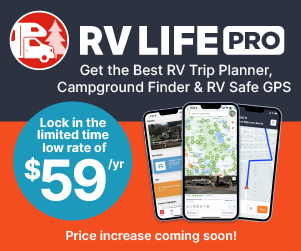
Bottom line, make sure you don’t attempt any road that can’t handle your RV’s dimensions. There’s nothing worse than approaching a bridge or low overhang and not being sure if it will clear your roof (and air conditioner!).
#5: Must-Have RV Gadgets
We created a round-up of must-have RV gadgets . But we know the cost adds up quickly when you start buying stuff to put in your new (or new-to-you) RV.
If you buy nothing else, make sure you have:
- Fresh water hose and a RV Water Filter for getting fresh water at the RV fill station
- Electric cord and adaptors —no matter what kind of electrical cord comes with your RV, it’s helpful to have enough adaptors that you can plug into 20, 30 and 50 amp outlets if you need to
- Surge protector / EMS to protect your RV’s electrical system if it does not come with one built in
- Sewer hose and clear elbow for dumping, if you have a black tank (more on sewer systems below)
- Leveling blocks
- Wheel chocks (if you have a towable RV)
If you love to cook like Kait does, don’t miss our recommendations for the 15 best kitchen gadgets for RVers . Cooking in an RV kitchen is different than cooking in a house, and requires some unique tools with limited space, so we share everything we’ve learned about cooking on the road. Including some fantastic recipes for every RV chef’s best friend: the Instant Pot .
#6: How to Find Campsites
We’ve probably written more about how and where to find great campsites than any other topic. It’s something we get asked about all the time, and it’s one of the things that intimidates new RVers most. Especially if they’re traveling without reservations, the way we do.
The first step in finding the right campsite for you is to identify your travel style. Do you prefer to boondock without hookups for free? Or do you prefer an RV resort experience like the one featured the video below, with lots of amenities, activities and a level concrete pad to park on?
Once you know what type of camping you prefer, you’ll know what to look for.
Here are a few of our favorite resources when it comes time to find a place to sleep in your RV:
- Top RV Travel apps : We put together a list of all of our favorite apps for RVing. Some of them will help you figure out where to spend the night. Others will help you save money on the road or keep an eye on the weather.
- Allstays : It’s on our top RVing apps list, but it bears repeating. You can find just about anything you might be looking for on Allstays: paid campgrounds, free campsites, propane, water, sewer dump . . . you name it. For more information, check out our Allstays Camp & RV App Review .
- Harvest Hosts : This is perfect for those who want to shop local AND find a beautiful place to stay. For a small annual fee, Harvest Hosts allows you to stay at farms, wineries, and other local spots. You usually don’t have hookups, but you might have a vineyard all to yourself for the night. To us, it’s well worth the trade. All the land owners ask in return is that you buy something from them in exchange. And who doesn’t want organic produce or local wine anyway? Read our Harvest Hosts Review .
- Dispersed camping on National Forest land : Sleep under the stars with no hookups, and often no neighbors. This is our preferred way to spend the night and we have quite a collection of videos and posts on the subject.
To read about some of the places we’ve camped in our RVs throughout the years, head over to
- our travel destinations page for a break down by state
- our collection of campground posts
In our first year as full timer RVers, we covered quite a bit of ground and assembled a list of our favorite RV campsites , both free and paid.
#7 Considering Solar for Your RV
If you’re interesting in doing more dry camping / boondocking then adding or increasing the amount of solar on your RV is something you’ll want to consider. Solar panels fall into two buckets: roof mounted and portable. Each have their advantages and disadvantages.
Our Portable vs Roof Top RV Solar Guide will help walk you through both types and what might work best for your situation.
#8: Internet for RVers
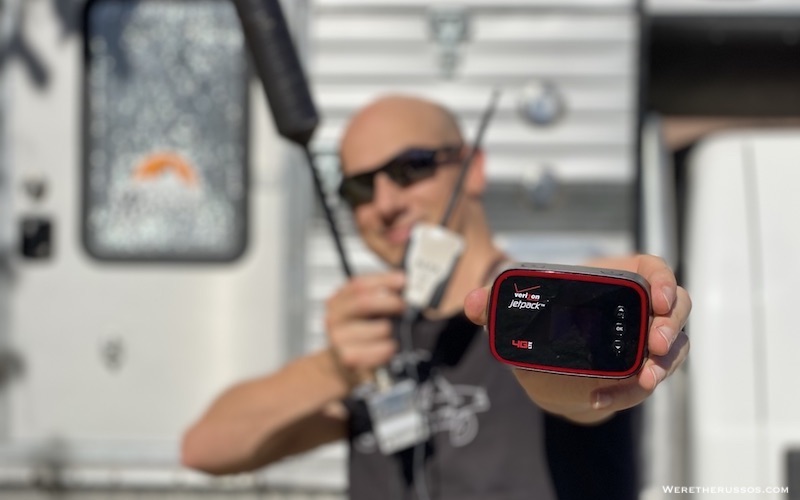
Internet connectivity is a big topic for nomads. Even retired RVers who just want to keep in touch with family and stream the occasional TV show have a lot of challenges. And if you are running a business or holding down a full-time job on the road, the stakes of getting internet connection right are high.
This is such an important topic that we wrote a Guide on RV Internet to help you stay connected.
#9 RVing with Dogs
When we first started RVing, we had two large dogs with us. We learned pretty quickly that it wouldn’t be as simple as putting the dogs in the RV and heading out for the next adventure. There was an acclimation period for them and for us when it came to travel days and living in the RV.
In our Beginner’s Guide to RVing with Dogs , we share tips and lessons to help you get started on RV travel with your four legged family members.
While we don’t have any dogs right now, we did quite a bit of RV travel around the United States with our dogs. There were times where we couldn’t explore a place we wanted to see with the dogs in tow, so we learned a lot about how to leave them behind safely. Some essential items made their way onto our must-have dog gadgets list for RVers .
If you are or will be traveling with a dog, check out some of our dog-friendly posts for ideas on places to visit and things to do. Here are few of our favorite dog friendly activities:
- Biltmore Estate in Asheville, North Carolina
- Bearizona Wildlife Park in Williams, Arizona
- Brewery Hopping in Fort Collings, Colorado
- Camping at Disney’s Fort Wilderness in Florida
- Petrified Forest National Park in Arizona
- Pima Air Museum in Tucscon, Arizona
#10: Hacks for Living Tiny
RV living is similar to tiny home living in many ways. And if you like the mobility of small RVs like ours, you have to get pretty creative on where and how to store things. Even if you’re in a 45 foot Class A diesel pusher you may find yourself benefiting from some of these tiny living hacks.
These are some of the ways we’ve stayed organized with two people in a small space.
#11 RV Toilets
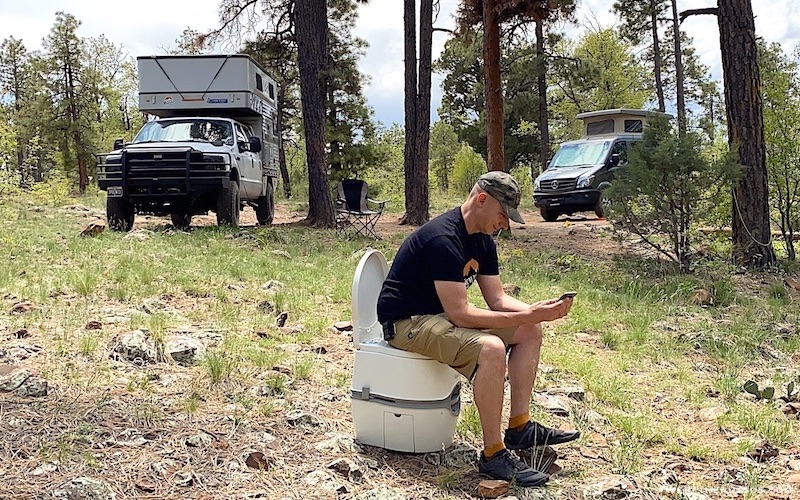
You probably already know that the plumbing and sewer systems in an RV operate differently than they do in a house.
Since you’re on the move rather than stationary, most RV toilets drain into a single holding tank (ominously called the “black tank”) rather than directly into the sewer system. What that means for you is that you’re going to have to empty your black tank or other type of RV toilet.
Luckily, RV dumping is not as bad as it sounds . Do it right, and it’s just a routine chore. Do it wrong and, well … Just read our tips on how to do it correctly.
We’ve owned several types of RV toilets ourselves, so we’ve written a lot of content on this topic. If you have a non-traditional RV toilet setup, or are trying to see if you’d prefer one, here are all of our potty-related posts:
- RV Toilets : A definitive guide to every type of RV toilet under the sun.
- Composting Toilets : Our very first RV toilet was a composting toilet! Here’s our overview of this popular and eco-friendly option for RVers.
- Cassette Toilets : What are they? How do you empty them? Is it terrible? All these answers, and more.
- Portable Camping Toilets : This is what we currently use in our truck camper. We share what it’s like to use a portable toilet, how it works, and more.
Oh, and if you want a to read all about our fling with a composting toilet, check out the post on our 2-week bucket toilet experience here .
#12 Travel Safety and Preparedness
Safety considerations on the road are a bit different than they are at home. The chances of a breakdown are much higher, since you’re likely driving more miles at a stretch—and bringing your whole house with you.
Add the element of being on the move and patchy cell signal in certain parts of the wilderness and you increase the need for being prepared. Since your family and friends may not always know exactly where you are, you need to be able to communicate with the outside world in case of an emergency or breakdown.
That’s why we wrote articles all about RV safety , must-have essential tools to carry in your RV , traveling with firearms in an RV and using a pre-departure checklist before driving off in your RV.
#13 Memberships
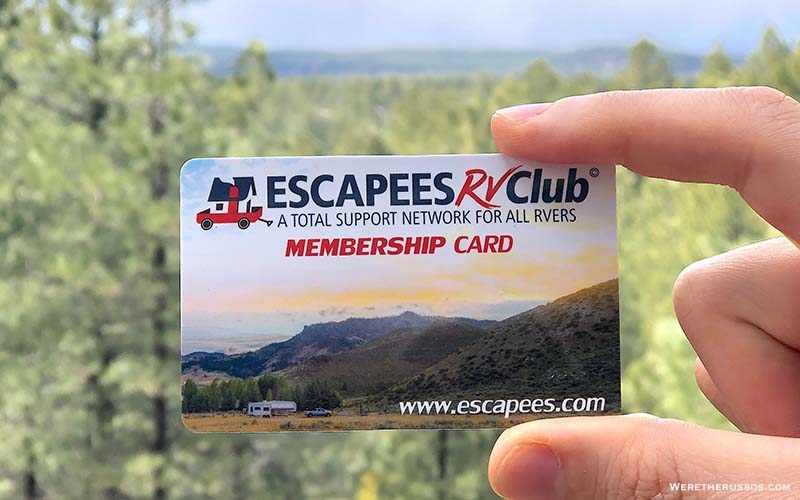
RV memberships can save you a lot of money if you use them wisely. They can also provide you with a built-in community, since you’ll run into like-minded travelers at member campsites like Harvest Hosts . Some memberships, like Escapees , even offer additional services like mail forwarding and permanent addresses for domicile. Check out our Escapees RV Club Review for more information.
This post highlights some of the RV memberships worth having.
#14 Getting Mail

How to get mail on the road is one of the more popular questions we get asked. If you’re traveling for weeks or months at a stretch, or if you’re a full time RVer, receiving mail can be a bit of a challenge.
In this post we detail the different options for getting mail on the road as an RVer —you have more options than you think!
#15 Health Insurance
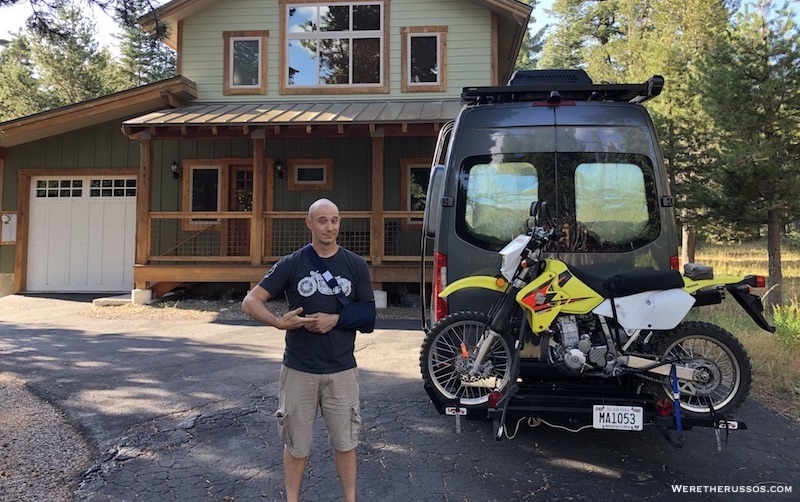
One of the most common topics of conversation around the campfire is insurance for full time RVers. We all hope that we won’t get sick on the road, but want to be prepared if something unexpected should happen. And frankly, navigating the world of full time RVers insurance can be pretty daunting, especially if you’ve never had to find insurance on your own.
In this article about RV Health Insurance , we discuss our experiences with health insurance on the road and available options for fellow RVers.
#16 Get More Use Out of Your RV
While there are plenty of full time RVers out on the road, there are way more part-time RVers who use their camper for weekend getaways or extended road trips. When these RVs aren’t being used for camping, they are likely sitting in storage somewhere waiting for the next adventure.
Since a drivable or towable RV can be quite a costly expense, here are some ways to get more use out of your RV .
Bonus Content
Since Kait and I started full time RVing in 2015, we’ve met a lot of people on the road and many have asked how we did and what advice we have. To help those questions and more, I self-published two books on RV living .

My first book, Take Risks chronicles our journey from coming up with the idea to become full time RVers to researching and shopping for RVs to buying our first RV and downsizing from a three bedroom house into a one bedroom condo on wheels.
My second book, Tales From the Open Road offers a personal account of the mostly good and sometimes challenging adventures (and misadventures) from out first year on the road.
Want to know how much it costs to live the RV lifestyle? We share our Cost of RVing on this page which includes a breakdown of our first year of RV Living costs and the first six months of camper van life. Your RVing costs could be higher, lower or similar based on factors such as cost of insurance, miles traveled along with fuel economy and the number of people in your RV household.
Phew—that was a lot of info and thank you for making it through our RV tips for beginners. As you’ve probably figured out, there’s a lot to learn about RVing, but don’t let it scare you.
If we can leave you with one thing, it’s this: it’s all completely worth it. You’ll pick up new skills you never knew you had, and you’ll see beautiful places in the process.
If you still have questions about RVing that didn’t get answered, let us know in the comments and we’ll try our best to answer them.
And to all the RV newbies out there: welcome! We look forward to seeing you out on the road.
Leave a Comment Cancel reply
9 thoughts on “rv for beginners – 16 things every new rver should know”.
Have been tent camping for some time in my younger years. Now retired and purchased a couples camper and off to the bucket list.. The tips you give are going to be very helpful as this is out first real camper per say… LOL and our first trip is to visit our grandson in Michigan in 2 weeks, And then the big trip from Ohio to California and most all point in between. Wish me luck the first trip is gonna be about 5000 plus miler. But I am confident with all the tips and my driving skills are pretty good. Can’t wait.
I’ve been watching you for a while, hubby and I are going full time since retired. You guys helped me learn about rving thanks
I have a 2009 Sportsmobile campervan with 2 100ah solar panels on the roof. My AGM batteries after 6 years are not holding a charge for long, so i purchased 2 Lithium 100ah Battle Born Batteries LiFePO4 Deep Cycle Battery – 100Ah 12v with Built-In BMS – 3000-5000 Deep Cycle Rechargeable Battery. However, Battle Born says I would need to upgrade my solar comments; charger, inverter, etc. Can you do upgrades or know of any shop that does this type of upgrades? Mahalo Kimo
Hi Kimo – I would suggest finding a company who specializes in solar and battery set ups and consult with them about what components you need. I don’t know where in the world you are but Bend Battery has helped advise us on somethings and we found them to be very knowledgeable. The other option is to call Sportsmobile or Field Van (if your van was built at the Fresno, CA location – Field Van is the former Owners of the Sportsmobile shop at that location) and talk to them since they built your van and would be know.
Hi Joe, this is a great article for beginner RV’ers and some of the things that you point out aren’t things you’d think of unless you’ve spent time on the road, like getting mail!
One thing I didn’t see you mention in the shopping for an RV section is to have it get inspected by a great RV mechanic. I always recommend that you have a big purchase inspected by someone who knows what to look for. Thanks again, I found you on youtube thanks to this article!
Hi Kait and Joe, I have learned from watching your YouTube videos and reading the information you both produce. I decided not to own an RV after you both had planned on selling your house and bought an RV and explained the details and issues that you were having with the RV. Than you both purchased a Van, and now a Ford Diesel pickup with a popup camper. I also had purchased your first book a while back. I am trying to search out on the internet to find what would be the best shelter to live in full time throughout the four seasons for me when I do retire and don’t want it to cost me more issues with it. I was thinking about purchasing a Mercedes Benz 4×4 Diesel 170 wheelbase dual wheels. I guess it’s top-heavy also the cost of maintenance issue when it’s in the dealer shop. I also thought of Airstream Trailers watching Videos on YouTube the Pros & Cons. I plan on traveling to fish and camp since I will not bring in all that much Social Society while retired. I don’t want to be trapped renting a room and not able to travel and do what I enjoy doing. Your Opinions or ideas?
I’m very seriously thinking of buying an RV for my 70th birthday in two years to see the places I’ve only seen from the air. I’ll be traveling alone and am looking for advice. My kids (37 & 40 year old daughters) are shitting bricks over this, like I’m feeble or something. I’m healthy and pretty adventurous and looking for other input…
Something that should be on that list that’s very important. How to properly load your rv and know the weight capacity. You don’t want to be overloaded on GVWR or your axle weight rating. It can cause handling and steering problems as well as blowouts if over weight

- New RVers Guide
- Travel Guide
- Campgrounds
- Boondocking
- National Parks
- Free Camping
- Essential Gear
- Cost of RVing
- One-on-One Coaching

- Find a Location
The Best Class C RVs
Class C motorhomes are shorter than Class A RVs and feature a classic cabover bunk design, which makes them great for families with kids. They typically have a rear queen bed, sleeper sofas, dinettes, and full kitchens. Many Class C RVs offer storage in the trunk, interior pantry spaces, and overhead cabinets. There are even some Class C toy haulers with garage space for your gear.
When comparing the different RV types , Class C campers fall in between Class B camper vans and Class A motorhomes in size. They are often praised for getting better gas mileage than Class A RVs while offering a more residential experience than Class B vans.
Below we provide the range of how much Class C RVs cost, sleeping capacity for a Class C, and their typical lengths and weights.
Picks For the Best Class C Motorhomes
So, what are the best Class C motorhomes? This list combines function and affordability.
Here are some of our favorite class C RVs:
Thor Freedom Elite 22FE

The Freedom Elite 22FE offers plenty of convenience for a small family seeking a great camper to explore the open road. This Class C RV—built on a Ford E-450 chassis—sleeps five people in its 24’ interior. With a slide-out to accommodate a queen bed and a sizable cabover bunk, the Freedom Elite proves why Thor is one of the best Class C RV brands.
- Full bathroom
- Dream dinette
- Three-burner stove
- Minimal bathroom counterspace
Forest River Forester Classic 3011DSF

The Forester 3011DSF can sleep up to seven people. It is 32’3” long and has two slide-outs. One slide-out is in the main sleeping area, which boasts a 60” x 74” RV queen bed with a 12-volt TV and wardrobe closets on either side.
The shower measures 24” x 36” and is across from the RV toilet and vanity. The convertible dinette and sofa provide additional sleeping space in the living area, as does the 60” x 80” cabover bunk.
The kitchen spans the entire camp side wall in the main living area, providing excellent counterspace with a flip-up extension towards the front of the coach. Outside, there’s a 15’6” powered awning, an optional connection for a second 12-volt TV, and abundant storage underneath.
- Built-in step well lock box for added security
- EZ Ryde upgraded suspension system
- Side view cameras
- Color backup camera with a rearview monitor
- Step up to enter the main sleeping area from the living room (tripping hazard)
- Undersized kitchen backsplash
Jayco Greyhawk 29MV

With room to sleep up to six people and a 7’ interior height, the Greyhawk 29MV is great for families that struggle to find a comfortable RV for their taller members. The interior boasts a tri-fold sofa in the living area, which can be swapped out for theater seating.
Equipped with a tire pressure monitoring system (TPMS), power anti-lock brakes, heated side view mirrors, and a 7,500-pound tow hitch, driving this Class C RV is a breeze. You can even find the right dinghy or toad to pull for day trips once you reach your destination.
Our favorite interior amenities include recessed LED lighting, hardwood cabinets and doors, a 30,000-BTU auto-ignition furnace, and a Jayco-exclusive legless dinette table. Outside, you’ll love the marine-grade speakers, exterior utility center, LP quick connect, and Onan® 4,000-watt generator.
- Extra interior height for taller campers (up to 7’)
- 200-watt solar panel with dual controller and a second house battery
- Aater filtration system
- Single bathroom
- Only 8 cubic-foot refrigerator (unless you upgrade to the 12 cubic-foot alternative)
Explore all of our Jayco RVs .
Jayco Redhawk 29XK

Jayco has developed a reputation for consistently building excellent products, which helps cement the Redhawk as another of the best class C motorhomes. The Redhawk 29XK is a front-living model with ample living space thanks to its single slide-out, which houses a U-shaped dinette and a jackknife sofa. This 32.5’ Class C RV sleeps up to seven people. The Ford E-450 chassis and engine will get you where you need to go on your next outdoor adventure.
- Ample kitchen counterspace
- Queen bed in a separate living compartment
- Swivel chairs
- Off-white cabinets
- Abundant natural light
- The shower is separate from the bathroom
- Expensive
Eddie Bauer 22EB
The Eddie Bauer 22EB is a compact 24’1” Class C RV built on the Ford E-350 chassis. The manufacturer lists a sleeping capacity of four, but it includes a 76” dream dinette and cabover bunk that may fit additional kids. It comes with seatbelts for up to five passengers.
On the exterior, you get 50 cubic feet of storage, made possible in part by the lighted MEGA-Storage compartment. We especially love the rear wall-mounted bike and kayak rack, which has a 132-pound weight capacity.
If you like the 22EB, Thor Motor Coach builds three additional Class C campers to explore. Read about those Eddie Bauer RVs here.
- Plenty of sleeping space for a compact Class C
- Cabover television on a swivel
- 50 cubic feet of exterior storage
- 76” dream dinette
- Large 12V refrigerator
- Limited counterspace in the kitchen and bathroom
- Small oven in the kitchen
Winnebago View 24V

Winnebago is a leader in the RV space, and the View 24V helps earn that reputation. This diesel Mercedes-Benz Sprinter camper has a single slide-out and sleeps up to four people.
With a full bathroom, dinette, TrueComfort Sofa, and TV area, this model is perfect for adventurers who want to hit the open road flexibly without leaving the comforts of home. At 25’6”, the 24V is perfect for those looking for a compact Class C RV.
- Separate rear twin beds can be converted to a single
- Space for mounting multiple TVs
- Single slide-out
- Couch can become a proper bed
- Two-burner stove
- Limited kitchen counterspace
Jayco Greyhawk 27U

The Greyhawk 27U is another great gas motorhome under 30’. Its 7.3L V8 325-HP engine is powerful enough to haul a whole family on a cross-country trip. Two slide-outs, a cabover bunk, a jackknife sofa, and a convertible dinette allow seven people to sleep comfortably.
But whoever stays in the primary bedroom will have the best sleep in the house. Their room includes a spacious wardrobe, a private bathroom, and a king-size bed in an east-to-west slide-out.
- Can sleep several guests
- Two slide-outs
- Private bathroom
- Excess wardrobe space
- Galley kitchen
- Not much kitchen counterspace
Entegra Coach Qwest SE 24L

The Qwest SE 24L is a diesel sprinter that can sleep up to five but is equally great for families or couples. Some call these and similar campers a Class B+ , which have a “cut-away” cab chassis and a cockpit similar to a Class B—but we’re sticking with the Class C designation here as Entegra Coach lists the Qwest SE in their Class C lineup.
Built on a Mercedez-Benz 3500 chassis with a 170” wheelbase, driving the 24L will bring as much fun and comfort as camping. The 24L offers an open front living room, rear queen bed, kitchenette with a two-burner stove, and a rear bathroom and shower. A long super slide-out makes everything a bit more spacious.
Pros:
- Plenty of kitchen counterspace
- Bathroom/shower open to guests
- Queen bed in the rear
- 2-burner stove
- Very little primary bedroom privacy
Winnebago Navion 24D

The Navion 24D is another “tweener” built on a Mercedez-Benz sprinter chassis. But because it still includes the cabover bunk, we call it a Class C. It comes in at 25’6” and is easily maneuverable in smaller campgrounds. Inside, you’ll have several sleeping areas for the whole family, starting with the Murphy bed in the coach’s rear.
Now, the floorplan is a bit unconventional. It is more of an open concept. Because of the Murphy bed, the rear is a dedicated living space when not used for sleeping, which makes it feel a bit more roomy. This also allows for a more spacious rear bathroom.
Perhaps the best feature of the Navion 24D is the sizeable U-shaped dinette, which any family or group of friends will quickly make their home base.
- A short RV that can still host guests
- Large overhead cabinets
- Pull-out leg rests on dinette
- Lack of privacy in the primary bedroom area
- The smaller space with a Murphy bed may feel restrictive
Now that we’ve seen some of the best Class C RVs, consider whether a Class C RV might suit you.
Pros and Cons of Class C Motorhomes

Like any motorhome, even the best Class C RVs have pros and cons. If you’re in the market for a new RV, consider the following:
- More space: Class C RVs offer more living space than Class B models, making them an excellent choice for families. These models often include separate sleeping quarters, dining areas, and even bathrooms with showers.
- Plenty of amenities: Class C motorhomes offer campers the comforts of home. Some models include full-size beds, kitchenettes with sinks and stovetops, microwaves, and small refrigerators.
- Easy drivability: Class C motorhomes are smaller and easier to drive than their Class A counterparts. They typically don’t require a special license, either.
- Suitable for long trips: Their size and amenities make Class C RVs an excellent choice for longer trips or extended stays at campsites.
- Cost: Class C motorhomes can cost more than Class B campers, depending on their size, brand, and available features. RV financing is typically available and can help you find the right model for your budget.
- Parking challenges: Even though they’re smaller than Class A RVs, finding a parking spot for a Class C motorhome can still be challenging. Because it’s a camper, your HOA or city may have rules regarding where to park it when it’s not in use.
- Fuel efficiency: Class C RVs tend to be less fuel efficient than smaller Class B RVs or passenger vehicles because they are bigger.
Do You Need A Special License To Drive a Class C?

In most states, you won’t need a special license to drive a Class C motorhome.
Because Class C motorhomes fall under the 26,000-pound weight limit most states use to determine licensing requirements, and you should be okay. While some RVs weigh more than 26,000 pounds, their recreational status often allows their drivers to get around the need for a special license.
Some states require special licenses or endorsements for specific vehicles, such as towed fifth wheel campers weighing over 10,000 pounds. Other states may have different terms for their vehicle or license classes. Always check with your state’s Department of Motor Vehicles before you purchase, drive, or tow an RV to ensure you comply.
Who Are Class C RVs Best for?

Class C RVs are great for everyone, from families to solo adventurers. Because they’re built on a van or truck chassis and share many amenities with Class A motorhomes , they balance maneuverability with function.
Families will love the sleeping space for the whole crew, especially in a Class C RV with bunk beds . Solo travelers will appreciate the size and maneuverability of smaller Class C motorhomes . Everyone benefits from bathrooms, a dining area, and small kitchenettes that make meal prep less hassle. The best Class C RVs can accommodate both couples and families.
Class C RV FAQs
Let’s take a few moments to answer commonly asked questions about Class C motorhomes:
What Does Class C Mean in RVs?
Typically built on a van or truck chassis, Class C RVs are usually smaller and less expensive compared to Class A RVs . Class C models tend to share one distinct feature: a sleeping area over the cab. They also have smaller footprints than Class A motorhomes.
Is It Worth Buying a Class C Motorhome?
It depends on your needs. Class C motorhomes offer more living space than Class B models. They also provide more amenities than pop up campers but less than most travel trailers and fifth wheels. If you plan on spending a lot of time in your RV, the amenities in a Class C motorhome might be worth it. Class C motorhomes tend to hit a “sweet spot” in pricing between Class A and B RVs.
Is a Class B or Class C RV Better?
Whether you’ll be happiest with a Class B vs a Class C RV depends on your needs. Class B models, or camper vans , are the smallest type of motorhome and are usually easier to park and maneuver. They are great for solo travelers or couples prioritizing mobility over space. Class C RVs are larger and offer more living space and amenities. Class B models do tend to be less expensive, however.
Which Is Easier to Drive: Class A or C?
Some people argue that Class C RVs are easier to drive because they closely resemble vans or trucks, which may offer a familiar driving experience. The driver’s seat is above the vehicle’s front wheels, giving you a better sense of the dimensions. This helps maneuver in a tight space.
Class A RVs are built on custom chassis that can be larger and more difficult to handle. The driver sits up higher, which might make it hard to judge distances in narrow roads or parking lots.
Ultimately, both RVs require patience and practice to drive safely. Go slow, stay alert, and follow all traffic laws.
Can a Class C RV Tow a Car?
Many Class C RVs can tow cars behind them, but the specific capacity depends on the make and model. Some might require additional equipment or modifications, but many models can tow a small car or SUV without an issue.
If you’re considering towing a car with your RV, always check the manufacturer’s recommendations for weight limits or other details. You might have to buy additional equipment like tow bars, base plates, or braking systems to tow your car safely and legally.
Hit the Open Road in a Class C Motorhome
Class C motorhomes are a fantastic way for campers to hit the open road. They combine the comforts of home, like bathrooms and kitchen prep space, with the ability to enjoy the great outdoors. They’re also more wallet-friendly than their larger Class A cousins.
Camping World has plenty to offer if you’re looking for a new or used Class C RV. We can help you find the most reliable Class C RV for your budget. Visit your nearest location to see available models up close or shop for Class C RVs online .
Enjoy these additional resources to find your perfect motorhome:
- Is a Class B RV Right For Me?
- RVs with Office Space
- Super C RVs
Which Class C motorhome from the list above would you choose, and why? Tell us in the comments below!
- Comment (2)
Looking for a Good Used Class C Camper 350 To 450 Chassis with A Diesel Engine ❗️

Here’s a link to a collection of SUper C RVs you might be interested in: https://blog.campingworld.com/find-your-rv/best-super-c-rvs/
You can also search our entire Class C motorhome inventory here: https://rv.campingworld.com/rvclass/class-c-rvs
Hope that helps!
Leave Your Comment Cancel Reply
Save my name, email, and website in this browser for the next time I comment.
Shop By RV Type

Your Adventure Awaits
Copyright © 2023 cwi, llc all rights reserved.
- RV Glossary |
- Privacy Policy |
- California Privacy Rights |
- Do Not Sell or Share My Personal Information |
- Targeted Advertising Opt Out |
- Terms of Use
Written by Johnathan R. Smith • July 1, 2021 • 9:47 pm • Uncategorized
Best Class C RV for Your Next Road Trip!

If you’ve always dreamed of being on the move for your next perfect destination, your adventures in the great open road are possible!
What better way to start this exciting journey than by owning your own Class C RV for the road?
Below, I introduce you to the list of the best class C RV in the market today . I’m sure there’s one to fit your budget, needs, and lifestyle.
The 6 Best Class C RV
From luxury choices that can let you experience an elevated entertainment center inside and out to a value-for-budget motorhome that can get you running for your journey ASAP, I am here to guide you in making your decision as smooth of a ride as it can be!
Let’s start the list NOW.
2022 Tiburon® Luxury Sprinter RV: Best Overall

Source: Thormotorcoach.com
Specifications
- Ideal for: 4 passengers
- Length: 25 feet 8 in
- Fuel Type: Diesel
If you are looking to indulge in a fancy life on the go, the 2022 Tiburon ® might be the luxury Class C motorhome for you.
Have we mentioned that it’s also the best class C motorhome for pet owners? With the 2022 Tiburon ®, you won’t have to worry about staying out of the loop.
With its Winegard® ConnecT™ 2.0, stay connected via the WIFI extender, 4g hotspot, or TV antenna. Its Rapid Camp+® multiplex system makes control over your motorhome easy.
Always keep tabs on power levels, tank levels, light switches, and more, even remotel y!
Love cooking on the go? This class C RV features a fully furnished kitchen , including the astonishing double door refrigerator, a flip-up countertop extension, and a stainless steel sink.
Every Tiburon has an extra cab-over bunk bed configuration for those who value space with the price they pay . Now, that’s extra space of fun for our little kids and their make-believes!
- Three well-designed floor plans
- Sleek interiors and Euro-style cabinetry.
- Spacious 80-inch interior height.
- Eco-friendly 100-watt solar panel
- Might not fit families of 5 or above
Jayco Greyhawk Prestige: Best Value

Source: Jayco.com
- Ideal for: 7 passengers
- Length: 32 feet 7 in
Most class C RVs are not equipped to house and ride many passengers as easily as Class As would.
When I came across the incredible Jayco Greyhawk Prestige model, I was blown away by its 7 (to even 11) passenger capacity.
These class C RVs come as a treat for large family bonding because they boast additional features that can transform your humble ride into a spacious and delightful area for gathering!
That’s all from its large slide found in the kitchen and living room to the swivel cab seats that allow more leg space for everyone. There are even fold-down sofas for extra seating.
I feel at home with its kitchen features, like the Furrion all-in-one cooktop and oven, and its residential microwave. Find time to relax seated on the legless dinette table.
Experience a Homey Environment from this Class C RV
After a long day, find yourself drawing the darkening roller window and comfortably resting on the queen-size bed (with overhead storage).
You can also find a handy medicine cabinet and stainless-steel sink just within reach.
I love that I can experience my entertainment anywhere in these C RVs!
Its exterior LED TV with (yes, marine-grade exterior speakers) and its Sony® infotainment center are compatible with Apple CarPlay® and Android Auto™.
I can even find an LED TV or Blu-Ray™ in my bedroom and living room!
Other convenient features include a remote keyless entry, power anti-lock brakes with power steering, and chrome remote-controlled side-view mirrors.
- Picture-perfect 30 x 82 panoramic window
- Extra exterior space (10-15 feet awning)
- Customer Value Package upgrade (24″ LED TV, sofa theater seating)
- Comes with a bunk-over cab for your extra storage for your guests.
- Durable one-piece seamless front cap
- Laminated walls, and strong roofing.
- Driver seat might be uncomfortable for some
Jayco Melbourne Class C Motorhome: Best Budget Pick

- Ideal for: couples and small families
- Length: 25.17 feet
Are you ready to ride on the lap of luxury without -get this -breaking the bank ?
Look no further than on the new Jayco Melbourne Class C Motorhome! Your-bang for-budget road trip travel class C RVs.
Running on a Mercedes-Benz 3500 Chassis and sturdy fiberglass exterior walls, it is a durable home that boasts functional amenities that cater to your everyday needs.
Ride the road on its swivel driver and passenger seats while listening to your choice of entertainment with its Sony Infotainment Center that comes with Apple Carplay and Android Auto.
Not your thing? Watch imaginary stories unfold on the LED HDTV with Blueray Player . You can even roll down the sleek pleated blackout roller shades for a heightened movie experience.
Prepare scrumptious meals on Melbourne’s solid surface countertops, and then follow it up with memorable family meals in its U-shaped dinette and stow-away table.
The enjoyment you can have with this Class C motorhome does not only stop indoors.
Enjoy a mini camping moment in your own outdoor space, snack for a picnic, or look at the stars under its electric patio awning powered beautifully with LED lights!
This is a striking deal, packed more with convenient solar power capabilities.
- Comfortable and cozy master bedroom (two twin beds or a queen-size bed)
- Compatible glass door shower for your bathroom!
- Pleasant 83-inch tall living space
- Built-in LED ceiling lights and soft-touch vinyl ceiling.
- Hardwood cabinet doors provide exceptional space for all your storage needs.
- 750 lb. capacity overhead bunk!
- Leakages may happen
- Expect slide-out seal problems
Tiffin 2021 Wayfarer

Source: Tiffinmotorhomes.com
- Ideal for: 5 passengers
- Length: 25 feet 7 in
Stop onlookers on their tracks and as you drive these sharp, stylish Tiffin 2021 Wayfarer class C RVs on the road as if it’s the red carpet!
These Class C RVs feature an amazing hydraulic leveling system while all running on the Mercedes Sprinter chassis.
You are always kept safe with its extra features such as the “attention assist, lane-keeping assist, collision prevention assist, and load adaptive electronic stability.”
It also comes with a 10-inch touch screen, aka the handy tool to tell you how your motorhome is doing.
The driver comes first with the 2021 Wayfarer. Its designs put premium convenience on their needs – from ergonomic seats, central cab locking, tilt-telescoping steering wheel to even a keyless start.
The bedroom is designed for ample storage and enough space to store clothing and gear for any adventure.
You can also customize the interior decorations of these class C motorhomes. Trust me when I say that each variation just spells out A-M-A-Z-I-N-G… on the road!
It is also one of the best class c motorhomes for cooking. These motorhomes come with the following:
- Convection microwave
- Refrigerator
- Countertop extension.
Who says making large celebratory meals are impossible?
Add to this spacious area multiple USB ports and LED reading lights that can get you going from movie nights to bedtime reading all at ease.
One of my most favorite features of this model is the 32 inch LG exterior TV. It builds such a perfect set-up for when you are in the RV park and want to watch Netflix with your fellow travelers!
- Multiple general floor plans and colorways
- More comfortable and spacious bathroom set-up.
- Magnificent one-piece fiberglass shower.
- Varied speaker zones and an impeccable stereo system,
- Air-conditioner tends to turn off on its own
- Cruise control needs to be checked weekly or monthly
Forest River Sunseeker Class C Motorhomes

Source: Forestriverinc.com
- Ideal for: 6-9 passengers (depending on the floor plan)
- Length: 27 feet 1 inch
- Fuel Type: Gasoline
We’ve all heard how riding in vehicles may contribute to the greenhouse gases that affect our environment.
But what if I told you there is a green option for your long-distance adventures at various RV parks?
Enter the mighty Forest River Sunseeker ! There are many things to love about this wonderful – “ Certified Green” by TRA Certification – motorhome.
For starters: It is built with the Ford EcoBoost 3.5 L gas engine, along with a strong design assembled with eco-friendly building materials.
These class C RVs actually come in whooping 20-floor plan designs , so you can likely find one that suits your fancy.
Zoom into the amazing interiors of the Sunseeker, find amazing amenities to get you up and ready for the journeys ahead.
I personally love how you can convert the dinette and sofa into an extra bed or how you can convert your living room seats into optional theater seats!
- Designed for fuel efficiency
- Optional solar-powered 12V charging system
- Upgraded memory foam mattress for extra sleeping space
- Recessed 3-burner range that comes with a flush glass cover
- Flip-up countertop extension delivers ample cooking space
- Enough storage for clothing, tools, and gear for travel
- Automatic levelers are not constructed well
Coachmen Freelander Class C RV

Source: Coachmenrv.com
- Ideal for: 6-8 (depending on floor plan)
- Length: 24 feet 3 inches to 32 feet 11 inches
They say a journey begins with a single step.
For free-spirited families taking their first dip into long winding road adventures, the Coachmen Freelander might just be your stepping stone to this wonderful journey.
Let’s begin with the bedroom – a wonderful area that can space a queen bed.
If you’re looking for extra room for your kids to snuggle for the night, there is a cab-over bunk and ladder that comes with a child safety net!
There is also a private toilet in the rear bath and a skylight over the shower.
There are also extra safety features perfect for families on the road. These include the LP leak alarm, smoke detector, Carbon Monoxide detector, and the ever-handy fire extinguisher.
- Sufficient exterior storage space (60-100 cubic feet).
- Easy-to-use double bowl sink, lighted range hood, and recessed 3-burner cooktop.
- safe single child tether at the forward-facing dinette.
- Built-in Exterior Entertainment Center (a 32″ TV and a Bluetooth Soundbar)
- Window glass tends to open while driving on the road
Who Makes the Highest Quality RV?
There is no definite answer to this question because many brands release impressive models and features each time around.
Some popular RV manufacturers are Thor Motor Coach, Jayco, Coachmen, and Forest River. All these brands strive to improve their selection of motorhomes to cater to a variety of travelers.
The more effective way of finding the best motorhome for you boils down to assessing your lifestyle preferences, priorities, and needs.
Which Class of RV Is Best?
There are generally three kinds of motorhomes: A, B, and C. Each of these motorhomes may vary in size and can provide many functions for different users.
Are you a full-time traveler who goes to different places a lot and quite often, or do you foresee yourself living in a motorhome for a long time? Chances are, the right motorhome for you is Class A.
Class A motorhomes tend to be expensive. We’re talking $50,000 to $500,000 expensive! But that’s really because they have a very spacious interior space (size can range from 21 feet to 45 feet).
Some Class As even have a “basement” for when you need more space to store your things!
They could easily provide comfortable amenities just like any traditional house. They often come equipped with their own laundry machines, master bedroom, a lot of storage space, and so much more.
Because these motorhomes were made for continued long use, Class A motorhomes allow towing capacity for small vehicles. These motorhomes are more difficult to maneuver in narrow and twisting roads, especially for new RVers
We could say that it is perfect for the campers who value drivability (they almost look like family cars) !
These “campervans” are perfect for a day trip to the outdoors.
While they don’t have big spaces like the Class As and Class Cs, they are still quite convenient and comfortable to live in.
Typical features found in these motorhomes are a queen-sized bed, a kitchen, and a combined shower and sink and toilet called the “wet bath.”
However, these motorhomes have a very restricted living space and storage space.

These motorhomes are built on a van or truck chassis and are said to be ideal for first-time RVers and travelers looking for value for their budget.
The repairs and fuel don’t cost as much as the Class A counterparts, but they can also take the option of towing family cars for easier commutes around their destinations.
Class C motorhomes can hold more people (can fit a family of 4-6) and have a larger living space than Class B motorhomes.
They are also known for their “over the cab” beds. That’s good news for space-conscious traveling families.
Class C RVs remain to be the most popular choice among the three.
So, Are Class C RVs Worth It?
If form, function, and price are the key things you are looking for in a motorhome, then the Class C RV can be something you can look into.
The Class C RV can provide the perfect balance of features found in both Class As and Class Bs without the heavy strain on your fuel and repair costs. They also have more family-friendly features – from their more spacious amenities and even their ability to tow a car.
What makes for a pretty neat ride, you ask?
Well, good Class C RVs should not only have the BASICS when it comes to amenities that you will need to live comfortably, but they should also match your lifestyle needs as much as they can!
If you are a first-time RVer, a budget traveler, or anyone looking for a versatile motorhome, it’s a BIG YES for you.
A Recap of the Best Class C Motorhomes
Oh, the great outdoors! All the limitless possibilities in the wide-open road.
The experience you will have during travel will surely be filled with great memories, but perhaps having the perfect class C RV to accompany these memories can make it even greater!
Even if I just rounded up my ultimate list when it comes to the best class C motorhomes, of course, I have my favorites.
It’s not only the perfect RV for couples and small families, but it is also built with a durable and classy design suited to last a long and safe drive.
I also love the little pockets of recreational spaces around this amazing class c motorhome, whether via its LED HDTV indoors or its cozy under-the-awnings- outdoors space.
There is indeed an entertainment center for me anywhere around this Class C motorhome.
Jayco Prestige Class C: Best Value
Another runner-up on my list is the Jayco Prestige Class C motorhome. With this sweet ride, I can take my 2 kids plus 8 more of my friends on a long and memorable adventure.
Let’s not forget that these C RVs come with a one-piece seamless front cap, laminated walls, and strong roofing. Those are durable features to carry for the long haul.
There’s so much room for entertainment and storage packed in this wild ride.
I fell instantly in love with the 2022 Tiburon® Luxury Sprinter RV at first sight !
That’s because you deserve all the luxury in your travels with your family, friends, and even with your furry little friends.
The amazing technology of one of the best class C motorhomes is its Rapid Camp+® multiplex system and Winegard® ConnecT™ 2.0.
This means you have easy control over the essential operations of your Class C RV.
As an avid cook, I find the ease of this Class C model delightful – from its double-door refrigerator to the stainless steel bowl sinks. It does not, however, have the dinette slide space that I am looking for.
I love Class C RVs because they are functional, versatile, and quite the good-looking ride.
They are also great because they are small enough to fit most parking spaces (that’s great news for avid road trippers) and can also give you enough room to stay and travel with the family comfortably.
But, your choice of the motorhome can boil down to the frequency of your trips , your preferences in amenities such as bunk beds, and maneuverability.
The choice is yours.
Take a chance on life on the highway and drive all night long!

About the Author / Johnathan R. Smith
Comments are closed.
- Affiliate Disclosure
- Privacy Policy

- More Networks
18 Quick And Easy RV Hacks
By Liz Wilcox
Make your next RV adventure even better (and impress your next Campanda renters with your ingenuity) with these quick and easy RV hacks — all of which can be done with materials that are readily and cheaply available at most hardware and superstores.
1. Hang a suspension rod in the shower.
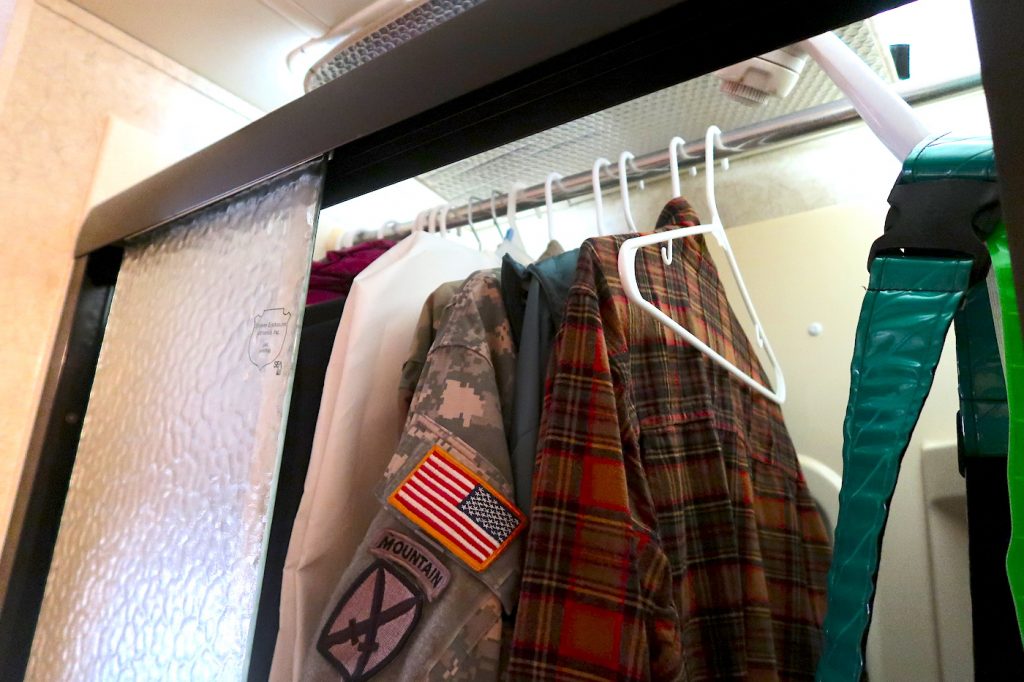
2. Keep things in place with bungee cords and tension rods.
These little guys are very functional for RVing. Use the cords to secure cabinets and semi-loose items in the bathroom, kitchen and refrigerator during travel days.
Tension rods can be used to secure canned goods, hang curtains or even make a shelf.
3. Command hooks — hang everything!
For Rvers, command hooks may just be the best thing since sliced bread! They can be used to help you with just about any storage problem in the RV.
Use them to hang your cooking utensils, towels, coats or just about anything else you can think of. They’re even a great alternative for hanging up pictures — forget drilling into your RV!
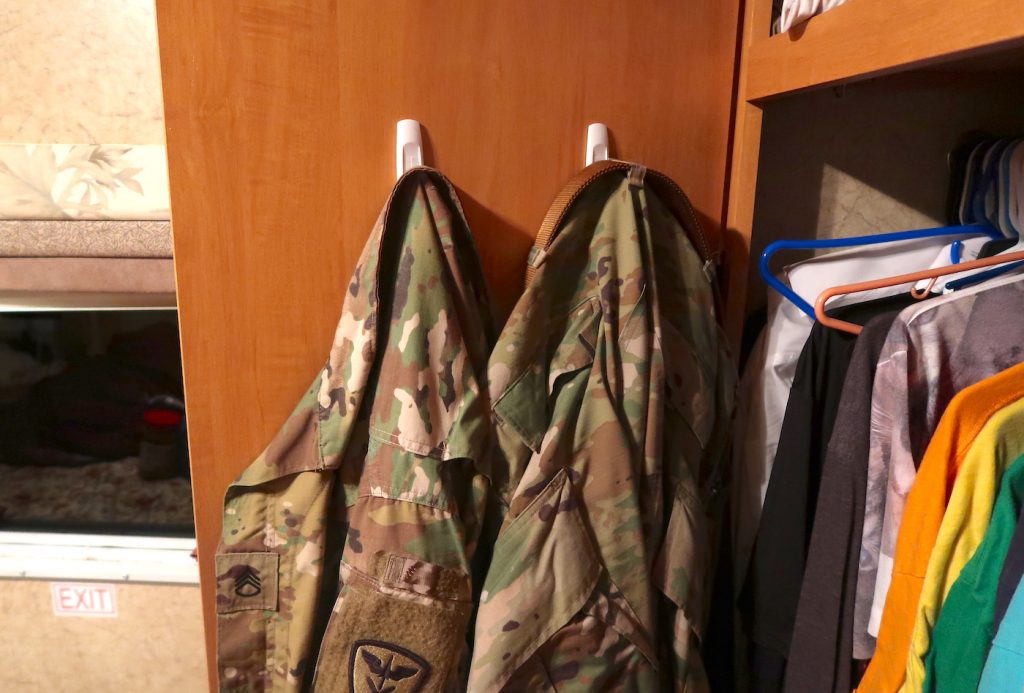
4. Store kitchen supplies in file folder boxes.
Have too many kitchen supplies and not enough drawer or cabinet space? Use hanging file folder boxes to organize and quickly access kitchen supplies.
5. Get a suction-cup toothbrush holder.
Travel days can be hard. Make them easier by keeping your toothbrush secure. A toothbrush holder with a suction cup will ensure that your toothbrush stays safe and germ-free all the way to your next destination.
6. Nesting ware is your friend.
Nesting bowls and spoons are an all-around win for the RV. They can also double as toys for the kids!

7. Utilize the oven!
The oven is prime real estate for just about anything that needs to be kept close at hand. When it’s not being used, of course!
Editor’s Note: No seriously, make sure that oven is turned OFF. And be sure to check that it’s empty before switching it on.
Temperature Control:
8. use styrofoam..
Covering the door window in your RV is a great way to get some extra privacy and temperature control. A simple method is to cut a piece of styrofoam to size, then tape it to the window. Voila!
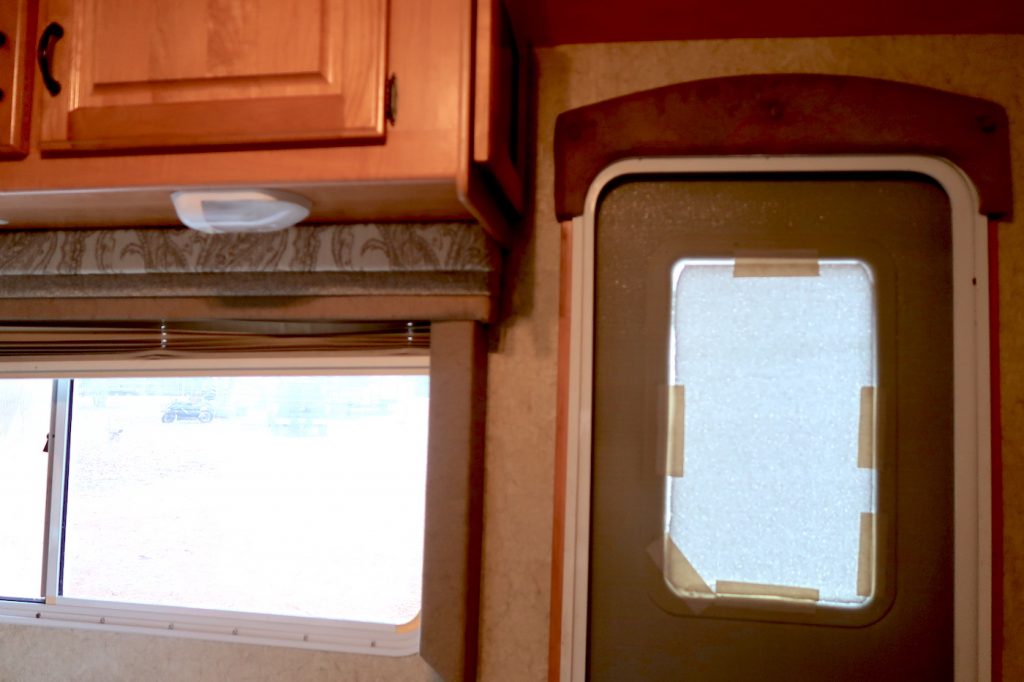
9. Put a ceramic tile in the oven to distribute heat evenly.
Oven not cooperating? Place a ceramic tile in the center of the RV oven and presto! The perfect recipe becomes the perfect dinner!
10. Buy a vent cushion.
Because RVs are not insulated like houses, temperature can be harder to regulate. A vent cushion is a small investment that goes a long way. This is especially true if you are staying in a park that charges for electricity, or if you use propane to heat your rig in the winter.
You can find them in the RV section of most superstores.
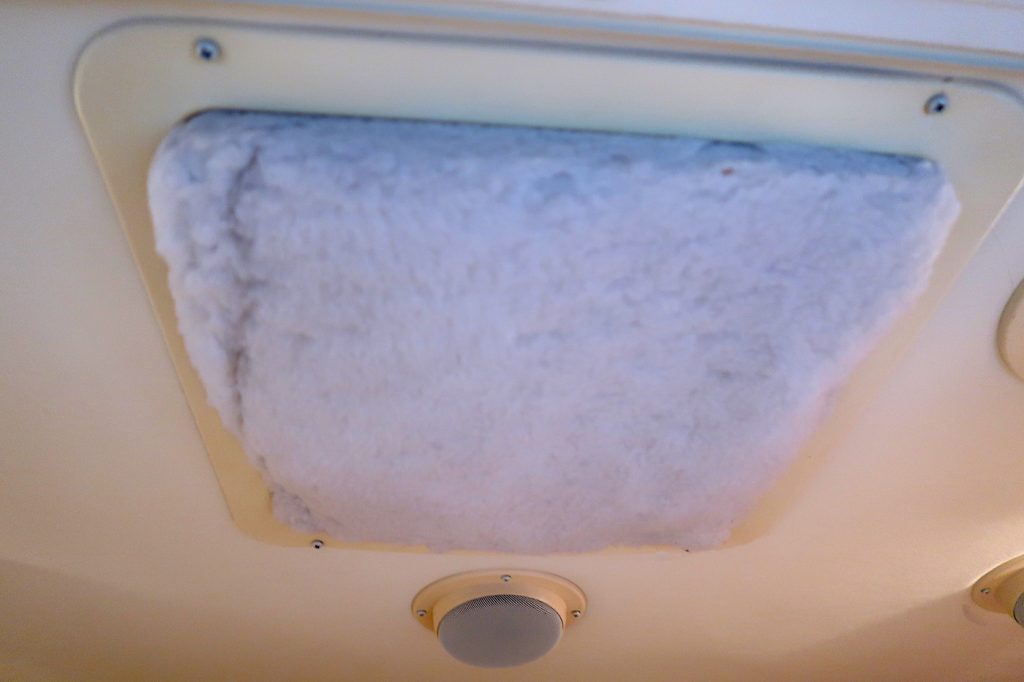
11. Create bright light with a five-gallon bucket
Let there be light! Place a cheap work light in a five-gallon bucket around your the campsite for a bright glow. around your the campground site.
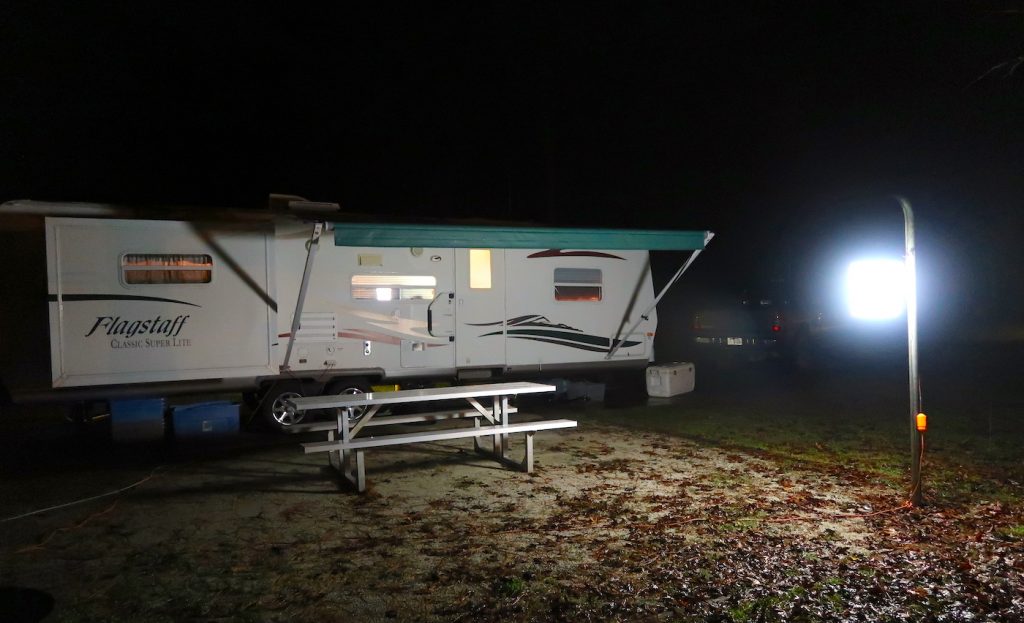
12. Add light and ambience with LED lights.
Add LED lights to the living room, your bedroom slide or along the stairs of your rig for a little extra light and personality.
13. Install push lights.
The lights in many RVs tend to be rather yellow, which isn’t ideal at night. Install a few push lights in dimly lit corners and cabinets. This will help with nighttime chores — and late night snacking.
14. Stick glow-in-the dark tape on the stairs.
RV steps are not known for their stability. At night it can be tricky getting in and out of your camper. Adding strips of glow-in-the-dark tape to the stairs is a quick and easy solution.
Decorating:
15. upholster with crib sheets..
Want to give your RV a mini-makeover without all the hard work? Cover dinette couch cushions with crib sheets. Change them out periodically for a fresh look.
Add a matching tablecloth and some fun salt and pepper shakers and give your RV a whole new vibe!
16. Use adhesive window film for privacy and style.
A bit of decorative window film can really improve and personalize a small space. It also adds a welcome touch of privacy.
17. Buy a digital photo frame.
Love having your family photos up but feel like there isn’t enough wall space in your camper? Try a digital photo frame with all your favorite pictures on rotation. It’s a space-saver and a great conversation piece!
For Everything Else:
18. use the community center.
Community centers are the hidden gems of RV parks and campgrounds. Use them when you’re in need of privacy, open space or a comfortable couch and some pixel-free TV. Many even include sinks, refrigerators, microwaves and wifi!
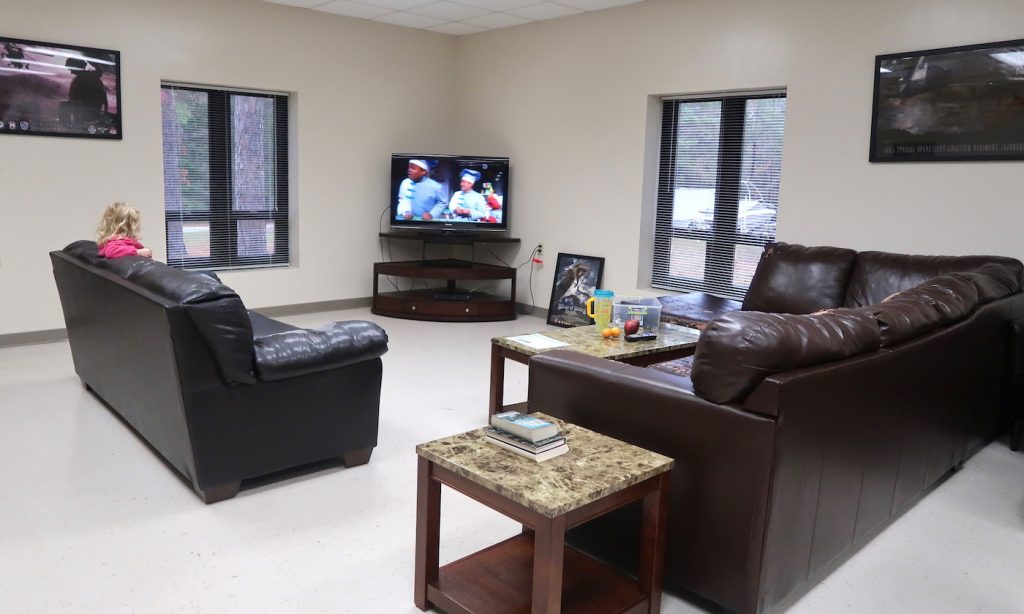
Not Using Your RV?
Don’t let all your clever hacks go to waste! Rent your RV on Campanda and start earning.
Click Here To Rent Your RV
You May Also Like

Jeffsetter Travel
Travel Consultants and Travel Tips
9 Best Class C RVs In 2023
May 8, 2022 by August Croft
Last updated on October 30th, 2023 at 06:52 am
All of our reviews are based on exhaustive research, industry experience and whenever possible, hands-on testing. When you make a purchase using one of our chosen links we’ll receive a small percentage of the proceeds. This supports the site and keeps Jeffsetter running. You can read more here .
If you’re shopping for a new RV, you may be wondering what some of the best Class C RVs are on the market today. Are you familiar with Class C RVs , or are you brand new to the buying process? There’s a lot to consider, and you should be prepared!
In this article, we’ll address everything you need to know about Class C RVs, including what they are and worthwhile considerations to make before purchasing one. Finally, we’ll go over our top picks for some of the latest and greatest RVs on the market today.
Only interested in exploring our comprehensive list of Class C RVs? Use the table of contents below to jump ahead!
What Is A Class C RV?
Class C RVs are often considered the Goldilocks of recreational motor homes. They are in between the large and lengthy Class As , as well as the compact camper van Class Bs . Class C RVs come in traditional gasoline fuel as well as diesel, depending on your preferences. But what makes them so special?
One of the main selling points of any Class C RV is the fact that it’s easier to drive than any towable rig, and most Class A RVs, given their long length. Class C RVs average anywhere from 20-40 feet long, making them ideal for a large swathe of the population. Some Class C RVs are larger than this and are powered by huge diesel engines. These are known as Super Cs, and they have grown in popularity over the past ten years.
These large rigs are ideal for full-timers, larger groups, and people interested in towing using their Class C. Another selling feature of a Class C RV is the overhead bunk offered by all makes and models. This bunk hovers over the driver and passenger seat of the RV, offering additional storage or sleeping solutions for larger families.
Not only do Class Cs give RVers a fantastically sized rig that’s a breeze to drive, but there are also tons of Class C RVs on the market to choose from. They are extremely popular, so you’ll likely find a perfect rig for you, whether it’s on our list or not!
What To Consider In A Class C RV?
Whether you’re a seasoned RV owner or simply brand new and want to learn a bit about Class C RVs, there are several things to think about before jumping into a Class C RV purchase. Giving plenty of thought to things like floorplans, boondocking ability, price, and more, will help you make the best decision for you and your family so you won’t be needing a new rig any time soon!
The type of layout you’re looking for in a Class C RV is arguably one of the most important considerations to make. This can be a little tricky, however, if you haven’t even stepped inside a Class C, as it can be difficult to imagine what the space will feel like. Thankfully, many RV websites offer extensive layout and floor plan tours so you can get a true feel for an RV without ever seeing it in person if you so choose.
Some manufacturers have 3D tours, or it may even be possible to set up a video call with a local RV dealership and explore the camper in that way. There are many Class C layouts, though there are only so many ways you can arrange such a small living space. When you consider storage as well as room for all of your RV utilities, most Class C RVs aren’t reinventing the wheel here!
This isn’t to say the majority of Class C RV floor plans aren’t impressive, well-appointed and thought out with camping and storage in mind. On the contrary! The majority of Class Cs are innovative and ideal for many people.
You may already know that you want a dedicated master bedroom with a walk-around bed, or perhaps you’re hoping for multiple bunk beds to sleep your family of five . No matter what you’re looking for, there’s a floor plan suitable- it just might take some time to find your favorite option!
Just like any major purchase, you should have a good idea of your budget before you start shopping for a Class C RV. It’s rare to find any type of motorhome for less than $100k, though there are some Class Cs that hit this benchmark. Nevertheless, the average price of most Class C RVs is anywhere from $100k-$400k, depending on features, finishes, and upgrade options.
There are many ways to budget for a Class C RV, including avoiding rigs billed as luxury rigs . Most RV manufacturers offer standard features or standard-built RVs, alongside luxury RVs. With a more luxurious build comes a higher price tag, so this is something to keep in mind if you’re sticking to a rigid budget. Another thing to mention is that the listed purchase price of most RVs is not the price you’ll end up paying.
There are often many desirable non-standard features offered by RV manufacturers that you may want to include in your rig, and these extras can increase the end figure substantially. Some of these add-ons include solar panels, generators, added towing capacity, and more.
It all depends on the individual make and model of RV you’re looking at. Some RV manufacturers include a lot of great features standard, though others do not. Narrow down your list of must-haves as well as your budget before shopping, as this will help speed up the process!
Number Of Travelers
Before making any Class C RV purchase, you need to know how many travelers you anticipate coming on board. Most Class Cs are not the largest motorhomes out there, and they comfortably sleep an average of 2 to 5 people. There are always exceptions to this rule, and layouts to suit families of all sizes do exist, it’s just a matter of finding them!
One important thing to consider when it comes to the number of travelers you bring with you is how many seat belts are on board your Class C RV. Most RVs have two seat belts guaranteed , but some RV manufacturers stop there. You may find bench seating with additional seat belts in some makes and models, so keep an eye out for these if you know you’ll be driving with multiple people in the RV.
Boondocking Ability
Also known as dry camping, boondocking is the concept of camping off-grid or otherwise disconnected from all RV utilities, including water, electricity, and sewer. Class C RVs are fantastic for boondocking given their size and maneuverability. Many people enjoy taking their Class Cs off-road and off-grid, and many RV manufacturers have built their rigs accordingly.
You may find that the majority of Class C RVs, even some of our best Class C RVs on this list, have standard boondocking features included in the initial purchase price. If boondocking is something you’re interested in, it’s wise to keep these features in mind. Some popular boondocking RV accessories and features include:
- Solar panels
- Onboard generators
- Additional batteries built for boondocking
- Larger holding tanks, including fresh and gray water
- Energy-efficient appliances to maximize off-grid power
- Four or All-wheel drive for reaching remote locations!
Again, this may not be something that interests you, especially considering that all RVs are built to be disconnected from power sources for a brief period. However, if you know you’re an adventurer at heart and crave the freedom that boondocking allows, I recommend looking for Class C RVs offering several boondocking features.
Luxury Finishes
We already touched briefly on the concept of a luxury Class C RV, but let’s discuss luxury finishes in a bit more detail. You may be surprised as you begin your RV search at the interior design and overall quality of some RVs versus others. Unless they are billed as luxury rigs, many RVs can feel a bit bland and understated.
While it’s possible to add your own character to an RV, finding a rig with a number of luxury finishes and features is something to consider to truly feel the wow factor. Additionally, luxurious finishes and RVs typically come backed with extra warranties and support from the manufacturer. Essentially, you get what you pay for, but it’s whether or not you can afford it!
Some popular luxury finishes include:
- Theater seating in the living area
- Upgraded kitchen, including large residential fridge and dishwasher
- Power lift bed in the master suite
- Frameless windows and other energy-efficient perks
- Additional AC units or ducted heating
- Electric tongue jacks and stabilizers
Luxury RVs also tend to feel more elegant in their interior design. Whether it be the color palette or the fabrics used in the upholstery, you can typically tell the difference between a standard RV and a luxury one. This is something to think about as you shop!
A long-standing debate in the RV community is the fuel type of motorhomes. Class C RVs either have a traditional gasoline engine or a diesel engine. But what are the pros and cons of both?
Many longtime RV experts stand by diesel engines , especially when it comes to Class As and Class Cs. The reason for this is because diesel fuel is less expensive overall compared to traditional gasoline fuel. If you truly want to use your RV and save a bit of money, many RVers recommend going with diesel fuel.
The trade-off, however, is that most diesel-fuel Class C RVs have a higher initial purchase price compared to gasoline-powered Class C RVs. Further, the majority of diesel-fuel RVs have a level of luxury and personal touch not offered in gasoline-fuel RVs. This is not always the case, especially if you choose to customize your gasoline-powered RV to your heart’s content.
Ultimately, it’s up to you which fuel type suits your lifestyle best. You may find that a gasoline RV works well for you, given the fact that you only use it a few times during the RV season. However, if you are a full-timer or plan on using your rig generously, a diesel engine may suit you best.
Towing Capacity
The final consideration while shopping for a Class C RV is the overall towing capacity offered by many RVs these days. It may surprise you to hear, but towing a car or boat behind your Class C RV is extremely popular and easier than you think. You need to keep in mind, however, just how heavy your car or boat is before purchasing your Class C RV.
Many campers choose to tow a residential vehicle behind their Class C RV because it allows them to park their rig at camp and drive a typical car around, offering enhanced maneuverability and comfort in that respect. Additionally, if you’re adventurous and have a lot of other recreational toys such as boats and ATVs , you can likely tow them with your Class C RV.
While it may take a bit more math and you might need to weigh your residential vehicle or boat, you need to know how much you plan on towing before making a final purchase. Class C RVs can tow more than you expect, especially if you end up purchasing a Super C RV powered by a diesel engine. Keep this in mind if you know you want to tow with your class C!
Feeling confident about everything you need to consider before making a Class C RV purchase? Do you know what layout may suit you and your family best? Let’s take a look at our list of the 9 Best Class C RVs, popular and brand new for 2023!
Best Overall: Jayco Melbourne
- Interior Height : 6′ 11″
- MSRP : $164,093
- Exterior Length : 25′ 2″
- Exterior Height : 11′ 5″
There are many reasons why the Jayco Melbourne takes our best overall spot. It’s compact and easy to drive, perfect for small groups of people, and has an affordable price, making it a great starter rig for beginners and a well-equipped RV for the pros. Built on a Mercedes-Benz chassis and powered by a diesel fuel engine, the Jayco Melbourne is fuel-efficient and capable of towing up to 5,000 pounds.
Priced just under $165k, I love being able to bring all of my gear along for the adventure, and at a fair price point. There are only 3 floorplans to choose from which isn’t quite the variety I like to see with RVs, however, each layout is unique and can sleep either 4 or 5 people. Jayco is one of many RV manufacturers that set RVers up for success through their standard and optional features.
The Melbourne can be outfitted with solar panels, an on-board generator, and additional AC which are all ideal boondocking features! Despite only being 25 feet long, the Melbourne impresses me with its thoughtfully designed interior and volume of storage throughout.
The kitchen catches my eye too, as it’s impressively spacious, despite it not being as large as a residential one. Overall, this rig packs a punch with internal and external features, and it’s a Class C able to cater to a variety of RVers.
- Mercedes-Benz chassis and diesel engine
- Affordable price
- Range of standard and optional features
- May not be large enough for big groups of people
- Only 3 floorplans
Best Starter Rig: Jayco Redhawk SE
- Interior Height : 7′
- MSRP : $121,718
- Exterior Length : 24′ 8″ – 30′ 3″
- Exterior Height : 11′ 6″
The Jayco Redhawk SE takes the second spot on our list as the best starter Class C RV. This rig is perfect for those just starting out since it’s budget-friendly, modest in length, has 2 chassis options, and 3 floorplans. Ranging in length from just under 25′ to a speck over 30′, it’s possible to tailor the Redhawk SE to individual needs and capabilities.
Both the Chevrolet and Ford chassis’ are known for being reliable and durable, which is exactly what I need from an RV, especially since I live on the road full-time! Having confidence in the rig I’m driving makes such a difference, so features like hill-start assist, and cruise control bring comfort and ease to this Jayco rig. While I’m impressed by the standard features of the Redhawk SE, the exterior and interior aesthetics lack options.
It’s also a little disappointing that features like solar power and hydraulic leveling jacks aren’t standard options as it means the end price will be significantly higher. Having solar power is something I simply couldn’t be without, so this is an investment would make in a heartbeat, even if it hikes the price up!
Beginner RVers may not be interested in adding extras to the Redhawk SE, and since solar prep is included, it’s simple to add panels as and when you’re ready. The interior design lets this Jayco rig down a little, but with some imagination and personal touches, the Redhawk SE is a great Class C RV choice.
- Excellent price
- Well-built Jayco frame and walls
- Multiple floor plans
- Different chassis options
- Bland interior
- Sleeps a maximum of 5 people
Best On A Budget: Winnebago Minnie Winnie
- Interior Height : 6′ 10″
- MSRP : $139,912
- Exterior Length : 23′ 10″ – 32′ 9″
- Exterior Height : 11′
While it isn’t the cheapest option on this list, the Winnebago Minnie Winnie starts at just under $140k, making it within a Class C RV budget range. This RV has 6 possible floor plans, sleeping anywhere from 5-8 people. Varying in length from 23 feet to 32 feet, the Minnie Winnie is a fantastic RV for the average family as well as a large group of friends.
Given the number of floor plans, I like that I can choose the exact layout to suit me best, including choosing a bigger kitchen versus a larger bathroom, or a master suite and a spacious dining area. While there isn’t any solar or solar prep included standard, I can have an on-board generator as part of the electrical system. This is handy for going off-grid, and to make things even easier, Winnebago has created the Minnie Winnie with towing in mind.
This Class C is capable of towing up to 7,500 pounds, which is more than enough for the average car or boat. I love the freedom of bringing additional toys and gear along for the ride, and the Minnie Winnie is more than capable of securely towing extras. The only downside of this Class C RV is the interior design which lacks personality, but it’s just waiting for a bit of unique touch and home decor.
There are 3 color combinations to choose from to help prevent a dull interior, and the windows throughout help keep the space light and airy. No matter what, the kitchen feels spacious and well-equipped, the bedroom feels cozy, and the living area seats everyone for a movie night!
- Budget-friendly price point
- Multiple floor plans and different lengths
- Creative kitchen and living arrangements
- Interior design is a bit basic
- Some floorplans have small black and gray tanks
Best For Boondocking: Winnebago Ekko
- Interior Height : 6′ 8″
- MSRP : $207,707
- Exterior Length : 23′
- Exterior Height : 10′ 6″
As I mentioned previously, Winnebago has included several boondocking accessories and perks in their RVs over the last few years, and the Winnebago Ekko reflects these Innovations better than most of the company’s RVs! Powered by a 3.5L EcoBoost V6 engine with 400lb-ft of torque, this is a camper able to get to any destination. Matched with a 4WD system, adaptive cruise control, driver alert, and more, the Ekko is an innovative Class C RV built for any adventurer.
The Winnebago Ekko isn’t the biggest Class C ever, and it certainly doesn’t have the range of floorplans and lengths as some of the other rigs I mentioned earlier. The Ekko does, however, pack a punch in terms of off-grid features, and comfort isn’t forgotten about either! It’s designed to go wherever I plan on setting off to, and I know I’m covered with 3 solar panels boasting 455W of solar, a second alternator for charging batteries, and standard lithium-ion batteries for electrical efficiency.
Having solar on an RV is a game-changer, as it means I can stay powered even when I’m not plugged in at the campground. With a 50-gallon fresh water tank, I know I have enough to last a few days of cooking, washing, and drinking, allowing me to truly immerse myself in nature and not be too concerned with limiting my water consumption.
Measuring 23′ in length, the Ekko is easy to drive, maneuver, and park, but it may not be large enough to cater to families or travel groups. There’s only a single floorplan to choose from which is disappointing, as I prefer to have a variety of layouts to explore and find the one that suits me best. The floorplan is creative and uses the space well, but it would be nice to see a few more options in the future.
Winnebago states that the Ekko is designed to sleep four people, but I think it’s better suited to two or maybe three people as otherwise it can feel cramped inside. Some may see this as a disadvantage, but I believe it’s one of the reasons why this RV stays so maneuverable and energy-efficient while boondocking: it isn’t designed to carry an entire group of friends!
Not only is this RV equipped with double the amount of solar compared to other standard solar setups, but it also features a heated garage bay underneath the rig to store cargo and gear. Plus, this Class C RV also has insulation for all four seasons, making it a capable RV for just about anywhere I can imagine.
- Optional pop top
- Heated storage underneath the rig
- Compact Class C RV
- Only 1 floorplan
Best For Large Families: Dynamax Isata 5
- MSRP : $283,350
- Exterior Length : 31′ 2″ – 35′ 11″
- Exterior Height : 12′ 4″
Finding an RV suitable for large families can be quite a task, but the Dynamax Isata 5 makes things a breeze. The Isata 5 has 3 floorplans to choose from, and built on a reliable Cummins diesel engine, this is a luxury Class C RV made to last. Ranging in length from 31′ – 35′, this Class C is impressive, both inside and out. It features a number of interior design options, which helps transform this wagon into a comfortable space where the whole family can thrive!
This Dynamax can fit a king bed, along with theater seating, and a kitchen of dreams. Everything has been thought about – there’s even a residential-sized fridge and oven so I can make food for a number of people without any stress. I like that along with a few floorplan options, there’s an additional Xplorer package for RVers intending on spending considerable time off-grid.
The package includes dual-paned windows, extra house batteries, solar panels, and heated underbelly options . In a perfect world, the Isata 5 would come standard with these outstanding features, but at least there’s the option to upgrade and add them on! The only drawback of this Dynamax is the price point, as it’s pretty high for a Class C motor.
Although this rig has a hefty price tag, it’s clear to see why. The luxury throughout is stunning, and the high-quality finish makes this RV feel more like a traditional house than a potential home on wheels! All in all, this is a rig ideal for large families not looking to leave comfort behind when they head out on vacation.
- Multiple lengths
- Powerful diesel engine
- Range of optional features
- High price point
Most Luxurious: Newmar Super Star
- MSRP : $494,740
- Exterior Length : 37′ 11″ – 40′ 11″
- Exterior Height : 13′
Continuing with grand Class Cs, the Newmar Super Star is arguably the most luxurious rig on our list, and it’s also the most expensive! starts at $422k. The Super Star takes our most luxurious spot because of its unique interior design, abundance of standard features, and the smooth ride it offers everyone on board. This Super Star Class C motorcoach is available in 6 distinctive floor plans, ranging in length from 37′ – 40′, making this a big rig!
Larger Class C RVs are typically harder to drive and park, so this is something to consider, especially for winter storage. While some RVers may prefer a smaller Class C RV, the Newmar Super Star offers ample room for everyone to sleep, thanks to the king bed, dinette, and hideaway sleeping sofa.
It’s easy to forget you’re in an RV while touring any of Newmar’s RVs. They are extremely comfortable and intelligently laid out, with storage and unique touches throughout that aren’t found in many other RVs. Some of these features include detailed wood inlays and colorful tile backsplashes, making the bathrooms and kitchens feel similar to familiar residential bathrooms and kitchens.
There’s no denying this Newmar is a stunning RV, but this does mean it has a high price tag. It’s so high, in fact, that this rig likely isn’t an achievable option for many RVers. The innovative floorplans and high-end finish of this Super Star mean you truly get what you pay for, it’s just a case of having a big budget!
- Stunning design throughout
- Powerful diesel engine with a high towing capacity
- Multiple floorplans
- High price tag
- Harder to drive due to the length
Best Diesel Fuel: Tiffin Wayfarer
- Interior Height : 6′ 6″
- MSRP : $211,873
- Exterior Length : 25′ 8″
- Exterior Height : 11′ 4″
The Tiffin Wayfarer manages to make it onto just about all of our best Class C RV list articles and for good reason! It packs a lot of fantastic features into a compact and easy-to-drive frame and is priced fairly too. With 4 floorplans to explore, all below 26′ long, the Tiffin is an ideal diesel fuel Class C RV for any kind of RVer.
Built on a comprehensive and reliable Mercedes-Benz chassis, I love that this rig is stress-free to drive, and is enhanced by technologically-advanced features as it means I feel safe and secure in a variety of road conditions and weather scenarios.
Along with being functional, the Tiffin Wayfarer offers a range of interior design swatches and colors, allowing me to create an RV I can love and enjoy for many years to come.
This Class C RV has a tasteful interior design, across each of the floorplans which is a refreshing contrast to commonly found dull RV interiors. The kitchen is spacious and well-equipped, and I love having the choice of a large bathroom and a comfortable living area, as it means I don’t have to sacrifice the things I enjoy most.
I know some people who have been able to live full-time in their Tiffin Wayfarer and love it. It’s an extremely versatile rig at a fair price, though it is a bit of an investment for those with a lower budget.
However, Tiffin offers some warranty programs as well as customer service, making it a reliable rig for years to come. They also have a great reputation in the industry with plenty of positive reviews .
- Easy-to-drive compact frame
- Fair price point
- Multiple floorplans
- Tall people may struggle with the interior height
Best For Full-Timers: Entegra Coach Accolade
- MSRP : $332,693
- Exterior Length : 39′ 4″
- Exterior Height : 13′ 4″
Living full-time in an RV is a lot of fun, and RVers with a healthy budget will fall in love with the Entegra Coach Accolade . This RV is large enough to be considered a Super C RV and is built on a powerful chassis powered by a reliable diesel engine. The Accolade truly feels like a home away from home, and this is all thanks to the luxury finish and range of features within.
This Class C RV has 3 available floorplans, many of which offer optional laundry facilities for those hoping to live in this rig. The interior design is elegant and luxurious yet the Accolade doesn’t feel unapproachable or unlived in. With a length of 39′ 4″, it’s no secret that this is a large RV, in fact, it may even be too big for beginners hitting the road for the first time .
Inside this stunning Entegra Coach is a stainless steel kitchen, electric fireplace, spacious master bedroom with wardrobes, and an inviting bathroom. Plus, given the powerful diesel engine, there’s enough towing capacity for just about any recreational vehicle, car, or boat.
Like our other high-end Class C options, the only catch with the Accolade is the price! At over $300k, this is one expensive rig, but with beautiful design and plenty of functionality, it’s not hard to see why.
Opting for additional features lets RVers have the freedom to create an RV that’s matched perfectly. Additional options will bump the end price up even more, so be sure to work out a budget before heading to a dealership!
- Large and spacious interior
- Ideal full-time living features
- Diesel engine with a high towing capacity
- Slideouts will require additional maintenance
- Expensive
Runner-Up: Thor Four Winds
- MSRP : $116,700
- Exterior Length : 24′ 1″ – 32′ 8″
- Exterior Height : 11′ 0″ – 11′ 2″
Our honorable mention Class C RV is the Thor Four Winds . This RV is fantastic for sleeping up to seven individuals, and it ranges from 24′ to 32′ so I can opt for the rig I’m most comfortable driving and spending time in. One of the main reasons this RV is awesome for a great number of people is the fact that it has 12 different floor plans – it’s impossible not to find one to love!
Along with the wide variety of floorplan options, I also like that I’m able to choose between a few different interior design choices. As a more budget-friendly rig, the Four Winds isn’t as luxurious as other Class C options such as those from Entegra and Newmar, but it’s still a pleasant, functional interior. A personal touch and homely features are all that’s needed to make the interior of this Thor motor brighter.
I’m particularly impressed by the exterior features of this Class C RV, as I like to spend as much time outside as possible, and this is easy in the Four Winds. With a sizeable storage compartment, patio awning , LED lighting, and even an exterior entertainment system, the entire family can make the most of summer and relax outside.
All in all, this Class C RV is budget-friendly, versatile, and comfortable, with a vast range of features everyone will enjoy on vacation. It may not be the best-looking rig on our list, but for smaller budgets, it’s a great RV option able to tackle many adventures in the wilderness.
- Variety of floorplans
- Budget-friendly
- Not a luxury option
- Bland interior
Final Thoughts
Finding a Class C RV to suit your family and lifestyle is easier than you think with a bit of research! With so many options on the market today, you should have no trouble finding a camper that works for your budget, family, and camping needs. All you need to do is take a tour, have a test drive, and hit the open road in one of the best Class C RVs of 2023!
Important Links
- Advertising Policy and Affiliate Disclaimer
- Privacy Policy
- Contact Jeffsetter Travel Blog
- Ask Jeffsetter a Question
Recent Posts
- Bilt Dropped Hawaiian as a Transfer Partner
- Hawai’i Hotel Workers Say Strike is Imminent
- Chillest Shave Ice
- Hula Cookies Ice Cream Sandwiches
- Review: Restaurant Marlow Maui

- Books & Merch
- Gear We Use
- National & State Parks
- Best RV Campgrounds in New Hampshire
- Best RV Campgrounds in NC Mountains
- Best Florida Beach RV Campgrounds
- South Dakota
- The Great Lakes
- Campers Swear By This Portable Device That Keeps Dogs Safe -The Best Portable Dog Fence for Camping (2024)
- Mosquitos and bugs
- Camping Clothes
- Camping Gifts
- Camping Internet
- 5 Best RV Backup Cameras for RV & Trailer
- 7 Best Screen Tents for Camping (2024)
- Best RV Campgrounds in California
- 5 Best Key West RV Parks
- 9 Best RV Campgrounds in New Jersey
- Camping Reservations
- Campground Comparisons
- Cheap or FREE RV Camping Sites
- Best RV Campground Memberships & Clubs
- Boondocking 101
- Boondocking Adventures
- RV Internet
- What Do Flamingos and Upside Down Pineapples Mean?
- Where to Find FREE or Cheap RV Sites Camping
- RV Winter Camping
- RV Show List for 2024
- 17 Best Camper Vans 2024 (New Class B RVs Available!)
17 Steps for QUICK RV Setup at a Campground
Rv setup at a campground for newbies can be a daunting experience those first few times. here's a very helpful checklist for you….
- 1 RV setup at a campground for newbies can be a daunting experience those first few times. Here's a very helpful checklist for you…
- 2 1) RV setup – Getting a site
- 3 2) RV setup – Choosing a site
- 4 3) RV setup – Backing in
- 5 4) RV setup – Look Up
- 6 5) RV setup – Set the emergency brake
- 7 6) RV setup – Hook up Electricity
- 8 7) RV setup – Hook up the water
- 9 8) RV setup – Coil your cables and wires
- 10 9) RV setup – Plug in the cable TV
- 11 10) RV setup – Level your RV
- 12 11) RV setup – Turn on the hot water heater
- 13 12) RV setup – Secure your pet
- 14 13) RV setup – Put out the awning
- 15 14) RV setup – Put down a ground cover
- 16 15) RV setup – Tend to your trash
- 17 16) RV setup – Activate the step override
- 18 17) RV setup – Know where you are
- 19 43 Dumbest RV Camping Mistakes: DON’T DO THIS!
- 20 Mike and Jennifer Wendland's Yellowstone Travel Guide
Many times, we're in a Class C RV, so the things we do and the order in which we do them may differ for you if you are in something different.
But generally, whatever kind of RV you have, these RV setup steps at a campground should be very applicable.
If you'd rather see than read, here's a video on how we do our RV setup . If you'd rather read, scroll down for our 17 written RV setup tips, which you can use as a checklist.
Like what you see in these videos? We'd appreciate it if you would Subscribe to our YouTube Channel ( easy to do right here ) and consider “ringing the bell icon” to be notified of any new video from us. 🙂 Thanks!
If you buy something through our links, we may get a small commission at no extra cost to you. It helps keep our lights on so we can continue to provide helpful resources for RVers. Read our full affiliate disclosure here.
1) RV setup – Getting a site
These days, reservations are often required. But we seldom get one ourselves. And almost always we get a spot. The best day to snag an unreserved campsite is Sunday, just after noon.
That's when many of the weekenders have pulled out. If we're out west at one of the popular National Park campgrounds or one near a top tourist attraction, we'll show up as soon as the office opens in the morning. We see if we can get one for someone leaving later that day or to grab a cancellation site.

2) RV setup – Choosing a site
We look for one with afternoon shade. In the morning, the sun is great. But in summer and early fall, the afternoon sun can be brutally hot.
While we do put often out an awning, we try to have it and as much of the site outside our door shaded in the afternoon. Also, pick a campsite not too close to your neighbor's firepit.
And if you burn a campfire yourself, depending on the prevailing wind, see if you can get a site so that campfire ring doesn't fill your RV with your own smoke.
3) RV setup – Backing in
Have a spotter. Jennifer always goes to the back of the campsite and makes sure I can see her in the side mirror. She uses hand signals to direct me in, making sure I don't hit a tree or the picnic table or drive into the aforementioned firepit.
But, yes, using Jennifer as a spotter arose from previous experiences. We also recommend checking out our article “Backing Up an RV” Learner’s Kit: Everything You Need .

4) RV setup – Look Up
If you see dead branches overhead, you should not camp under them. Even a small limb that falls from any distance can do a lot of damage to you or your RV.
5) RV setup – Set the emergency brake
Always, always do this as soon as you are in place on the site before you do the rest of the RV setup steps.
6) RV setup – Hook up Electricity
Our RV runs on 30 amp shore power. Plug the electrical cord into the 30 amp receptacle. If there is only a 50 amp plug and you have an adapter, you can use it.
Check the breakers above the plug. Flip the breaker on for the plug you are using. Our RV has a surge protector built-in. If yours doesn't, I recommend you get one to go between the power cord and the pedestal.
In older campgrounds, there are a lot of pedestals with bad connections that can damage your RV's electrical system and your appliances. We recommend the Southwire Surge Guard, model 34930 .
When you plug in the other end of the cord to the shore connector on the RV, lock it in place. With ours, it's a turn to the right. We also have a locking wheel on the plug to make it seven more secure. See the video for an example.
7) RV setup – Hook up the water
We recommend always using a water filter between the spigot and the freshwater hose that connects to your RV. We use a relatively new system called Clear20 that consists of an inline water filter and the Dirtguard pre-filter that takes out the sediment and particulates before they go through the inline filter.
The filtration medium difference is the way the water is filtered. The cheaper and more common inline RV water filter we used to buy used powdered charcoal. The Clear2o RV water filter system uses solid charcoal.
And that leads to the efficiency of the filtering. The cheap carbon powder filters screen out particulates and sediment down to about 20 microns. The solid Clear2o inline RV water filter system screens those particulates down to 1 micron. It makes the star cleaner, clearer and it taste better.
When it comes time to connect your hose to the RV, use a Fresh water quick disconnect. This solves the problem of having to thread and tighten the connectors by hand, something that had to be lined up just so and always seems to result in an annoying little leak. The quick disconnect takes seconds, it snaps on and off instantly and is totally leak-free. You can get them at any RV shop or Amazon at https://amzn.to/2YUAEG7

8) RV setup – Coil your cables and wires
Don't leave your wires and cables all jumbled up. Coil them. It looks much nicer. Besides, if you keep them coiled, they'll “train” themselves to stay that way when you wind them up and put them away.
9) RV setup – Plug in the cable TV
If your campground offers cable TV, connect it up. We also see quick cable connect adapters for the cable.
10) RV setup – Level your RV
I did a video a few weeks ago about how much we love our automatic leveling system . We wouldn't have an RV without one and it was the very first extra we had installed when we get our new RV earlier this summer. If you don't have one, use a level inside the RV and put little blocks under the wheels to get the unit as level as possible.
11) RV setup – Turn on the hot water heater
Some units need time to warm the water. Others are instantly hot. Whatever, when you want hot water, you want it then. So turn it on as soon as you can after arriving.
12) RV setup – Secure your pet
If you have a pet, how will you be able to keep them restrained and secure? Small dogs can be kept in portable pens. Larger dogs need to be on a leash or rope. We tie Bo to a picnic table, a tree, or, more often than not, the rear trailer hitch ( see the video ).
13) RV setup – Put out the awning
We use our awning a lot in the summer. But do not trust the weather. Sudden winds can do real havoc on awnings and are extremely costly to repair. We never leave ours out overnight, no matter what the weather forecast is. And we don't leave it out when we will be away from the campsite on a hike or bike ride that lasts over a couple of hours.
14) RV setup – Put down a ground cover
Whether your RV is on a poured cement pad, asphalt, gravel, dirt, or sand, a cover cuts down on the amount of mud and dirt you bring inside. You may also want to use a smaller piece of carpet or an outdoor mat just outside the door ( again, see our video ).
If you can, take off your shoes or boots before going inside the RV. Whatever you do, don’t leave them outside and unattended for long periods of time or overnight. Unpleasant things like mice, spiders, and scorpions can make themselves a new home.
15) RV setup – Tend to your trash
Be sure to know where the trash can be disposed of. Some campgrounds pick it up each morning. Others expect you to take it to a garbage bin or dumpster. But don’t leave trash lying around either inside or outside the RV.
16) RV setup – Activate the step override
The center step on RVs automatically extends and retracts every time you open and close the RV door. That's why most RVs have a step override that turns off the automatic setting and keeps the step out. Don't worry, if you forget to turn it off when you are breaking camp, it will retract as soon as you start the engine.
17) RV setup – Know where you are
Finally, one thing we always do inside the RV before kicking back and having fun is to write down the official name of the campground, the office phone number, and our site number. Usually, we do this on those sticky PostIt notes. In an emergency, if you have to call 911 for assistance, you want to be able to quickly and accurately say where you are.
43 Dumbest RV Camping Mistakes: DON’T DO THIS!
Recently, an RV Lifestyle member asked a question in our Facebook group:
“What are the dumbest RV camping mistakes you see all the time? (I don’t want to be one of THOSE guys!).”
Her question elicited more than 440 comments ! Like I said, we have all made mistakes.
The good news is that we can laugh about some of the dumb things we have done. The bad news is that some mistakes may cost you time or money, or both! Keep reading…
Mike and Jennifer Wendland's Yellowstone Travel Guide

At the top of every RVers bucket list, it is a place so majestic, so wild, and so big that it calls us to return, to explore, to get to know the diversity of its land and animals over and over again.
Everywhere you look are waterfalls, fast-moving rivers, geysers, sheer rock faces, towering lodgepole pines , all framed by mountains under the bright blue cloudless sky.
It’s spectacular for those who love the wilderness and getting up close and personal with it. Enjoy Yellowstone for RV travel.
Published on 2024-03-07
Mike Wendland is a multiple Emmy-award-winning Journalist, Podcaster, YouTuber, and Blogger, who has traveled with his wife, Jennifer, all over North America in an RV, sharing adventures and reviewing RV, Camping, Outdoor, Travel and Tech Gear for the past 12 years. They are leading industry experts in RV living and have written 18 travel books.
11 Responses to “17 Steps for QUICK RV Setup at a Campground”
October 21, 2020at12:19 pm , Bryson Owens said:
I love your advice to make sure you have a spotter that is always helping you back out safely. My partner and I want to get a new RV this year so that we can start traveling more. We want to be comfortable during our travels so a nice RV is essential.
October 05, 2020at2:38 pm , Essential Tips for RV Dry Camping, Boondocking and Dispersed Camping [WITH VIDEO} - RVing Outdoors said:
[…] CLICK HERE to read the article 17 quick steps for setting up at an RV campground. […]
October 05, 2020at10:51 am , Essential Tips for RV Dry Camping, Boondocking and Dispersed Camping [WITH VIDEO} | RV Lifestyle said:
August 18, 2020at12:09 pm , zdjęcia said:
Hi, i think that i noticed you visited my site so i came to return the want?.I’m attempting to in finding issues to improve my website!I suppose its good enough to make use of some of your ideas!!
August 05, 2020at11:30 pm , RILEY said:
Informative article as always. Glad you are using the Clear2O. Me too, I have been using the Clear2O RV inline filter for over a year and I bought the Dirtguard about a month ago at CampingWorld. So far so good and it’s conveniently size to fit in my travel trailer.
August 03, 2020at4:12 pm , Rick Filcoff W0RCF said:
Very nice article! Additional suggestions: 1. I believe a very important additional electrical safety device is a non-contact voltage tester, such as the Klein Tools NCVT-2, available for around $20 on Amazon ( https://www.amazon.com/Klein-Tools-NCVT-2-Standard-Protection/dp/B004FXJOQO/ref=sr_1_3?dchild=1&keywords=NCVT&qid=1596485213&sr=8-3 ) is a very important safety device, especially if one does not have an EMS (such as Progressive Industries EMS-PT30X), but even if one does have and use an EMS. 2. Connect your RV to the campground pedestal via an Electrical management System (“EMS”). 3. Sunshades, with silver side out, in your windows to keep out heat in the summer or silver side in to keep heat in during cold weather. 4. Say hello to and thank the campground host(s) for their service.
August 02, 2020at7:42 pm , Kathy Hardcastle said:
Great video and helpful hints. Thank for sharing your insight.
August 02, 2020at10:45 am , Dave said:
Excellent article and companion video. I really enjoy your content! Thank for taking the time to share with us all.
August 01, 2020at9:51 pm , Mike said:
Great tips thank you! Is it safest to turn off all breakers first before touching the box? I thought I had read that, and to first plug into your RV then do the plug in to the proper receptacle last and then turn the correct breaker on.
August 01, 2020at9:13 pm , Mike Wendland said:
Yes, we just picked up a pair and plan tp do the same!
August 01, 2020at4:23 pm , Jeff said:
My wife and I use walkie talkies to backup our camper.
Leave a Reply Cancel reply
Your email address will not be published. Required fields are marked *
Related Posts

Stay Cool! 9 RV Air Conditioner Maintenance Tips

7 Great RV Kitchen Gadgets to Save Space

Best Camping Saw: Top 10 Picks for RVers & Campers (2024)
Forget all the nastiness of Facebook.
We built the forums in our RV Lifestyle Community completely off Facebook.
No rude comments. No Nastiness.
Just friendly RVers who love to help.
CLICK here to see for yourself!

IMAGES
COMMENTS
Plug your directions into the GPS, put on your favorite playlist, and enjoy the ride! Lizzie Dragon, Outdoorsy Author. $250 /night. $83 /night. $70 /night. $275 /night. $240 /night. Never having driven an RV before, the first trip can be intimidating, but don't fret! We have some tips for your Class C travels.
Have a well-stocked first-aid kit with kid-friendly medications, such as pain relievers and antihistamines, to address any minor health issues that may arise. 36. Prioritize Safety: Safe & Sound. While safety is always important when RV traveling, when there are kids on board it becomes even more important.
10. Keep safe distance between vehicle ahead. When you are driving the motorhome at high speeds make sure you are behind the vehicle in front of with a gap of at-least one similar rv or more. This is necessary because the bigger class c rv will take time to stop when you apply break.
Leveling your RV before filling your tank will ensure that you are really getting a full tank. 4. Mount towel bars (and other things) on your walls with exterior grade Gorilla mounting tape. adheres to RV walls much better than Command strips or anything else we've found. 5.
Size matters in RVing, and with Class C RVs generally ranging from 20 to 40 feet, understanding their dimensions is vital. It informs everything from choosing the right campsite to safely navigating city streets and highways. A Class C RV's functionality lies in its clever use of space, with sleeping, cooking, and bathroom facilities neatly ...
New Motorhomes. Price: Expect to pay anywhere from $90,000 to over $300,000. Price varies based on features and upgrades. Condition: Sparkling new, with the latest technology and no wear and tear. Warranty: Comes with a manufacturer's warranty for peace of mind. Used Motorhomes.
No one likes broken dishes or watching their belongings fly across a highway. And if your Class C has slides, make sure the slides are in before you try to leave! Like with any car, it's always a good idea to check your tire pressure and fluid levels before a trip. Make sure, during your safety check, to confirm your husband is in the RV.
If you're new to RVing and don't feel comfortable driving in windy conditions, consider waiting for a better day. Even experienced drivers might want to delay travel in winds exceeding 50-60 mph, as Class C motorhomes can flip in such strong winds. Hopefully, this guide helps boost your confidence when driving a Class C in the wind.
Lazydays offers the top selection of RV brands in the country, which means we're likely to have whatever brand you're looking for. When you visit a Lazydays location in Florida, Arizona or Colorado, you can choose from popular Class C RV brands like Winnebago, Dynamax, Forest River, Thor Motor Coach and more.
2. Make a plan that matches your budget. The three most expensive line items for an RV road trip are gas, campground fees, and food. All three of these can vary dramatically depending on the type of road trip you plan. Knowing your RV or tow vehicle MPG will help you plan a route that doesn't break the bank.
Another travel tip many seasoned RVers employ is to take breaks often during your drive time. Just a 10-minute break to stretch your legs, go to the restroom, and get a snack, will make the drive time more relaxing. Additionally, I would advise you to eat a light lunch. Don't skip it.
The primary distinction between a Class C and a Class A motorhomes lies in their size. Class C RVs are generally shorter in length and height compared to their Class A counterparts. This compact size offers several advantages for Class C motorhome owners. Firstly, it allows for greater maneuverability, making it easier to navigate through tight ...
These diesel pullers are able to compete very well with the top of the line Class A diesel pushers. Therein lies the problem when talking about a specific class of RV and aftermarket purchasing decisions. Cargo Carrying Capacity on this wide variety of Class Cs can range from over 20,000 lbs to under 500 lbs.
5. Jayco Melbourne Prestige. The 2023 Jayco Melbourne Prestige takes the Best Class C RV in luxury to a whole new level with an upgraded premium Mercedes-Benz 3500 chassis and runs on diesel. The Class C RV sleeps up to five, and its exterior length is 25'2". It retails starting at $192,993, featuring a GVWR of 10,030 pounds, and a GCWR of 15,250 pounds.
They can range from around 25 feet to 45 feet, and come in both gas and diesel models. Below is a walk-through video of our first RV. Class C: When you think of a classic motorhome, you probably think of a Class C RV. They have the cab-over bunk bed or storage and are built on a truck chassis, usually Chevy or Ford.
This Class C RV—built on a Ford E-450 chassis—sleeps five people in its 24' interior. With a slide-out to accommodate a queen bed and a sizable cabover bunk, the Freedom Elite proves why Thor is one of the best Class C RV brands. Pros: Full bathroom. Dream dinette.
Most people who own Class C motorhomes travel with their family or spouse. Many are casual campers looking to unwind and relax. Since there is ample sleeping space in these RVs, it's easy to get away for a weekend with family or friends. Class C RVs are also popular for cross-country trips because they have abundant amenities and plenty of ...
Length: 25 feet 7 in. Fuel Type: Diesel. Stop onlookers on their tracks and as you drive these sharp, stylish Tiffin 2021 Wayfarer class C RVs on the road as if it's the red carpet! These Class C RVs feature an amazing hydraulic leveling system while all running on the Mercedes Sprinter chassis.
8. Use styrofoam. Covering the door window in your RV is a great way to get some extra privacy and temperature control. A simple method is to cut a piece of styrofoam to size, then tape it to the window. Voila! 9. Put a ceramic tile in the oven to distribute heat evenly.
MSRP: $104, 018. GVWR: 14,500 lbs. The Jayco brand is well-known in the off-season RV community and the Redhawk 26XD is a big favorite of mine, being built on a powerful and reliable Ford chassis. Life on the road in winter can be tough, and I find if I don't prepare for cold temperatures, RV life can be pretty hard.
MSRP: $121,718. Exterior Length: 24′ 8″ - 30′ 3″. Exterior Height: 11′ 6″. The Jayco Redhawk SE takes the second spot on our list as the best starter Class C RV. This rig is perfect for those just starting out since it's budget-friendly, modest in length, has 2 chassis options, and 3 floorplans.
6) RV setup - Hook up Electricity. Our RV runs on 30 amp shore power. Plug the electrical cord into the 30 amp receptacle. If there is only a 50 amp plug and you have an adapter, you can use it. Check the breakers above the plug. Flip the breaker on for the plug you are using. Our RV has a surge protector built-in.
Choosing between Class A and Class C motorhomes depends on your travel needs, family size, and budget, as each offers unique advantages tailored to different RV lifestyles. ... RVezy pro tip: 12 Simple Tips for Driving Large RVs. When it comes to towing capacity, both classes offer reliable options, but the choice often depends on individual ...
Thor Outlaw 29J Class C RV For Winter. Photo Credit: Thor Motorcoach. Dimensions: 31′ 2″ L, 10′ 10″ H. Black/Gray/Fresh Water: 30/34/40 gal. Amenities: Swivel TV in cab-over portion, patio deck/toy hauler section, queen-size drop-down bunk, two sofa beds, removable pedestal tables, exterior TV.